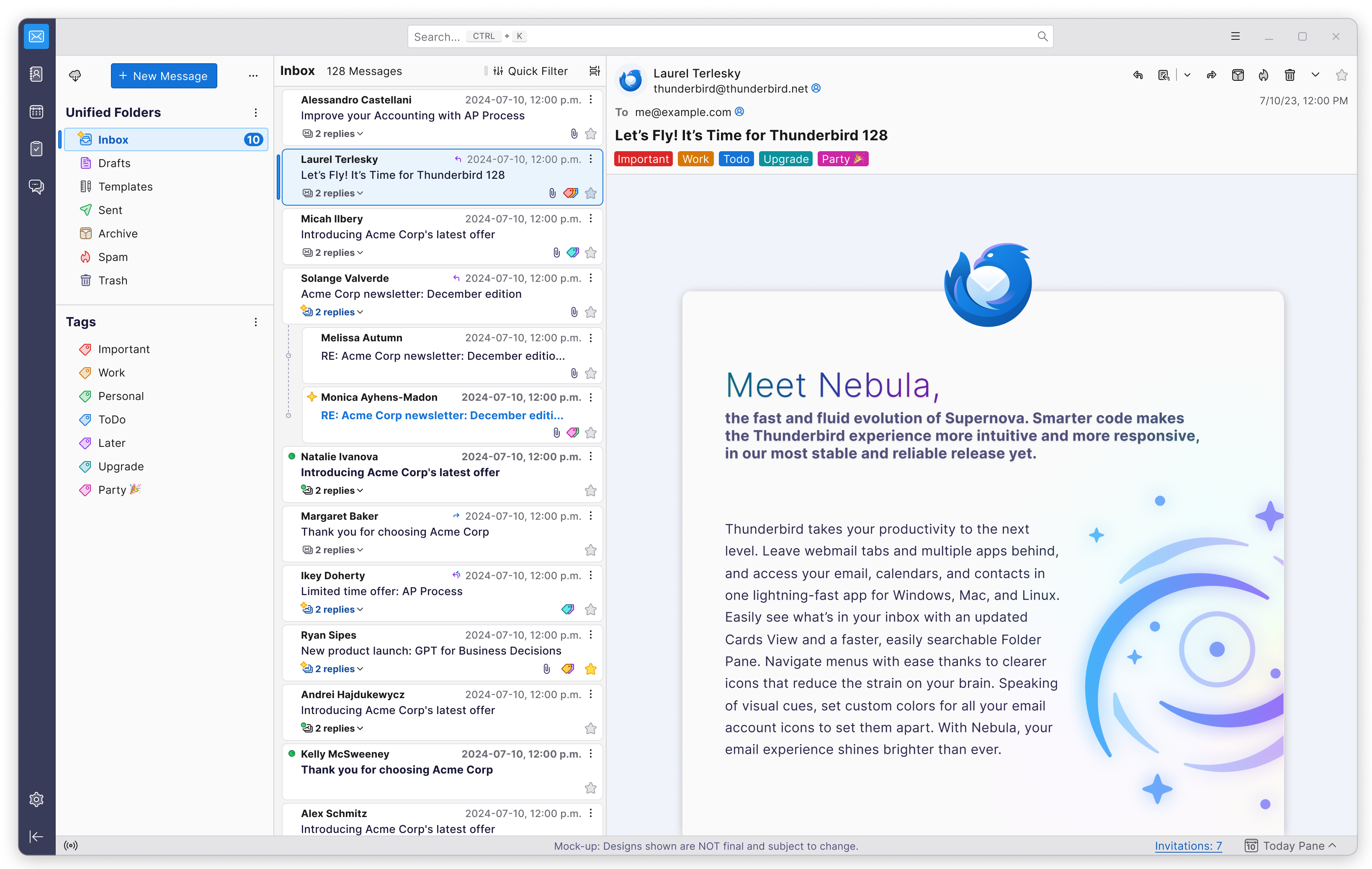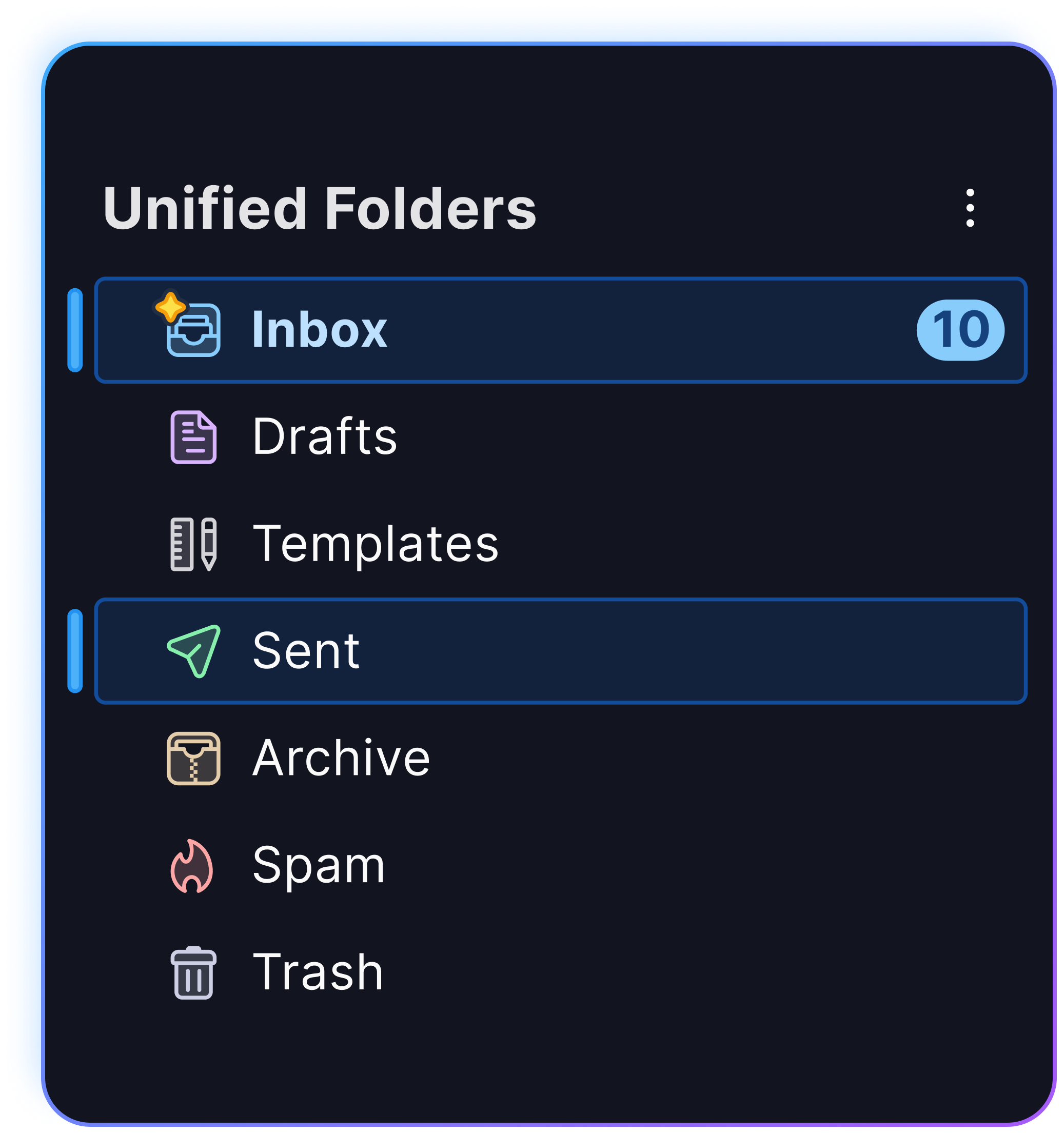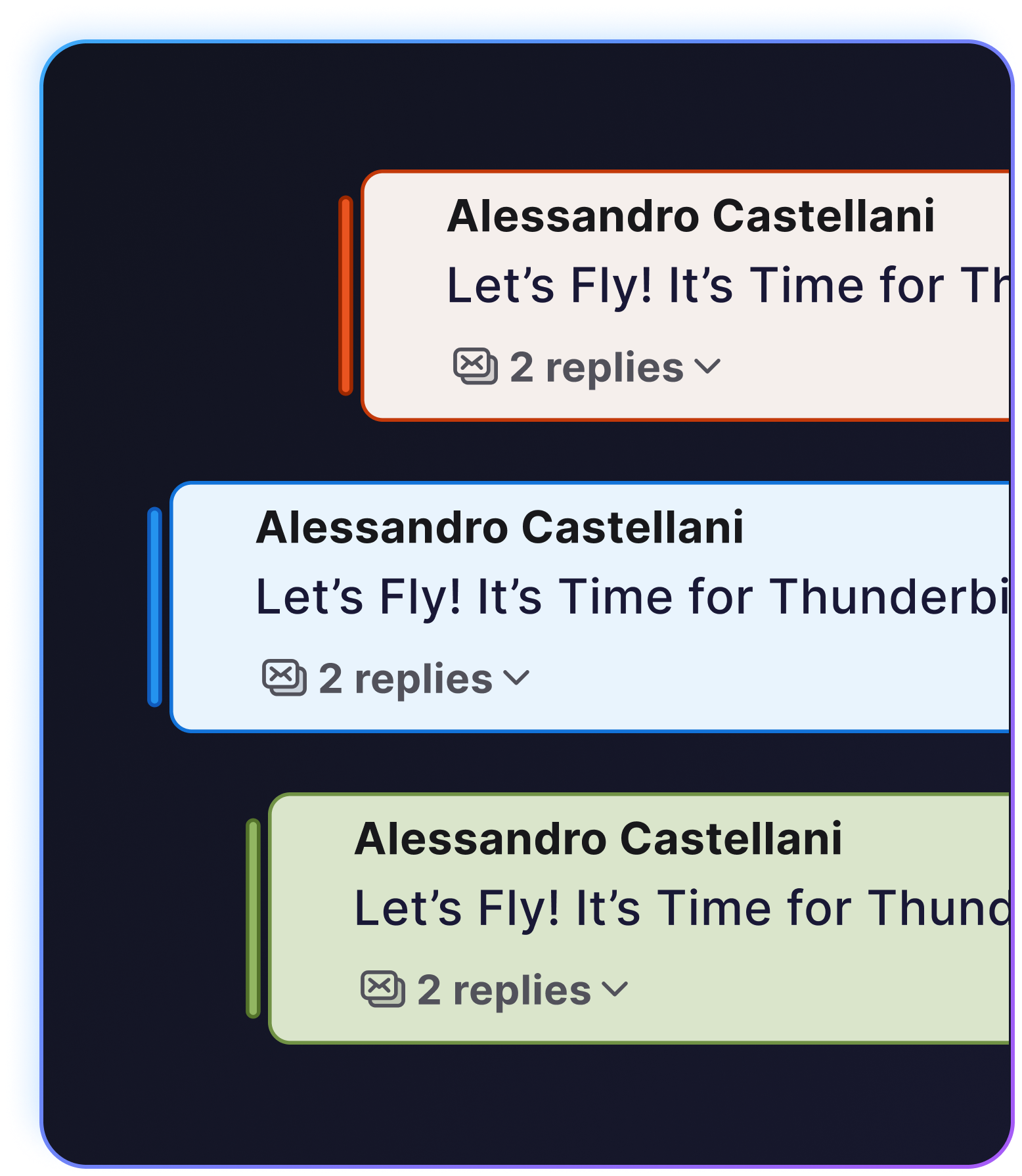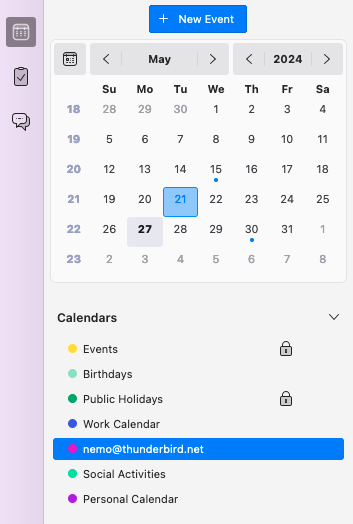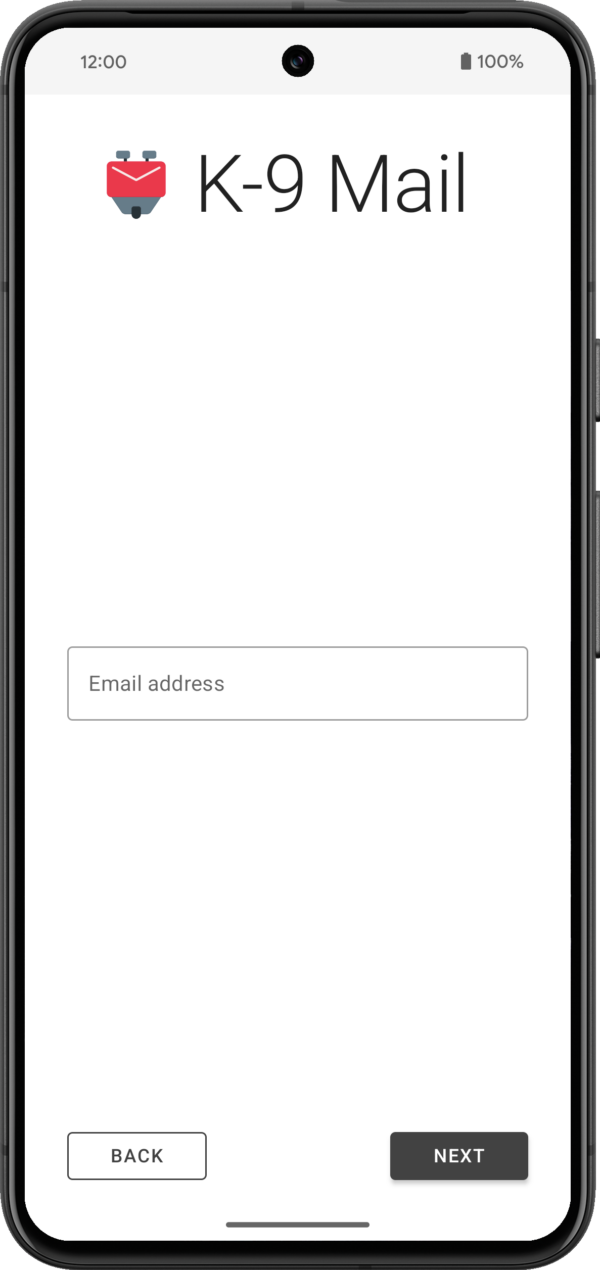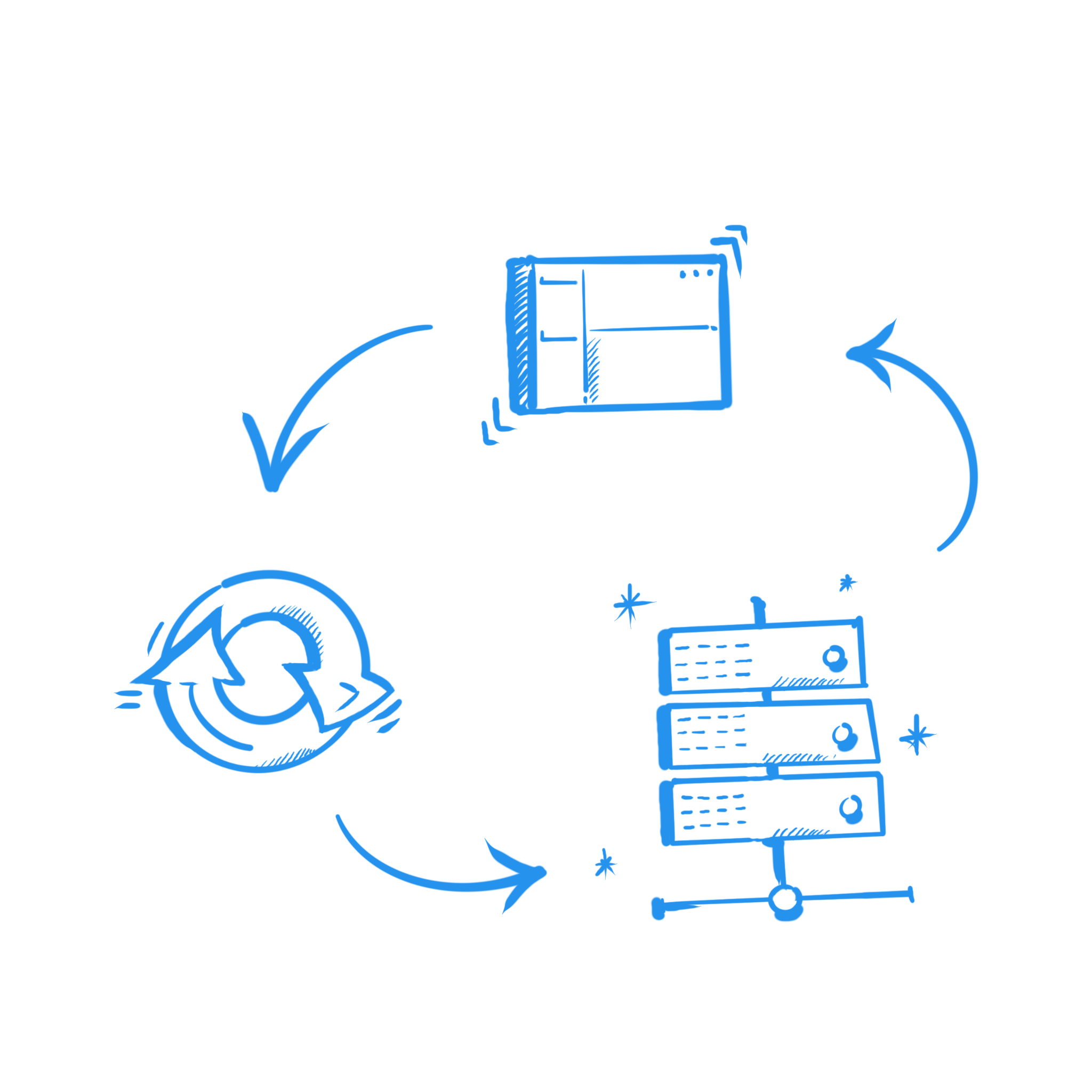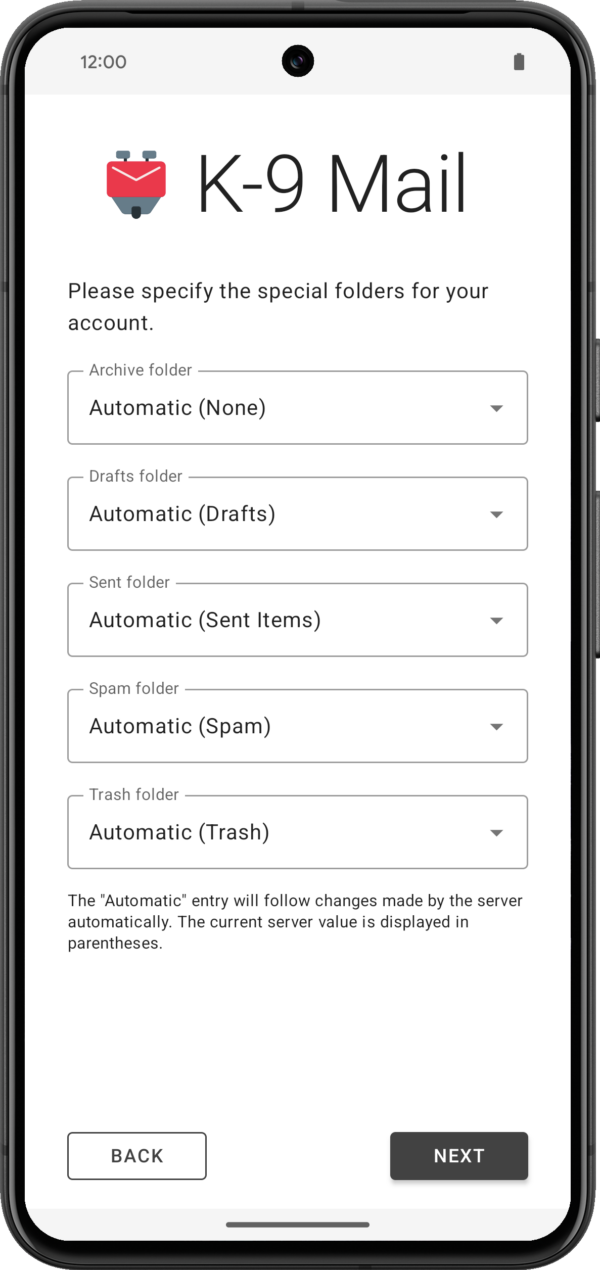The post Maximize Your Day: Make Important Messages Stand Out with Filters appeared first on The Thunderbird Blog.
]]>
For the past two decades, I’ve been trying to get on Jeopardy. This is harder than answering a Final Jeopardy question in your toughest subject. Roughly a tenth of people who take the exam get invited to auditions, and only a tenth of those who make it to auditions make it to the Contestant Pool and into the show. During this time, there are two emails you DON’T want to miss: the first saying you made it to auditions, and the second that you’re in the Contestant Pool. (This second email comes with your contestant form, and yes, I have my short, fun anecdotes to share with host Ken Jennings ready to go.)
The next time I audition, reader, I am eliminating refreshing my inbox every five minutes. Instead, I’ll use Thunderbird Filters to make any emails from the Jeopardy Contestant department STAND OUT.
Whether you’re hoping to be called up for a game show, waiting on important life news, or otherwise needing to be alert, Thunderbird is here to help you out.
Make Important Messages Stand Out with Filters
Most of our previous posts have focused on cleaning out your inbox. Now, in addition to showing you how Thunderbird can clear visual and mental clutter out of the way, we’re using filters to make important messages stand out.
- Click the Application menu button, then Tools. followed by Message Filters.
- Click New. A Filter Rules dialog box will appear.
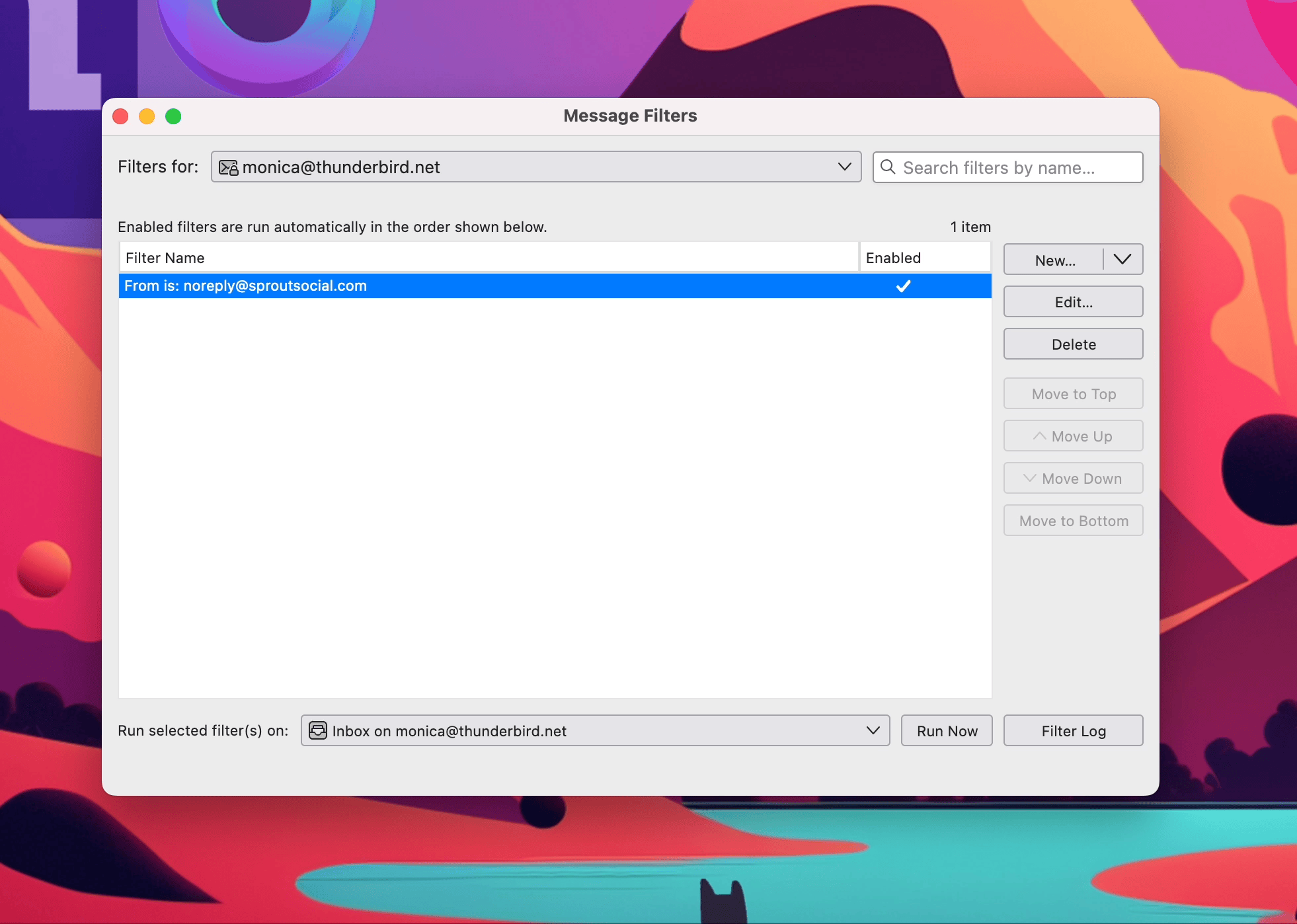
- In the “Filter Name” field, type a name for your filter.
- Under “Apply filter when”, check one of the options or both. (You probably won’t want to change from the default “Getting New Mail” and “Manually Run” options.)
- In the “Getting New Mail: ” dropdown menu, choose either Filter before Junk Classification or Filter after Junk Classification. (As for me, I’m choosing Filter before Junk Classification. Just in case)
- Choose a property, a test and a value for each rule you want to apply:
- A property is a message element or characteristic such as “Subject” or “From”
- A test is a check on the property, such as “contains” or “is in my address book”
- A value completes the test with a specific detail, such as an email address or keyword
- Choose one or more actions for messages that meet those criteria. (For extra caution, I put THREE actions on my sample filter. You might only need one!)
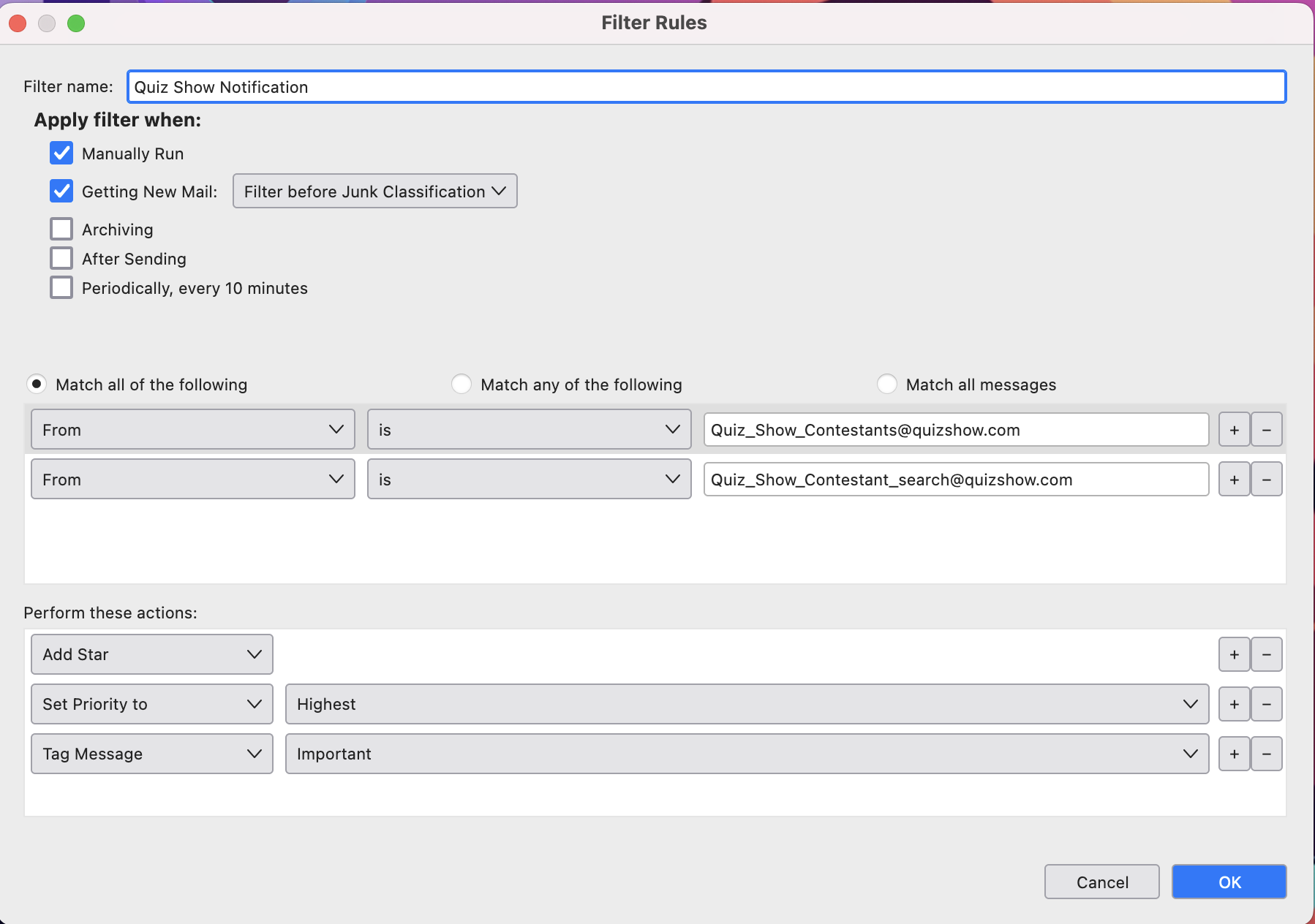
Find (and Filter) Your Important Messages
Thunderbird also lets you create a filter directly from a message. Say you’re organizing your inbox and you see a message you don’t want to miss in the future. Highlight the email, and click on the Message menu button. Scroll down to and click on ‘Create Filter from Message.’ This will open a New Filter window, automatically filled with the sender’s address. Add any other properties, tests, or values, as above. Choose your actions, name your filter, and ta-da! Your new filter will help you know when that next important email arrives.
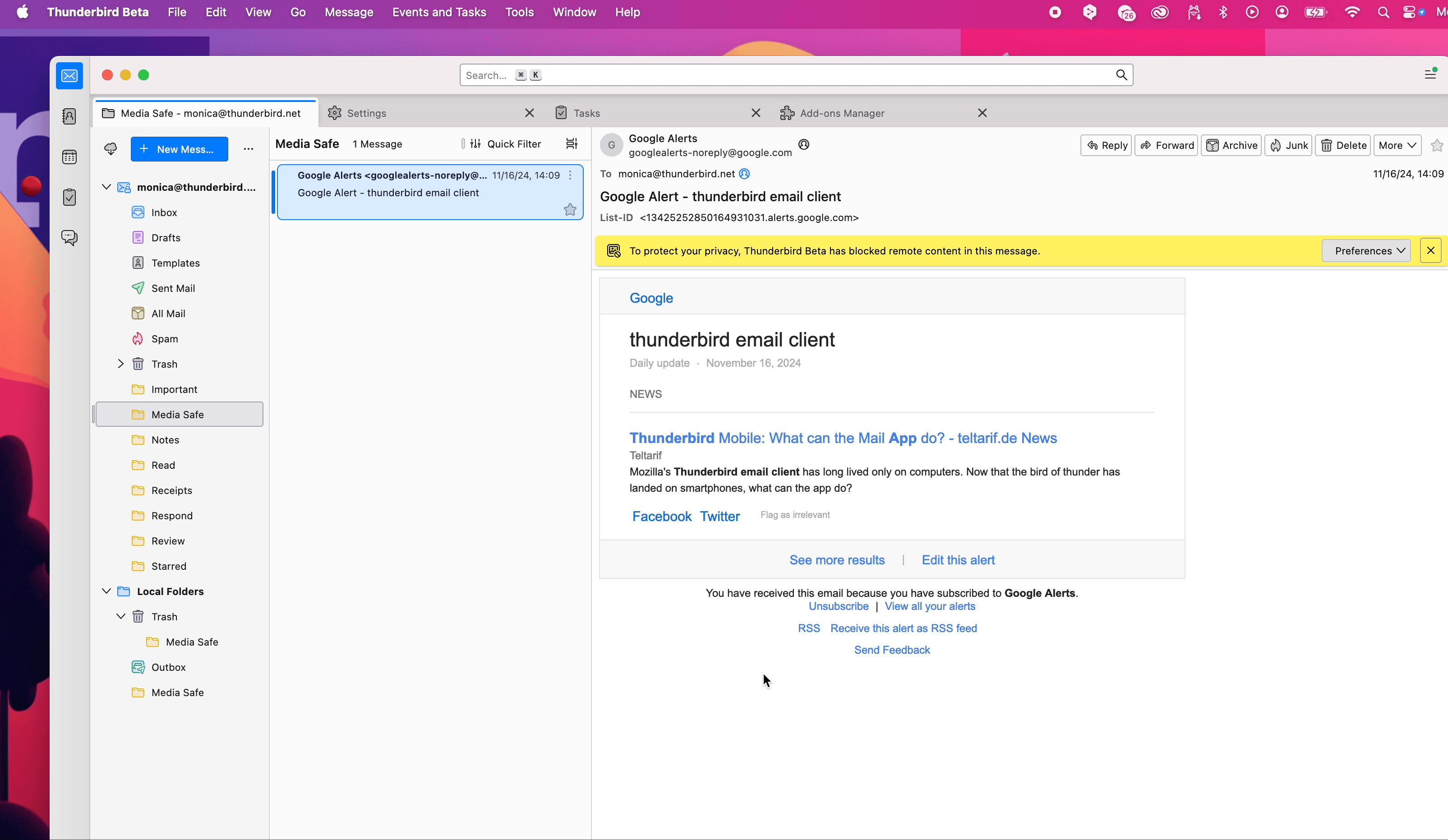
Resources
As with last month’s article, this post was inspired by a Mastodon post (sadly, this one was deleted, but thank you, original poster!). Many thanks to our amazing Knowledge Base writers at Mozilla Support who wrote our guide to filters. Also, thanks to Martin Brinkmann and his ghacks website for this and many other helpful Thunderbird guides!
Getting Started with Filters Mozilla Support article: https://support.mozilla.org/en-US/kb/organize-your-messages-using-filters
How to Make Important Messages Stick Out in Thunderbird: https://www.ghacks.net/2022/12/02/how-to-make-important-emails-stick-out-in-thunderbird/
The post Maximize Your Day: Make Important Messages Stand Out with Filters appeared first on The Thunderbird Blog.
]]>The post VIDEO: Q&A with Mark Surman appeared first on The Thunderbird Blog.
]]>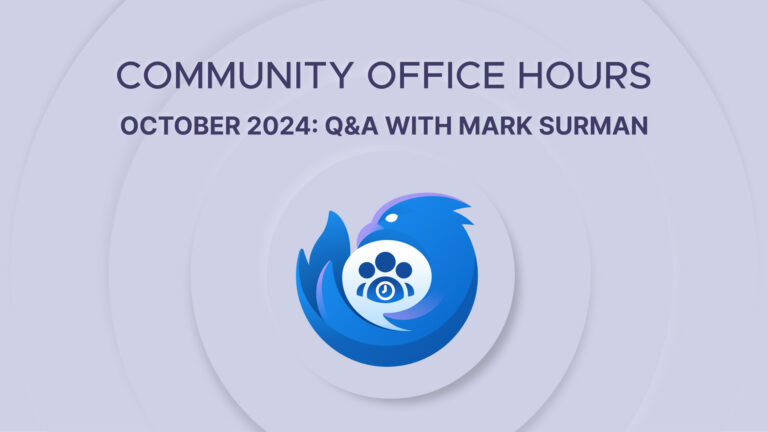
Last month we had a great chat with two members of the Thunderbird Council, our community governance body. This month, we’re looking at the relationship between Thunderbird and our parent organization, MZLA, and the broader Mozilla Foundation. We couldn’t think of a better way to do this than sitting down for a Q&A with Mark Surman, president of the Mozilla Foundation.
We’d love to hear your suggestions for topics or guests for the Thunderbird Community Office Hours! You can always send them to officehours@thunderbird.org.
October Office Hours: Q&A with Mark Surman
In many ways, last month’s office hours was a perfect lead-in to this month’s, as our community and Mozilla have been big parts of the Thunderbird Story. Even though this year marks 20 years since Thunderbird 1.0, Thunderbird started as ‘Minotaur’ alongside ‘Phoenix,’ the original name for Firefox, in 2003. Heather, Monica, and Mark all discuss Thunderbird’s now decades-long journey, but this chat isn’t just about our past. We talk about what we hope is a a long future, and how and where we can lead the way.
If you’ve been a long-time user of Thunderbird, or are curious about how Thunderbird, MZLA, and the Mozilla Foundation all relate to each other, this video is for you.
Watch, Read, and Get Involved
We’re so grateful to Mark for joining us, and turning an invite during a chat at Mozweek into reality! We hope this video gives a richer context to Thunderbird’s past as it highlights one of the main characters in our long story.
VIDEO (Also on Peertube):
Thunderbird and Mozilla Resources:
- Want to know more about the history of Thunderbird? Ryan Sipes, our product director, describes it in a compelling tale: https://blog.thunderbird.net/2023/11/the-untold-history-of-thunderbird
- Want to keep current with Mark and the rest of the Mozilla Foundation? Check out the Mozilla Blog, which details initiatives to keep the internet open and accessible to all: https://blog.mozilla.org/en/latest/
The post VIDEO: Q&A with Mark Surman appeared first on The Thunderbird Blog.
]]>The post Thunderbird Monthly Development Digest: October 2024 appeared first on The Thunderbird Blog.
]]>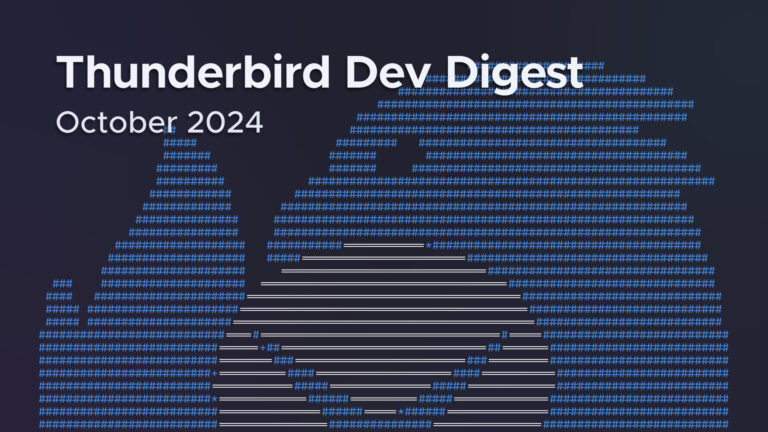
Hello again Thunderbird Community! The last few months have involved a lot of learning for me, but I have a much better appreciation (and appetite!) for the variety of challenges and opportunities ahead for our team and the broader developer community. Catch up with last month’s update, and here’s a quick summary of what’s been happening across the different teams:
Exchange Web Services support in Rust
An important member of our team left recently and while we’ll very much miss the spirit and leadership, we all learned a lot and are in a good position to carry the project forwards. We’ve managed to unstick a few pieces of the backlog and have a few sprints left to complete work on move/copy operations, protocol logging and priority two operations (flagging messages, folder rename & delete, etc). New team members have moved past the most painful stages and have patches that have landed. Kudos to the patient mentors involved in this process!
QR Code Cross-Device Account Import
Thunderbird for Android launched this week, and the desktop client (Daily, Beta & ESR 128.4.0) now provides a simple and secure account transfer mechanism, so that account settings don’t have to be re-entered for new users of the mobile app. Download Thunderbird for Android from the Play store
Account Hub
Development of a refreshed account hub is moving forward apace and with the critical path broken down into sprints, our entire front end team is working to complete things in the next two weeks. Meta bug & progress tracking.
Clean up on aisle 2
In addition to our project work, we’ve had to be fairly nimble this month, with a number of upstream changes breaking our builds and pipelines. We get a ton of benefit from the platforms we inherit but at times it feels like we’re dealing with many things out of our control. Mental note: stay calm and focus on future improvements!
Global Database, Conversation View & folder corruption issues
On top of the conversation view feature and core refactoring to tackle the inner workings of thread-safe folder and message manipulation, work to implement a long term database replacement is well underway. Preliminary patches are regularly pumped into the development ecosystem for discussion and review, for which we’re very excited!
In-App Notifications
With phase 1 of this project now complete, we’ve scoped out additions that will make it even more flexible and suitable for a variety of purposes. Beta users will likely see the first notifications coming in November, so keep your eyes peeled. Meta Bug & progress tracking.
New Features Landing Soon
Several requested features are expected to debut this month (or very soon) and include…
- Dark Reader support
- RSS feed corrections
- Button inside link resolution
- PGP Key window adjustment
- Folder compaction fixes
- Lazy loading stack to improve performance
- Various calendar improvements
- startup crash avoidance
- and many more which are listed in release notes for beta.
As usual, if you want to see things as they land, and help us squash some early bugs, you can always check the pushlog and try running daily, which would be immensely helpful for catching things early.
See you next month.
Toby Pilling
Senior Manager, Desktop Engineering
The post Thunderbird Monthly Development Digest: October 2024 appeared first on The Thunderbird Blog.
]]>The post Thunderbird for Android 8.0 Takes Flight appeared first on The Thunderbird Blog.
]]>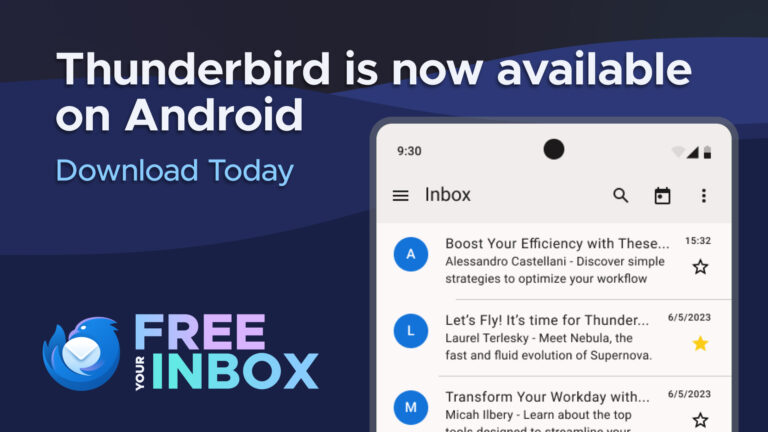
Just over two years ago, we announced our plans to bring Thunderbird to Android by taking K-9 Mail under our wing. The journey took a little longer than we had originally anticipated and there was a lot to learn along the way, but the wait is finally over! For all of you who have ever asked “when is Thunderbird for Android coming out?”, the answer is – today! We are excited to announce that the first stable release of Thunderbird for Android is out now, and we couldn’t be prouder of the newest, most mobile member of the Thunderbird family.
Resources
- What’s New: https://support.mozilla.org/kb/new-thunderbird-android-version-8
- Detailed Release Notes: https://github.com/thunderbird/thunderbird-android/releases/tag/THUNDERBIRD_8_0
- Community Support Forum: Thunderbird for Android has its own home on the official Mozilla Support (SUMO) forums. Find the help you need to configure and use the newest Thunderbird from our community on a mobile friendly site.
- Import Settings: Whether you’re importing your information from K-9 Mail or Thunderbird on the desktop, transfer your information quickly and easily with our guide.
- System Requirements: Thunderbird for Android runs on mobile devices running Android 5 and above.
- Platform Availability: Download Thunderbird for Android from the following places.
- Google Play Store
- F-droid
- GitHub Releases (apk only, no updates)
- The Thunderbird website (on an Android device)
- Get Involved: Thunderbird for Android thrives thanks to community support, and you can be part of the community! We are grateful to everyone who donates their skill and time to answer support questions, test releases, translate and more. Find out all the ways to get in where you fit in.
- Support Us: We are 100% donor-supported. Your gift helps us develop new apps (like this one!), improve speed and stability, promote Thunderbird and software freedom, and provide downloads free-of-charge to millions. Donate on our webpage or in the app.
- Suggest New Features: We know you have great ideas for future features. You can share them on Mozilla Connect, where community members can upvote and comment on them. Our team uses the feedback here to help shape our roadmap.
Thanks for Helping Thunderbird for Android Fly
Thank you for being a part of the community and sharing this adventure on Android with us! We’re especially grateful to all of you who have helped us test the beta and release candidate images. Your feedback helped us find and fix bugs, test key features, and polish the stable release. We hope you enjoy using the newest Thunderbird, now and for a long time to come!
The post Thunderbird for Android 8.0 Takes Flight appeared first on The Thunderbird Blog.
]]>The post Maximize Your Day: Focus Your Inbox with ‘Grouped by Sort’ appeared first on The Thunderbird Blog.
]]>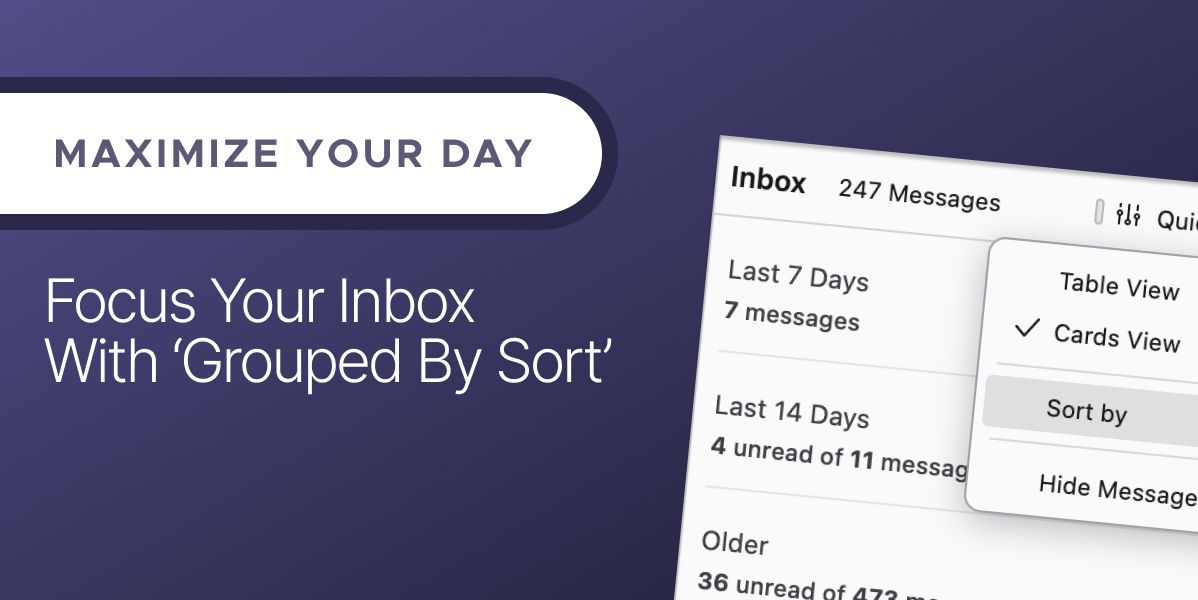
For me, staying on top of my inbox has always seemed like an unattainable goal. I’m not an organized person by nature. Periodic and severe email anxiety (thanks, grad school!) often meant my inbox was in the quadruple digits (!).
Lately, something’s shifted. Maybe it’s working here, where people care a lot about making email work for you. These past few months, my inbox has stayed if not manageable, then pretty close to it. I’ve only been here a year, which has made this an easier goal to reach. Treating my email like laundry is definitely helping!
But how do you get a handle on your inbox when it feels out of control? R.L. Dane, one of our fans on Mastodon, reminded us Thunderbird has a powerful, built-in tool than can help: the ‘Grouped by Sort’ feature!
Email Management for All Brains
For those of us who are neurodiverse, email management can be a challenge. Each message that arrives in your inbox, even without a notification ding or popup, is a potential distraction. An email can contain a new task for your already busy to-do list. Or one email can lead you down a rabbit hole while other emails pile up around it. Eventually, those emails we haven’t archived, replied to, or otherwise processed take on a life of their own.
Staring at an overgrown inbox isn’t fun for anyone. It’s especially overwhelming for those of us who struggle with executive function – the skills that help us focus, plan, and organize. A full or overfull inbox doesn’t seem like a hurdle we can overcome. We feel frozen, unsure where to even begin tackling it, and while we’re stuck trying to figure out what to do, new emails keep coming. Avoiding our inboxes entirely starts to seem like the only option – even if this is the most counterproductive thing we can do.
So, how in the world do people like us dig out of our inboxes?
Feature for Focus: Grouped by Sort
We love seeing R.L. Dane’s regular Thunderbird tips, tricks, and hacks for productivity. In fact, he was the one who brought this feature to our attention on a Mastodon post! We were thrilled when we asked if we could turn it to a productivity post and got an excited “Yes!” in response.
As he pointed out, using Grouped by Sort, you can focus on more recently received emails. Sorting by Date, this feature will group your emails into the following collapsible categories:
- Today
- Yesterday
- Last 7 Days
- Last 14 Days
- Older
Turning on Grouped by Sort is easy. Click the message list display options, then click ‘Sort by.’ (In the top third, toggle the ‘Date’ option. In the second third, select your preferred order of Descending or Ascending. Finally, in the bottom third, toggle ‘Grouped by Sort.’
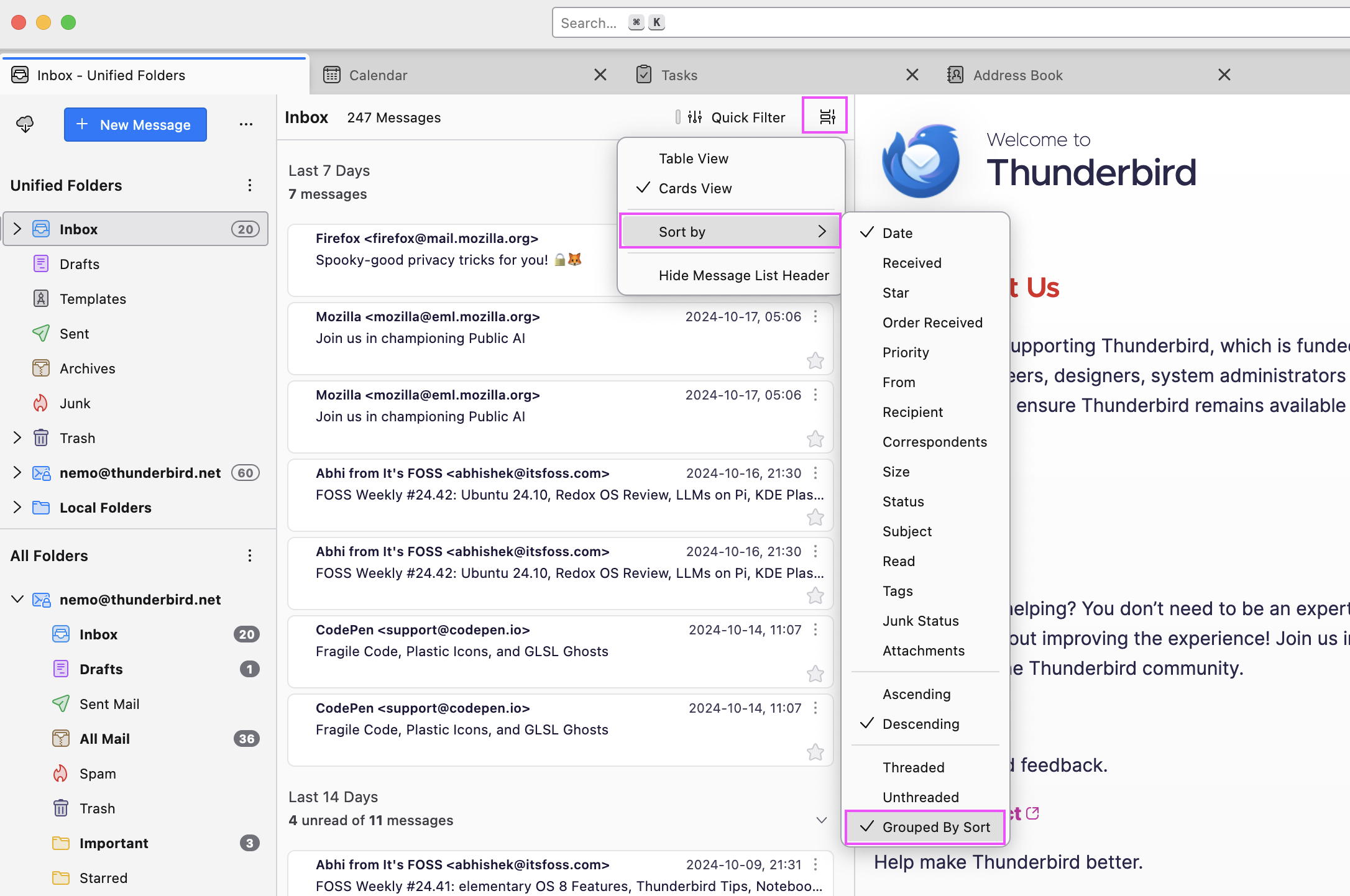
Now you’re ready to whittle your way through an overflowing inbox, one group at a time.
And once you get down to a mostly empty and very manageable inbox, you’ll want to find strategies and habits to keep it there. Treating your email like laundry is a great place to start. We’d love to hear your favorite email management habits in the comments!
Resources
ADDitude Magazine: https://www.additudemag.com/addressing-e-mail/
Dixon Life Coaching: https://www.dixonlifecoaching.com/post/why-high-achievers-with-adhd-love-and-hate-their-email-inbox
The post Maximize Your Day: Focus Your Inbox with ‘Grouped by Sort’ appeared first on The Thunderbird Blog.
]]>The post Contributor Highlight: Toad Hall appeared first on The Thunderbird Blog.
]]>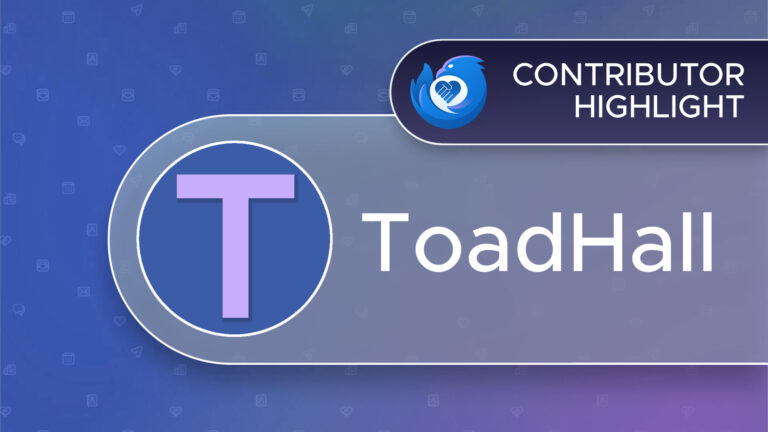
We’re back with another contributor highlight! We asked our most active contributors to tell us about what they do, why they enjoy it, and themselves. Last time, we talked with Arthur, and for this installment, we’re chatting with Toad Hall.
If you’ve used Support Mozilla (SUMO) to get help with Thunderbird, Toad Hall may have helped you. They are one of our most dedicated contributors, and their answers on SUMO have helped countless people.
How and Why They Use Thunderbird
Thunderbird has been my choice of email client since version 3, so I have witnessed this product evolve and improve over the years. Sometimes, new design can initially derail you. Being of an older generation, I appreciate it is not necessarily so easy to adapt to change, but I’ve always tried to embrace new ideas and found that generally, the changes are an improvement.
Thunderbird offers everything you expect from handling several email accounts in one location, filtering, address books and calendar, plus many more functionalities too numerous to mention. The built in Calendar with its Events and Tasks options is ideal for both business and personal use. In addition, you can also connect to online calendars. I find using the pop up reminders so helpful whether it’s notifying you of an appointment, birthday or that a TV program starts in 15 minutes! Personally, I particularly impressed that Thunderbird offers the ability to modify the view and appearance to suit my needs and preferences.
I use a Windows OS, but Thunderbird offers release versions suitable for Windows, MAC and Linux variants of Operating Systems. So there is a download which should suit everyone. In addition, I run a beta version so I can have more recent updates, meaning I can contribute by helping to test for bugs and reporting issues before it gets to a release version.
How They Contribute
The Thunderbird Support forum would be my choice as the first place to get help on any topic or query and there is a direct link to it via the ‘Help’ > ‘Get Help’ menu option in Thunderbird. As I have many years of experience using Thunderbird, I volunteer my free time to assist others in the Thunderbird Support Forum which I find a very rewarding experience. I have also helped out writing some Support Forum Help Articles. In more recent years I’ve assisted on the Bugzilla forum helping to triage and report potential bugs. So, people can get involved with Thunderbird in various ways.
Share Your Contributor Highlight (or Get Involved!)
Thanks to Toad Hall and all our contributors who have kept us alive and are helping us thrive!
If you’re a contributor who would like to share your story, get in touch with us at community@thunderbird.net. If you want to get involved with Thunderbird, read our guide to learn about all the ways to contribute.
The post Contributor Highlight: Toad Hall appeared first on The Thunderbird Blog.
]]>The post Thunderbird Monthly Development Digest: September 2024 appeared first on The Thunderbird Blog.
]]>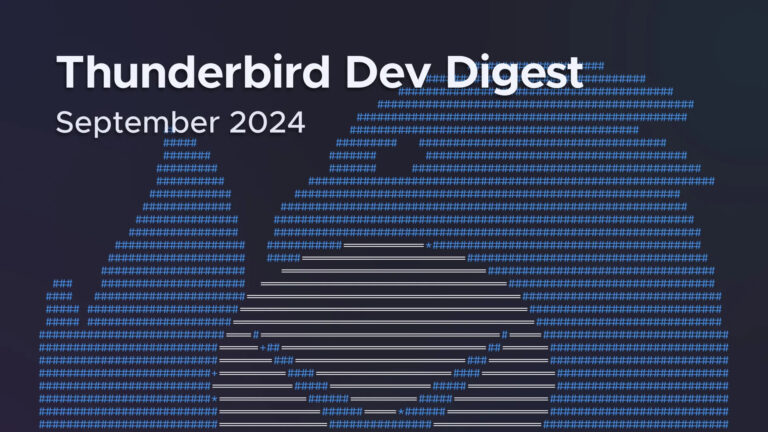
Hello Thunderbird Community! I’m Toby Pilling, a new team member and I’ve spent the last couple of months getting up to speed, and have really enjoyed meeting the team and members of the community virtually, and some in person! September is now over (and so is the summer for many in our team), and we’re excited to share the latest adventures underway in the Thunderbird world. If you missed our previous update, go ahead and catch up! Here’s a quick summary of what’s been happening across the different teams:
Exchange
Progress continues on implementing move/copy operations, with the ongoing re-architecture aimed at making the protocol ecosystem more generic. Work has also started on error handling, protocol logging and a testing framework. A Rust starter pack has been provided to facilitate on-boarding of new team members with automated type generation as the first step in reducing the friction.
Account Hub
Development of a refreshed account hub is moving forward, with design work complete and a critical path broken down into sprints. Project milestones and tasks have been established with additional members joining the development team in October. Meta bug & progress tracking.
Global Database & Conversation View
The team is focused on breaking down the work into smaller tasks and setting feature deliverables. Initial work on integrating a unique IMAP ID is being rolled out, while the conversation view feature is being fast-tracked by a focused team, allowing core refactoring to continue in parallel.
In-App Notification
This initiative will provide a mechanism to notify users of important security updates and feature releases “in-app”, in a subtle and unobtrusive manner, and has advanced at break-neck speed with impressive collaboration across each discipline. Despite some last-minute scope creep, the team has moved swiftly into the testing phase with an October release in mind. Meta Bug & progress tracking.
Source Docs Clean-up
Work continues on source documentation clean-up, with support from the release management team who had to reshape some of our documentation toolset. The completion of this project will move much of the developer documentation closer to the actual code which will make things much easier to maintain moving forwards. Stay tuned for updates to this in the coming week and follow progress here.
Account Cross-Device Import
As the launch date for Thunderbird for Android gets closer, we’re preparing a feature in the desktop client which will provide a simple and secure account transfer mechanism, so that account settings don’t have to be re-entered for new users of the Android client. A functional prototype was delivered quickly. Now that design work is complete, the project entered the 2 final sprints this week. Keep track here.
Battling OAuth Changes
As both Microsoft and Google update their OAuth support and URLs, the team has been working hard to minimize the effect of these changes on our users. Extended logging in Daily will allow for better monitoring and issue resolution as these updates roll out.
New Features Landing Soon
Several requested features are expected to debut this month or very soon:
- Horizontal scrolling for emails in table view as a user preference.
- Calendar support for ICS import including a Comments field.
- Certificate viewer to support validation.
- Encrypted draft messages even when no recipients are specified.
- UI enhancements and bug fixes for the calendar, RSS, and mail modules.
As usual, if you want to see things as they land you can check the pushlog and try running daily. This would be immensely helpful for catching bugs early.
See ya next month.
Toby Pilling
Sr. Manager, Desktop Engineering
The post Thunderbird Monthly Development Digest: September 2024 appeared first on The Thunderbird Blog.
]]>The post State Of The Bird: Thunderbird Annual Report 2023-2024 appeared first on The Thunderbird Blog.
]]>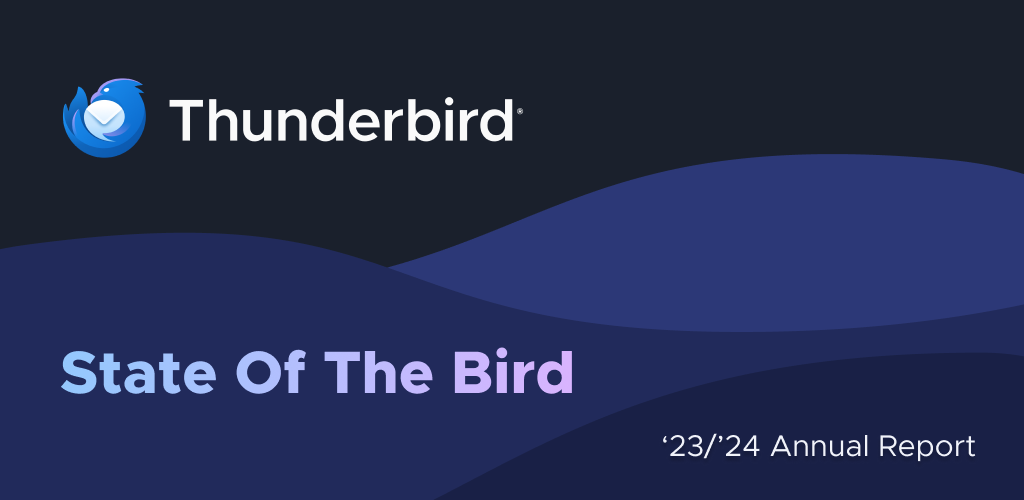
We’ve just released Thunderbird version 128, codenamed “Nebula”, our yearly stable release. So with that big milestone done, I wanted to take a moment and tell our community about the state of Thunderbird. In the past I’ve done a recap focused solely on the project’s financials, which is interesting – but doesn’t capture all of the great work that the project has accomplished. So, this time, I’m going to try something different. I give you the State of the Bird: Thunderbird Annual Report 2023-2024.
Before we jump into it, on behalf of the Thunderbird Team and Council, I wanted to extend our deepest gratitude to the hundreds of thousands of people who generously provided financial support to Thunderbird this past year. Additionally, Thunderbird would like to thank the many volunteers who contributed their time to our many efforts. It is not an exaggeration to say that this product would not exist without them. All of our contributors are the lifeblood of Thunderbird. They are the beacons shining brightly to remind us of the transformative power of open source, and the influence of the community that stands alongside it. Thank you for not just being on this journey with us, but for making the journey possible.
Supernova & Nebula
Thunderbird Supernova 115 blazed into existence on July 11, 2023. This Extended Support Release (ESR) not only introduced cool code names for releases, but also helped bring Thunderbird a modern look and experience that matched the expectation of users in 2023. In addition to shedding our outdated image, we also started tackling something which prevented a brisk development pace and steady introduction of new features: two decades of technical debt.
After three years of slow decline in Daily Active Users (DAUs), the Supernova release started a noticeable upward trend, which reaffirms that the changes we made in this release are putting us on the right track. What our users were responding to wasn’t just visual, however. As we’ve noted many times before – Supernova was also a very large architectural overhaul that saw the cleanup of decades of technical debt for the mail front-end. Supernova delivered a revamped, customizable mail experience that also gave us a solid foundation to build the future on.
Fast forwarding to Nebula, released on July 11, 2024, we built upon many of the pillars that made Supernova a success. We improved the look and feel, usability, customization and speed of the mail experience in truly substantial ways. Additionally, many of the investments in improving the Thunderbird codebase began to pay dividends, allowing us to roll in preliminary Exchange support and use native OS notifications.
All of the work that has happened with Supernova and Nebula is an effort to make Thunderbird a first-class email and productivity tool in its own right. We’ve spent years paying down technical debt so that we could focus more on the features and improvements that bring value to our users. This past year we got to leverage all that hard work to create a truly great Thunderbird experience.
K-9 Mail & Thunderbird For Android
In response to the enormous demand for Thunderbird on a phone, we’ve worked hard to lay a solid foundation for our Android release. The effort to turn K-9 Mail into something we can confidently call a great Thunderbird experience on-the-go is coming along nicely.
In April of 2023, we released K-9 6.600 with a message view redesign that brought K-9 and Thunderbird more in line. This release also had a more polished UI, among other fixes, improvements, and changes. Additionally, it integrated our new design system with reusable components that will allow quicker responses to future design changes in Android.
The 6.7xx Beta series, developed throughout 2023, primarily focused on improving account setup. The main reason for this change is to enable seamless email account setup. This also started the transition of K-9’s UI from traditional Android XML layouts to using the more modern and now recommended Jetpack Compose UI toolkit, and the adoption of Atomic Design principles for a cohesive, intuitive design. The 6.710 Beta release in August was the first to include the new account setup for more widespread testing. Introducing new account setup code and removing some of the old code was a step in the right direction.
In other significant events of 2023, we hired Wolf Montwé as a senior software engineer, doubling the K-9 Mail team at MZLA! We also conducted a security audit with 7ASecurity and OSTIF. No critical issues were found, and many non-critical issues were fixed. We began experimenting with Material 3 and based on positive results, decided to switch to Material 3 before renaming the app. Encouraged by our community contributors, we moved to Weblate for localization. Weblate is better integrated into K-9 and is open source. Some of our time was also spent on necessary maintenance to ensure the app works properly on the latest Android versions.
So far this year, we’ve shipped the account setup improvements to everyone and continued work on Material 3 and polishing the app in preparation for its transition to “Thunderbird for Android.” You can look at individual release details in our GitHub repository and track the progress we’ve made there. Suffice to say, the work on creating an amazing Android experience has been significant – and we look forward to sharing the first true Thunderbird release on Android in the next few months.
Services and Infrastructure
In 2023 we began working in earnest on delivering additional value to Thunderbird users through a suite of web services. The reasoning? There are some features that would add significant value to our users that we simply can’t do in the Thunderbird clients alone. We can, however, create amazing, open source, privacy-respecting services that enhance the Thunderbird experience while aligning with our values – and that’s what we’ve been doing.
The services that we’ve focused on are: Appointment, a calendar scheduling tool; Send, an encrypted large-file transfer service; and Thunderbird Sync, which will allow users to sync their Thunderbird settings between devices (both desktop and Android).
Thunderbird Appointment enables you to plan less and do more. You can add your calendars to the service, outline your weekly availability and then send links that allow others to grab time on your schedule. No more long back-and-forth email threads to find a time to meet, just send a link. We’ve just opened up beta testing for the service and look forward to hearing from early users what features our users would like to see. For more information on Thunderbird Appointment, and if you’d like to sign up to be a beta tester, check out our Thunderbird Appointment blog post. If you want to look at the code, check out the repository for the project on GitHub.
The Thunderbird team was very sad when Firefox Send was shut down. Firefox Send made it possible to send large files easily, maybe easier than any other tool on the Internet. So we’re reviving it, but not without some nice improvements. Thunderbird Send will not only allow you to send large files easily, but our version also encrypts them. All files that go through Send are encrypted, so even we can’t see what you share on the service. This privacy focus was important in building this tool because it’s one of our core values, spelled out in the Mozilla Manifesto (principle 4): “Individuals’ security and privacy on the internet are fundamental and must not be treated as optional.”
Finally, after many requests for this feature, I’m happy to share that we are working hard to make Thunderbird Sync available to everyone. Thunderbird Sync will allow you to sync your account and application settings between Thunderbird clients, saving time at setup and headaches when you use Thunderbird on multiple devices. We look forward to sharing more on this front in the near future.
2023 Financial Picture
All of the above work was made possible because of our passionate community of Thunderbird users. 2023 was a year of significant investment into our team and our infrastructure, designed to ensure the continued long-term stability and sustainability of Thunderbird. As previously mentioned these investments would not have been possible without the remarkable generosity of our financial contributors.
Contribution Revenue
Total financial contributions in 2023 reached $8.6M, reflecting a 34.5% increase over 2022. More than 515,000 transactions from over 300,000 individual contributors generated this financial support (26% of the transactions were recurring monthly contributions).
In addition to that incredible total, what stands out is that the majority of our contributions were modest. The average contribution amount was $16.90, and the median amount was $11.12.
We are often asked if we have “super givers” and the refreshing answer is “no, we simply have a super community.” To underscore this, consider that 61% of giving was $20 or less, and 95% of the transactions were $35 or less. The number of transactions $1000 and above accounted for only 56 transactions; that’s effectively 0.0007% of all contribution transactions.
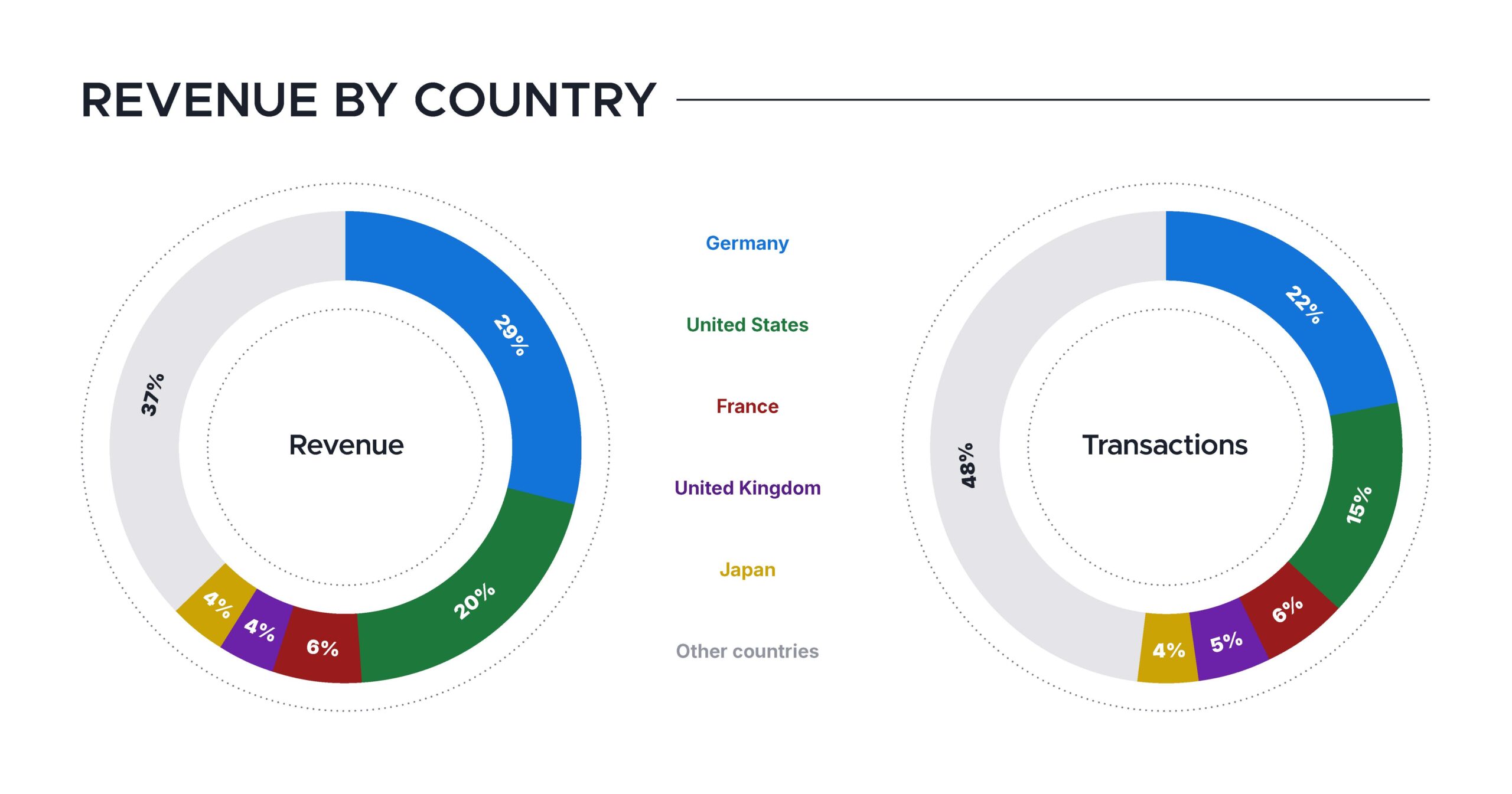
And this super community helping us sustain and improve Thunderbird is very much a global one, with contributions pouring in from more than 200 countries! The top five giving countries — Germany, the United States, France, the United Kingdom, and Japan — accounted for 63% of our contribution revenue and 50% of transactions. We believe this global support is a testament to the universal value of Thunderbird and the core values the project stands for.
Expenses
Now, let’s talk about how we’re using these funds to keep Thunderbird thriving well into the future.
As with most organizations, employee-related expenses are the largest expense category. The second highest category for us are all the costs associated with distributing Thunderbird to tens of millions of users and the operations that help make that happen. You can see our spending across all categories below:
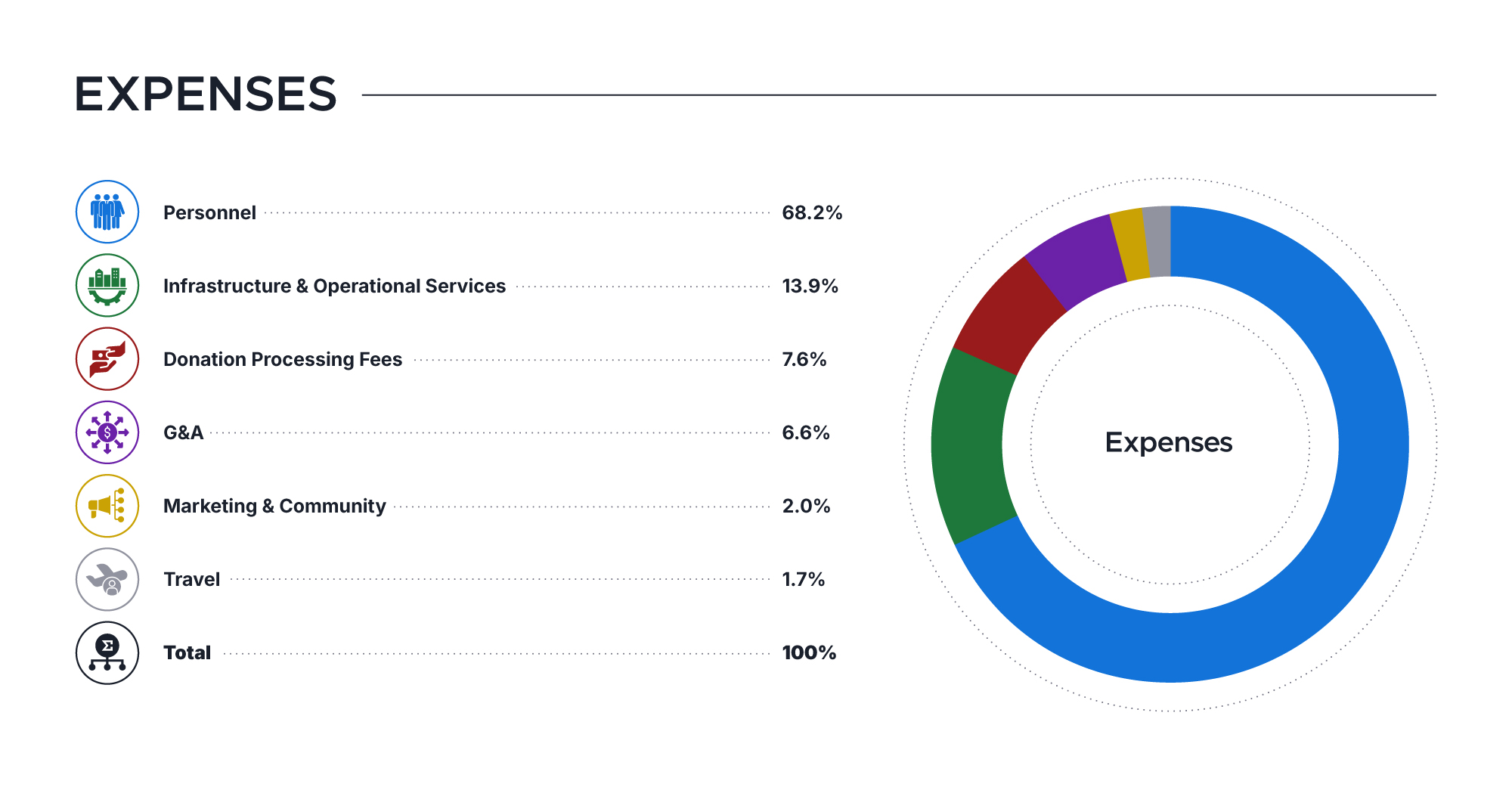
The Importance of Supporting Thunderbird
When I started at Thunderbird (in 2017), we weren’t on a sustainable path. The cost of building, maintaining and distributing Thunderbird to tens of millions of people was too great when compared against the financial contributions we had coming in. Fast forward to 2023 and we’re able to not only deliver Thunderbird to our users without worrying about keeping the lights on, but we are able to fix bugs, build new features and invest in new platforms (Android). It’s important for Thunderbird to exist because it’s not just another app, but one built upon real values.
Our values are:
- We believe in privacy. We don’t collect your data or spy on you, what you do in Thunderbird is your business, not ours.
- We believe in digital wellbeing. Thunderbird has no dark patterns, we don’t want you doomscrolling your email. Apps should help, not hurt, you. We want Thunderbird to help you be productive.
- We believe in open standards. Email works because it is based on open standards. Large providers have undermined these standards to lock users into their platforms. We support and develop the standards to everyone’s benefit.
If you share these values, we ask that you consider supporting Thunderbird. The tech you use doesn’t have to be built upon compromises. Giving to Thunderbird allows us to create good software that is good for you (and the world). Consider giving to support Thunderbird today.
2023 Community Snapshot
As we’ve noted so many times in the previous paragraphs, it’s because of Thunderbird’s open source community that we exist at all. In order to better engage with and acknowledge everyone participating in our projects, this past year we set up a Bitergia instance, which is now public. Bitergia has allowed us to better measure participation in the community and find where we are doing well and improving, and areas where there is room for improvement. We’ve pulled out some interesting metrics below.
For reference, Github and Bugzilla measure developer contributions. TopicBox measures activity across our many mailing lists. Pontoon measures the activity from volunteers who help us translate and localize Thunderbird. SUMO measures the impact of Thunderbird’s support volunteers who engage with our users and respond to their varied support questions.
Contributor & Community Growth
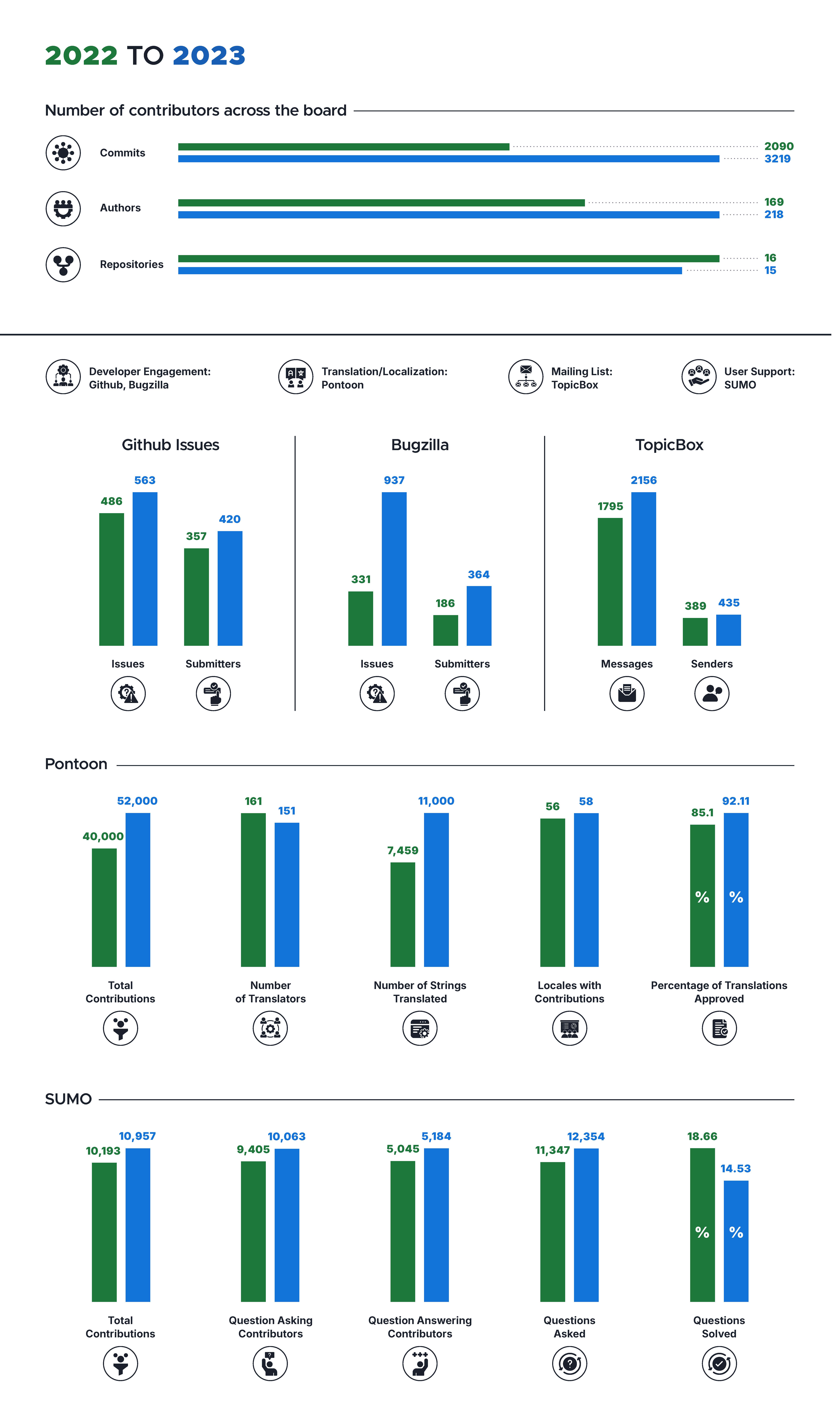
Thank You
In conclusion, we’d simply like to thank this amazing community of Thunderbird supporters who give of their time and resources to create something great. 2023 and 2024 have been years of extraordinary improvement for Thunderbird and the future looks bright. We’re humbled and pleased that so many of you share our values of privacy, digital wellbeing and open standards. We’re committed to continuing to provide Thunderbird for free to everyone, everywhere – thanks to you!
The post State Of The Bird: Thunderbird Annual Report 2023-2024 appeared first on The Thunderbird Blog.
]]>The post Help Us Test the Thunderbird for Android Beta! appeared first on The Thunderbird Blog.
]]>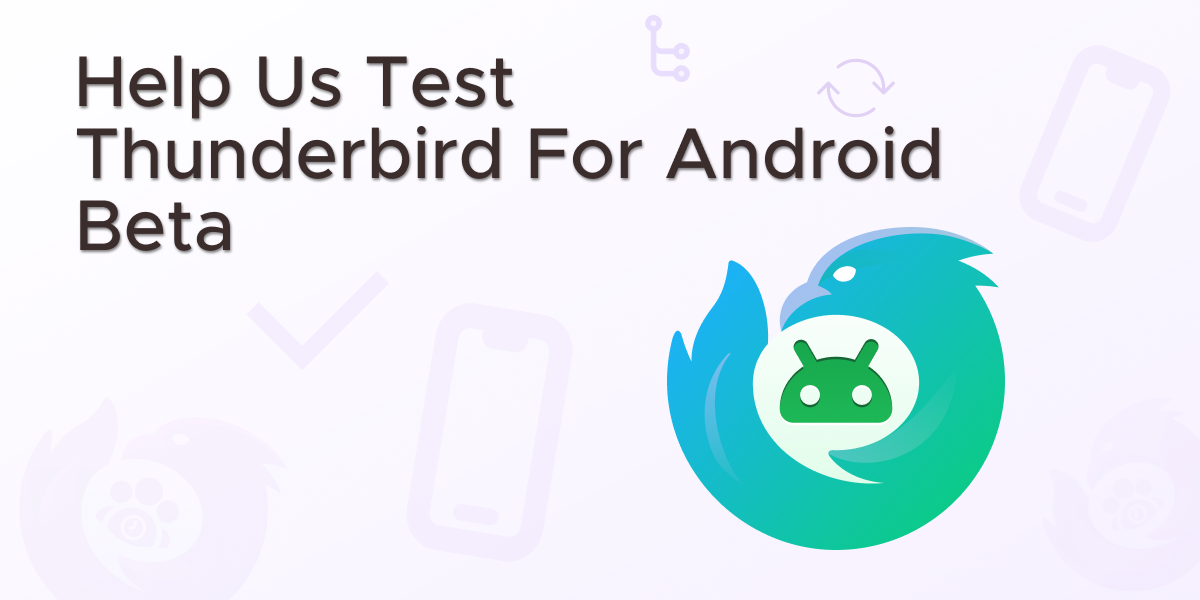
The Thunderbird for Android beta is out and we’re asking our community to help us test it. Beta testing helps us find critical bugs and rough edges that we can polish in the next few weeks. The more people who test the beta and ensure everything in the testing checklist works correctly, the better!
Help Us Test!
Anyone can be a beta tester! Whether you’re an experienced beta tester or you’ve never tested a beta image before, we want to make it easy for you. We are grateful for your time and energy, so we aim to make testing quick, efficient, and hopefully fun!!
The release plan is as follows, and we hope to stick to this timeline unless we encounter any major hurdles:
- September 30 – First beta for Thunderbird for Android
- Third week of October – first release candidate
- Fourth week of October – Thunderbird for Android release
Download the Beta Image
Below are the options for where you can download with Beta and get started:
- Download Thunderbird Beta on the Google Play Store
- Download the latest pre-release version from our Github Releases page
We are still working on preparing F-Droid builds. In the meanwhile, please make use of the other two download mechanisms.
Use the Testing Checklist
Once you’ve downloaded the Thunderbird for Android beta, we’d like you to check that you can do the following:
- Automatic Setup (user only provides email address and maybe password)
- Manual Setup (user provides server settings)
- Read Messages
- Fetch Messages
- Switch accounts
- Move email to folder
- Notify for new message
- Edit drafts
- Write message
- Send message
- Email actions: reply, forward
- Delete email
- NOT experience data loss
Test the K-9 Mail to Thunderbird for Android Transfer
If you’re already using K-9 Mail, you can help test an important feature: transferring your data from K-9 Mail to Thunderbird for Android. To do this, you’ll need to make sure you’ve upgraded to the latest beta version of K-9 Mail.
This transfer process is a key step in making it easier for K-9 Mail users to move over to Thunderbird. Testing this will help ensure a smooth and reliable experience for future users making the switch.
Later builds will additionally include a way to transfer your information from Thunderbird Desktop to Thunderbird for Android.
What we’re not testing
We know it’s tempting to comment about everything you notice in the beta. For the purpose of this short initial beta, we won’t be focusing on addressing longstanding issues. Instead, we ask you to be laser focused on critical bugs, the checklist above, and issues could prevent users from effectively interacting with the app, to help us deliver a great initial release.
Where to Give Feedback
Share your feedback on the Thunderbird for Android beta mailing list and see the feedback of other users. It’s easy to sign up and let us know what worked and more importantly, what didn’t work from the tasks above. For bug reports, please provide as much detail as possible including steps to reproduce the issue, your device model and OS version, and any relevant screenshots or error messages.
Want to chat with other community members, including other testers and contributors working on Thunderbird for Android? Join us on Matrix!
Do you have ideas you would like to see in future versions of Thunderbird for Android? Let us know on Mozilla Connect, our official site to submit and upvote ideas.
The post Help Us Test the Thunderbird for Android Beta! appeared first on The Thunderbird Blog.
]]>The post Contribute to Thunderbird for Android appeared first on The Thunderbird Blog.
]]>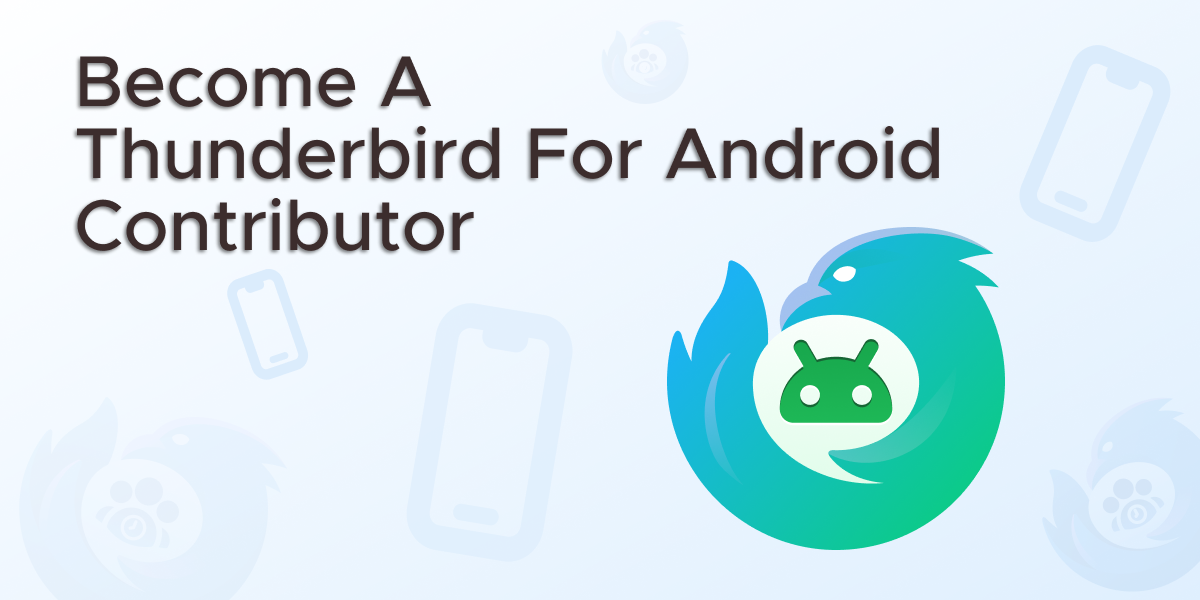
The wait is almost over! Thunderbird for Android will be here soon. As an open-source project, we could not succeed without the incredible volunteer contributors who help us along the way. Whether you’re a fan of problem-solving, localization, testing, development, or even just spreading the word, there’s a role for you in our community. Contributing doesn’t just benefit us – it’s a great way to grow your own skills and make a real difference in the lives of thousands of Thunderbird users worldwide. However you choose to contribute to Thunderbird for Android, we’re always happy to welcome new friends to the project!
Support
If you’re a natural at getting to the root of problems, consider becoming a support contributor!
When you answer a support question, you’re not only helping the person who asked the question, you’re helping the hundreds if not thousands of people who read it. Or if you like writing and editing, you can help with our knowledge base (KB) articles!
Support for Thunderbird on Android will live on Mozilla Support, aka SUMO, just like support for the Desktop application, but under its own product tile. We’ve put together a guide to get you started on SUMO, from setting up an account and finding questions to best practices, whether you to decide to help in the question forums or in the KB articles. Want to talk to other support volunteers? Join us on our Support Crew Matrix channel.
Localization
Thunderbird’s users are all over the world, and our localization contributors put the app and support articles in their language. Thunderbird for Android’s localization lives on Weblate, copyleft libre continuous localization that powers many other open source projects. If you haven’t used Weblate before, they have a useful guide for getting started.
Testing
If you want to try the newest features and help us polish and perfect them before they make it to a general release, join us as a tester. Testers are comfortable using daily and beta releases and providing meaningful feedback to developers.
When they’re available, you can download the Thunderbird for Android Beta releases from the Google Play Store or from GitHub under the ‘Pre-Release’. F-Droid users will need to manually select beta versions. To get update notification for non-suggested versions you need to check ‘Settings > Expert mode > Unstable updates’ in the F-Droid app.
Just like Thunderbird for desktop, we have a mailing list where you can give feedback and talk to developers and fellow beta testers.
Development
Interested at helping at the code level? All our development happens on our GitHub page, where you can read our code contributor section in our CONTRIBUTING.md page.
Look for issues that are tagged ‘good first issue,’ even if you’re an experienced developer but are new to Thunderbird for Android. Use the android-planning mailing list to talk to and get feedback from other developers.
Promote Thunderbird for Android
Spreading the word about Thunderbird for Android is an essential way to contribute, and there are many ways to do this. You can leave us a positive review on the Google Play Store (if you had a positive experience, of course) and encourage others to download and try Thunderbird for Android. This could be friends or family, a local computer club, or any other group you could think of! We’d love to hear your ideas and find a way to support you on the android-planning mailing list.
Financial Support
Financial support is a fantastic way to ensure the project continues to thrive. Your gift goes toward improving features, fixing bugs, and expanding the app’s functionality for all of its users.
By supporting Thunderbird financially, you’re investing in open-source software that respects your privacy and gives you control over your data. Every contribution, no matter how small, helps us maintain our independence and stay true to our mission.
The post Contribute to Thunderbird for Android appeared first on The Thunderbird Blog.
]]>The post VIDEO: The Thunderbird Council appeared first on The Thunderbird Blog.
]]>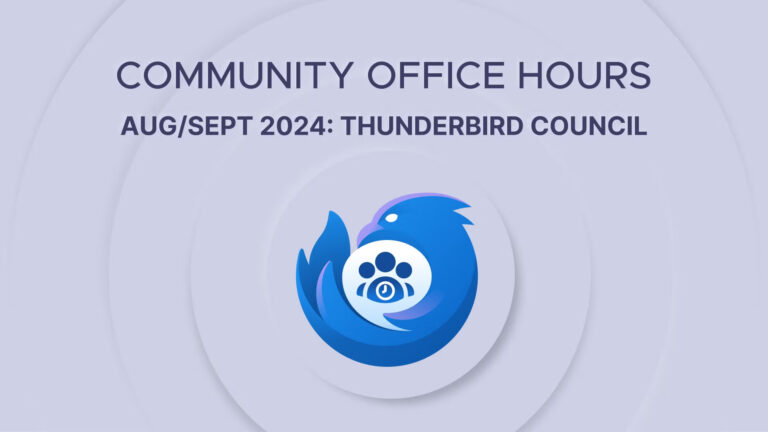
The Thunderbird Council is an important part of the Thunderbird story, and one of the main reasons we’re still around. In this month’s office hours, we sat down to chat with one of the very first Thunderbird Council members, Patrick Cloke, and one of the newest, Danny Colin, to discuss what this key group does and offers advice for those thinking about running in future elections.
Next month, we’ll put out a call for questions on social media and on the relevant TopicBox mailing lists for our next Office Hours, which will feature Ryan Sipes, Managing Director of Product at MZLA and Mark Surman, executive director of the Mozilla Foundation!
September Office Hours: The Thunderbird Council
While Thunderbird has been around almost 20 years, the Council hasn’t always been a part of it. In 2012, Mozilla discontinued support for Thunderbird as a product, but our community stepped in. In 2014, core contributors met in Toronto and elected the first Thunderbird Council to guide the project. For many years, the council was responsible for the day-to-day responsibilities, including development, budgeting, and hiring. While MZLA now handles those operations, the council has an even more crucial role. In the video, Danny and Patrick explain how the modern-day council works with MZLA and serves as the community’s voice.
Want to know more about what council members do, or who can run for council? Our guests provide honest and encouraging answers to these questions. Basically, if you’re an active contributor who cares about Thunderbird, you might consider running!
Watch, Read, and Get Involved
We’re so grateful to Danny and Patrick for joining us! We hope this video helps explain more about the Thunderbird Council’s role, and even encourages some of you who are active Thunderbird contributors to consider running in the future. And if you’re not an active contributor yet, go to our website to learn how to get involved!
VIDEO (Also on Peertube):
Thunderbird Council Resources:
- Email the council: council@thunderbird.net
- Contact our guests individually on matrix:
- Connect with our guests on Mastodon:
- Patrick:
- Mastodon: https://mastodon.social/@clokep
- Danny
- Mastodon: https://floss.social/@dannycolin
- Patrick:
- Mailing lists where you can get involved: https://thunderbird.topicbox.com/latest
The post VIDEO: The Thunderbird Council appeared first on The Thunderbird Blog.
]]>The post Maximize Your Day: Extend Your Productivity with Add-ons appeared first on The Thunderbird Blog.
]]>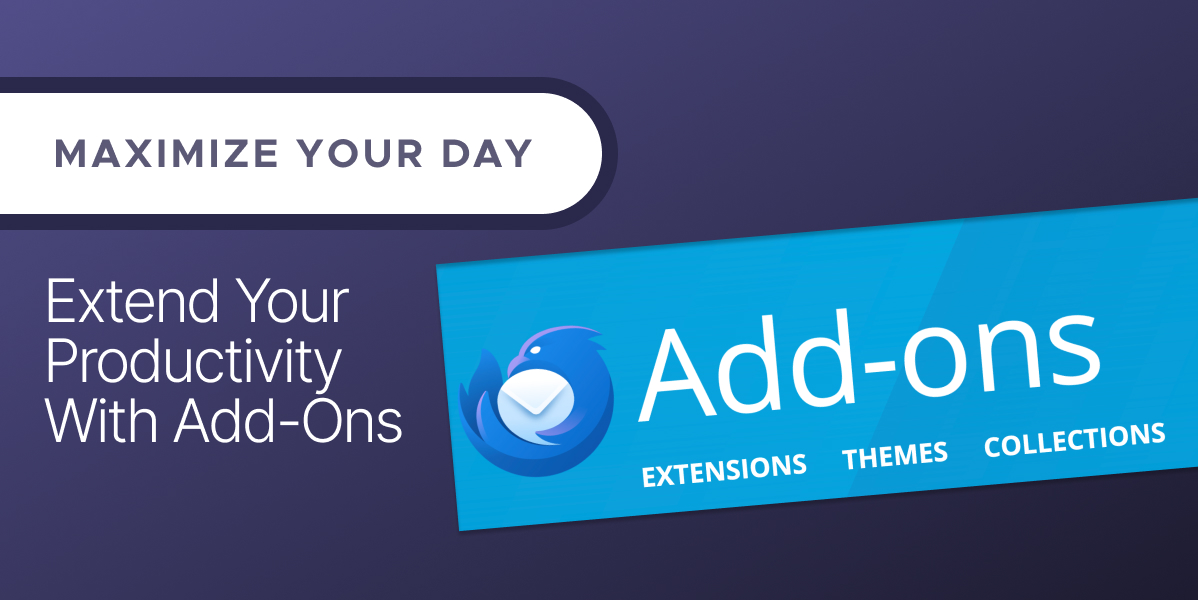
Thunderbird and its features help you do things. Crossing things off your to-do list means getting your time and energy back. Using Thunderbird and its Add-ons for productivity? Now that’s how you take your workflow to the next level.
One of Thunderbird’s biggest strengths is its vibrant, community-driven Add-ons. Many of those Add-ons are all about helping you get more out of Thunderbird. We asked our community what Add-ons they were using and would recommend to readers in this post. And did our community respond! You can read all of the recommendations from our community on Mastodon, Reddit, X (formerly Twitter) and LinkedIn.
We’re grateful for all the recommendations and for all of our Add-on developers! They put their personal time into making Thunderbird even more incredible through their extensions. The Add-ons in this list are only a small, small subset of all the active ones. We highly encourage you to check out the whole wide world of Add-ons out there.
(And if you’re wondering, I’ve downloaded Quicktext and Markdown Here Revival for my own workflow.)
Add-Ons to Try Today: Folders and Accounts
Border Colors D – Having all your email accounts in one app is already a productivity boost. What’s not productive is accidentally sending a message from the wrong account. Border Colors D allows you to assign a color and other visual indicators to the New Message window for each account. If you’re a “power user with many accounts [who] can’t afford an oops when you send with the wrong source address,” this is the Add-on for you.
Quick Folder Move – Sorting messages into folders is a great way to keep the information in your email organized. (We love using folders to sort our inbox down to zero!) This Add-on brings up a search bar or your recent folders, and allows you to move messages with ease – especially if you have a lot of folders
Add-ons to Try Today: Inbox Views and Message Composition
Thunderbird Conversations – When “you need to see quickly all received and sent mails…very important in a context of a shared mail box,” a conversation view is great. While that view is something we’d love to see built in to Thunderbird, there’s work on our underlying database we need to do first. But this Add-on brings that view to Thunderbird, and to your inbox, now.
Markdown Here Revival – Is Markdown part of your productivity and workflow toolbox? This Add-on will allow you to write emails in Markdown and send them as HTML with the click of a button! One of our recommenders said this Add-on is “absolutely mandatory.”
For those of you wanting to build on the power of templates, we have two Add-ons to mention. Quicktext is more for everyday users, and SmartTemplates is intended for the power users out there. Reducing the time and energy you spend on repetitive messages is a productivity gamechanger. We’re thrilled to have two Add-ons that can help users, whether they’ve been using Thunderbird for 2 months or 20 years.
Send Later – Sometimes, part of your productivity routine involves scheduling things to be sent later. Or, as the recommendation added, you don’t want your boss to know you were working on something at 2 am. This add-on adds true send later functionality to Thunderbird, so you decide when that message gets sent, whether it’s one time or regularly. (But really, night owls, sleep is good!)
Our community loves Nostalgy++, especially on Reddit. Nostalgy++ brings the power of keyboard shortcuts to Thunderbird to let you manage, search, and archive emails. One user says they save hours every week thanks to Nostalgy++’s keybindings.
Add-Ons to Test Today!
A few of our community’s favorite Add-ons are in beta testing for their fully 128-compatible versions, as of September 2024. Testing is one of the best and most beginner-friendly ways to contribute to Thunderbird. If you’d like to boost your productivity AND make a developer’s day, we have an Add-on we’d encourage you to check out.
Remove Duplicate Message is another Add-on that is also seeking beta testers for their 128-compatible version. For anyone who has ever dealt with replies to a “catch-all” email address or anything else cluttering their inbox with duplicates, this Add-on can take care of those copies for you. Check out their latest release and provide feedback on their GitHub Issues.
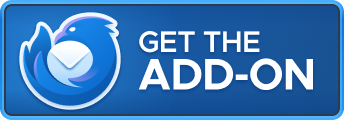
The post Maximize Your Day: Extend Your Productivity with Add-ons appeared first on The Thunderbird Blog.
]]>The post Thunderbird and Spam appeared first on The Thunderbird Blog.
]]>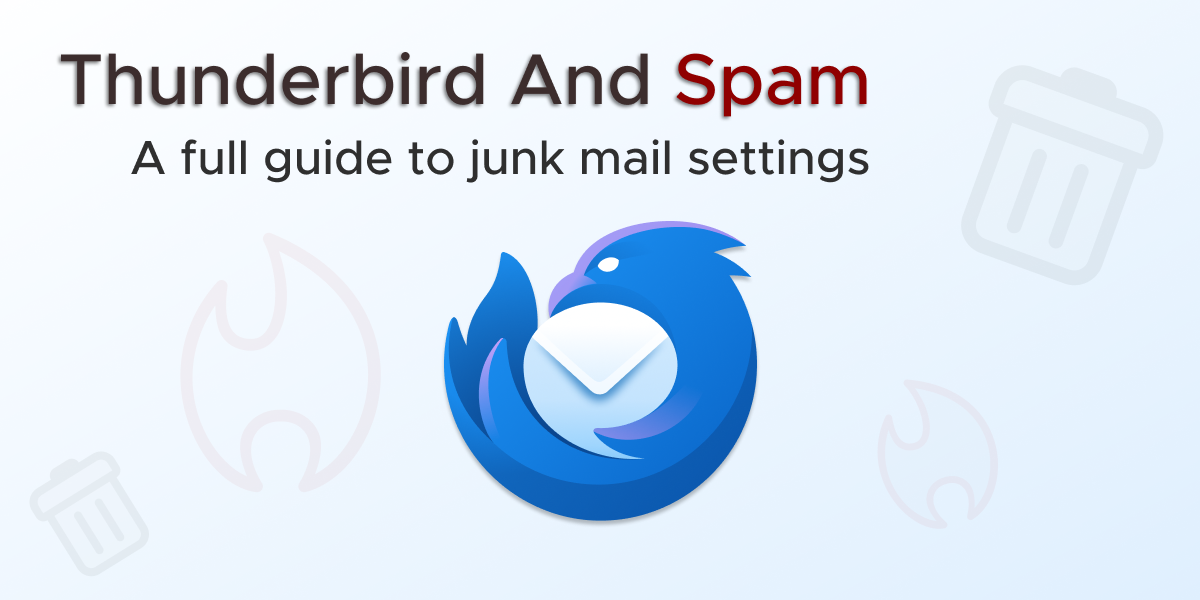
Dealing with spam in our daily email routines can be frustrating, but Thunderbird has some tools to make unwanted messages less of a headache. It takes time, training, and patience, but eventually you can emerge victorious over that junk mail. In this article we’ll explain how Thunderbird’s spam filter works, and how to tune it for the most effective results.
What Powers Thunderbird’s Spam Filter?
Thunderbird’s adaptive filter uses one of the oldest methods around — a Bayes algorithm — to help decide which messages should be marked as junk. But in order to work efficiently and reliably, it also needs a little help from you.
Thunderbird’s documentation and support community have always mentioned that the spam filter needs some human intervention, but I never understood why until researching how a Bayes algorithm works.
Why A Bayes Algorithm Needs Your Help
It’s helpful to think about Thunderbird’s spam filter as a sort of inbox detective, but you’re instrumental in training it and making it smarter. That’s because a Bayes algorithm calculates the odds that an email is spam based on the words it contains, and uses past experience to make an educated guess.
Here’s an example: you receive an email that contains the words “Urgent, act now to claim your free prize!” The algorithm checks to see how frequently those words appear in known spam messages compared to known good messages. If it detects those words (especially ones like “free” and “prize,”) are frequently in messages you’ve marked as spam, but not present in good messages, it will mark it as junk.
This is why it’s equally important to mark messages as “Not Junk.” Then, it learns to recognize “good” words that are common across non-spam emails. And for each message you mark, the probability that Thunderbird’s spam filter accurately identifies spam only increases.
Of course, it’s not perfect. A message you mark as junk might not consistently be marked as junk. A reliable, fail-safe way to ensure certain messages are marked as junk is to create filters manually.
Do you want to ensure important messages are never marked as junk? Try whitelisting.
Since junk mail patterns are always changing, it’s a good idea to regularly train Thunderbird. Without frequent training, it may not provide great results.
Junk Filter Settings
Now that we understand what powers Thunderbird’s junk filter, let’s look at how to manage the settings, and how to train Thunderbird for more consistent results.
Global Junk Settings
Junk filtering is enabled by default, but you can fine-tune what should happen to messages marked as junk using the global settings. These settings apply to all email accounts, though some can be overridden in the Per Account Settings.
- Click the menu button (≡) > Settings > Privacy & Security.
- Scroll down to Junk and adjust the settings to your preference.
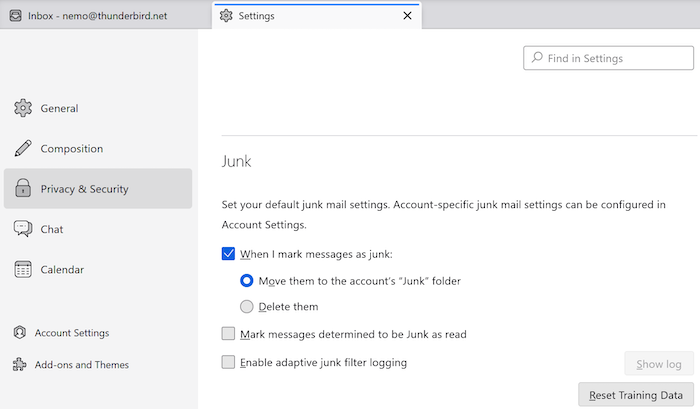
Per Account Settings
The junk settings for each of your email accounts will override similar settings in the Global Settings.
- Click the menu button (≡) > Account Settings > Your email address > Junk Settings.
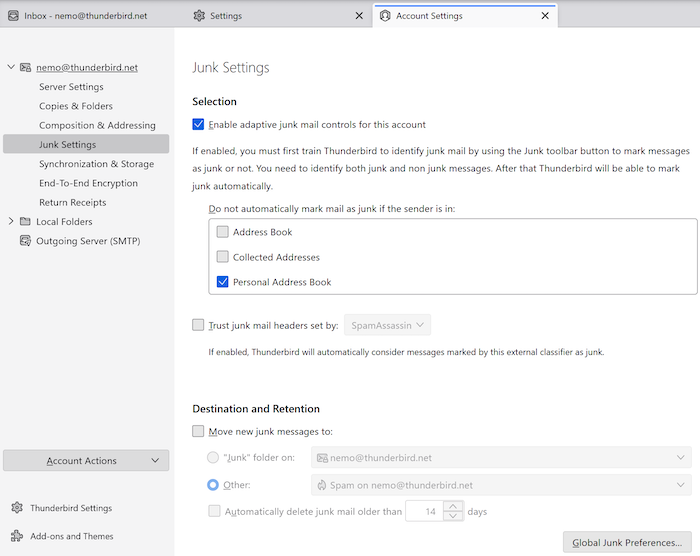
How to Turn Off Thunderbird’s Adaptive Filtering
To disable Thunderbird’s adaptive junk mail controls:
- Uncheck Enable adaptive junk mail controls for this account.
Whitelisting
Under Do not automatically mark mail as junk if the sender is in, you can select address books to use as a whitelist. Senders whose email addresses are in a whitelisted address book won’t be automatically marked as junk. However, you can still manually mark a message from a whitelisted sender as junk.
Enabling whitelisting is recommended to help ensure messages from people you care about are not marked as junk.
Training the Junk Filter
This part is important: for Thunderbird’s junk filter to be effective, you must train it to recognize both junk and non-junk messages. If you only do one or the other, the filter won’t be very effective.
It’s important to mark messages as junk before deleting them. Just deleting a message doesn’t train the filter.
Tell Thunderbird What IS Junk
There are several ways to mark messages as junk:
- Click on the junk icon in the Junk column of the Message List Pane:
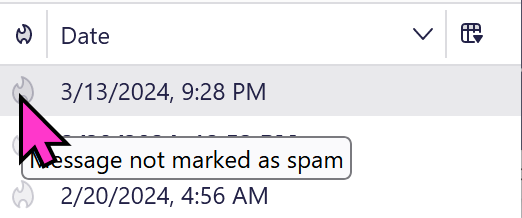
- Click the Junk button on the Message Header Pane:

- Press J on your keyboard to mark one or more selected messages as junk.
Once you mark a message as junk, if you’ve configured your Global Junk Settings or Per Account Settings to move junk email to a different folder, the email will disappear from the Message List Pane. Don’t worry, the email has moved to the folder you’ve configured for junk mail.
Thunderbird’s junk filter is designed to learn from the training data you provide. Marking more messages as Junk or Not Junk will improve the accuracy of your junk filter by adding more training data.
Tell Thunderbird What is NOT Junk
Sometimes Thunderbird’s junk filter might mark good messages as junk. It’s important to tell the filter which messages are not junk, especially on a new installation of Thunderbird.
Note: Frequently (daily or weekly) check your Junk folder for good messages wrongly marked as junk and mark them as Not Junk. This will recover the good messages and improve the filter’s accuracy.
There are several ways to mark messages as Not Junk:
- Click the Not Junk button in the yellow junk notification below the message header in the Message List Pane:

- Click the red junk icon in the Junk column of the Message List Pane to toggle the junk status of a message:
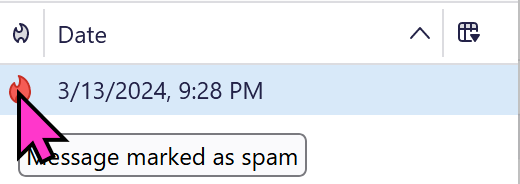
- Press Shift+J on your keyboard to mark one or more messages as Not Junk.
Once you unmark a message as junk, it will disappear from the current folder but will return to its original folder.
Repeated Training
Regularly train the filter by marking several good messages as not junk. This includes messages in your inbox and those filtered into other folders. Use the keyboard shortcut Shift+J for this, as the Not Junk button only appears for messages already marked as junk. Marking several messages per week will be sufficient, and you can select many messages to mark all at once.
Unfortunately, the user interface doesn’t indicate whether a message has already been marked as “not junk.”
Other Ways to Block Unwanted Messages
Thunderbird’s adaptive junk filter is not an absolute barrier against messages from specific addresses or types of messages. You can use stronger mechanisms to block unwanted messages:
Create Filters Manually
You can manually:
- Block some senders.
- Create filters to block messages based on subject or other criteria.
Use an External Filter Service
You can also use an external filter service to help classify email and block junk:
- Click the menu button (≡) > Account Settings > Your Account > Junk Settings.
- Enable the Trust junk mail headers set by option.
- Choose an external filter service from the drop-down menu.
The post Thunderbird and Spam appeared first on The Thunderbird Blog.
]]>The post Thunderbird for Android/ K-9 Mail: July and August 2024 Progress Report appeared first on The Thunderbird Blog.
]]>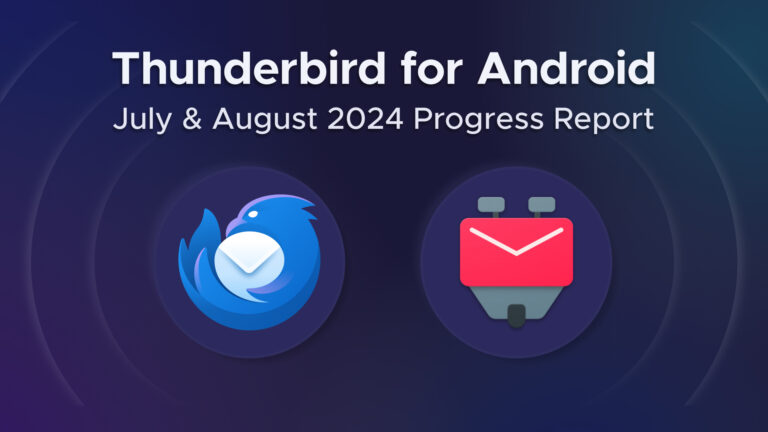
We’re back for an update on Thunderbird for Android/K-9 Mail, combining progress reports for July and August. Did you miss our June update? Check it out! The focus over these two months has been on quality over quantity—behind each improvement is significant groundwork that reduces our technical debt and makes future feature work easier to tackle.
Material 3 Update
As we head towards the release of Thunderbird for Android, we want you to feel like you are using Thunderbird, and not just any email client. As part of that, we’ve made significant strides toward compatibility with Material 3 to better control coloring and give you a native feel. What do you think so far?
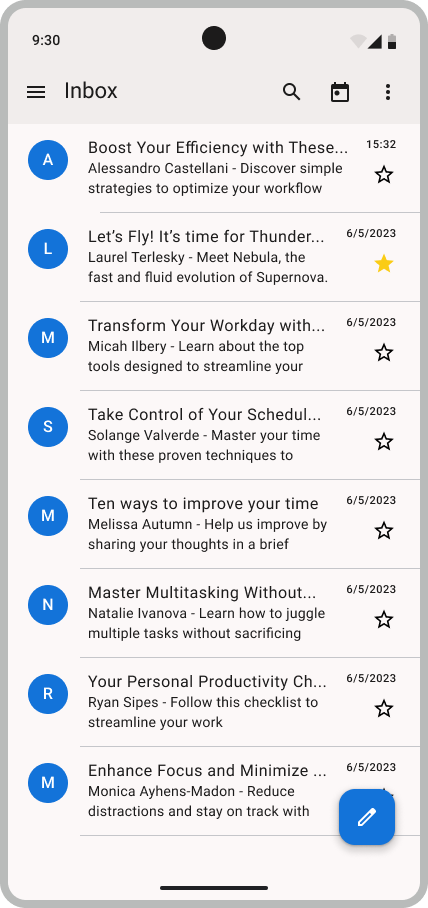
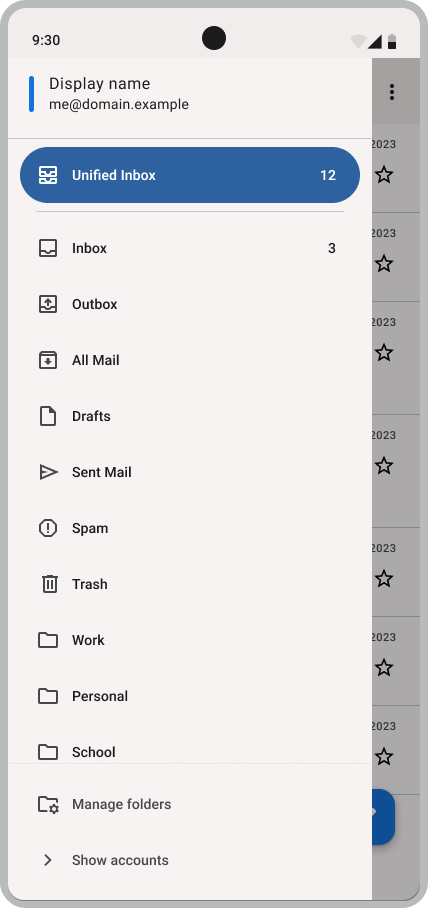
The final missing piece is the navigation drawer, which we believe will land in September. We’ve heard your feedback that the unread emails have been a bit hard to see, especially in dark mode, and have made a few other color tweaks to accompany it.
Feature Modules
If you’ve considered contributing as a developer to Thunderbird for Android, you may have noticed many intertwined code modules that are hard to tackle without intricate knowledge of the application. To lower the barrier of entry, we’re continuing the move to a feature module system and have been refactoring code to use them. This shift improves maintainability and opens the door for unique features specific to Thunderbird for Android.
Ready to Play
Having a separate Thunderbird for Android app requires some setup in various app-stores, as well as changes to how apps are signed. While this isn’t the fun feature work you’d be excited to hear about, it is foundational to getting Thunderbird for Android out of the door. We’re almost ready to play, just a few legal checkboxes we need to tick.
Documentation
K-9 Mail user documentation has become outdated, still referencing older versions like K-9 Mail 6.4. Given our current resources, we’ve paused updates to the guide, but if you’re passionate about improving documentation, we’d love your help to bring it back online! If you are interested in maintaining our user documentation, please reach out on the K-9 Forums.
Community Contributions
We’ve had a bunch of great contributions come in! Do you want to see your name here next time? Learn how to contribute.
- Community contribution from msizanoen1 to move a file to its correct location.
- Thank you to Husain for improving our email validation when composing messages.
- Kudos to Mino for suggesting some changes to mime type inference.
- Great job riskrose for making some of the comments more readable.
- SuGotLand and Abdul are helping users to keep the bird flying by avoiding two crashes.
- Increased clarity thanks to Akash, who has refined some network error messages.
The post Thunderbird for Android/ K-9 Mail: July and August 2024 Progress Report appeared first on The Thunderbird Blog.
]]>The post Why Use a Mail Client vs Webmail appeared first on The Thunderbird Blog.
]]>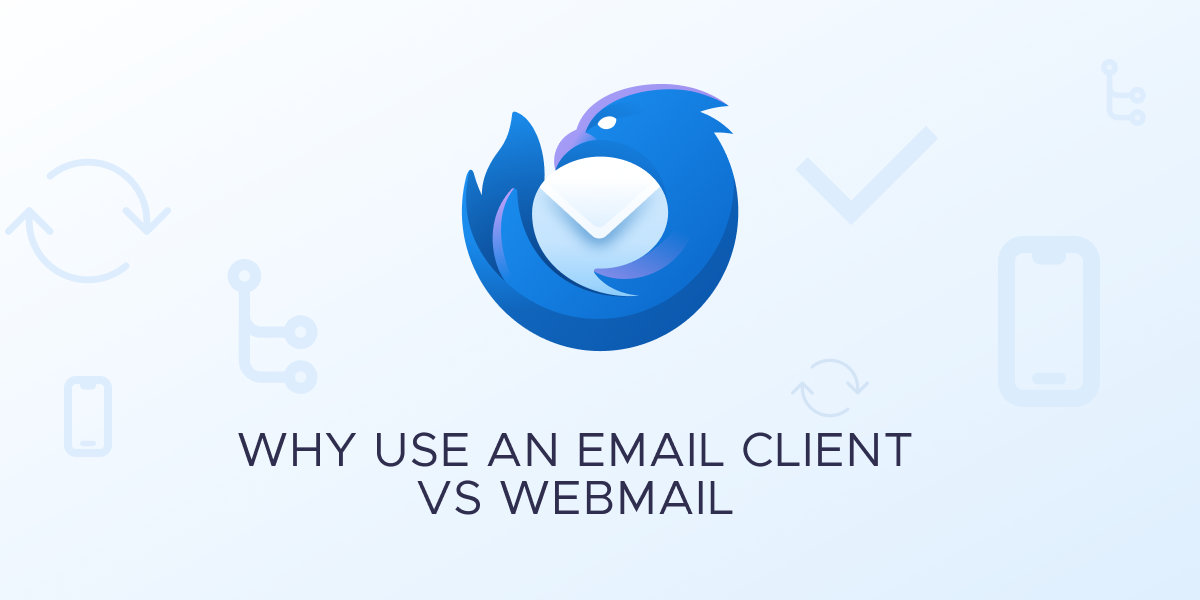
Many of us Thunderbird users often forget just how convenient using a mail client can be. But as webmail has become more popular over the last decade, some new users might not know the difference between the two, and why you would want to swap your browser for a dedicated app.
In today’s digital world, email remains a cornerstone of personal and professional communication. Managing emails, however, can be a daunting task especially when you have multiple email accounts with multiple service providers to check and keep track of. Thankfully, decades ago someone invented the email client application. While web-based solutions have taken off in recent years, they can’t quite replace the need for managing emails in one dedicated place.
Let’s go back to the basics: What is the difference between an email service provider and an email client application? And more importantly, can we make a compelling case for why an email client like Thunderbird is not just relevant in today’s world, but essential in maintaining productivity and sanity in our fast-paced lives?
An email service provider (ESP) is a company that offers services for sending, receiving, and storing emails. Popular examples include Gmail, Yahoo Mail, Hotmail and Proton Mail. These services offer web-based interfaces, allowing users to access their emails from any device with an internet connection.
On the other hand, an email client application is software installed on your device that allows you to manage any or all of those email accounts in one dedicated app. Examples include Thunderbird, Microsoft Outlook, and Apple Mail. Email clients offer a unified platform to access multiple email accounts, calendars, tasks, and contacts, all in one place. They retrieve emails from your ESP using protocols like IMAP or POP3 and provide advanced features for organizing, searching, and composing emails.
Despite the convenience of web-based email services, email client applications play a huge role in enhancing productivity and efficiency. Webmail is a juggling game of switching tabs, logins, and sometimes wildly different interfaces. This fragmented approach can steal your time and your focus.
So, how can an email client help with all of that?
One Inbox – All Your Accounts
As already mentioned, an email client eliminates the need to switch between different browser tabs or sign in and out of accounts. Combine your Gmail, Yahoo, and other accounts so you can read, reply to, and search through the emails using a single application. For even greater convenience, you can opt for a unified inbox view, where emails from all your different accounts are combined into a single inbox.
Work Offline – Anywhere
Email clients store your emails locally on your device, so you can access and compose emails even without an internet connection. This is really useful when you’re travelling or in areas with poor connectivity. You can draft responses, organize your inbox, and synchronize your changes once you’re back online.
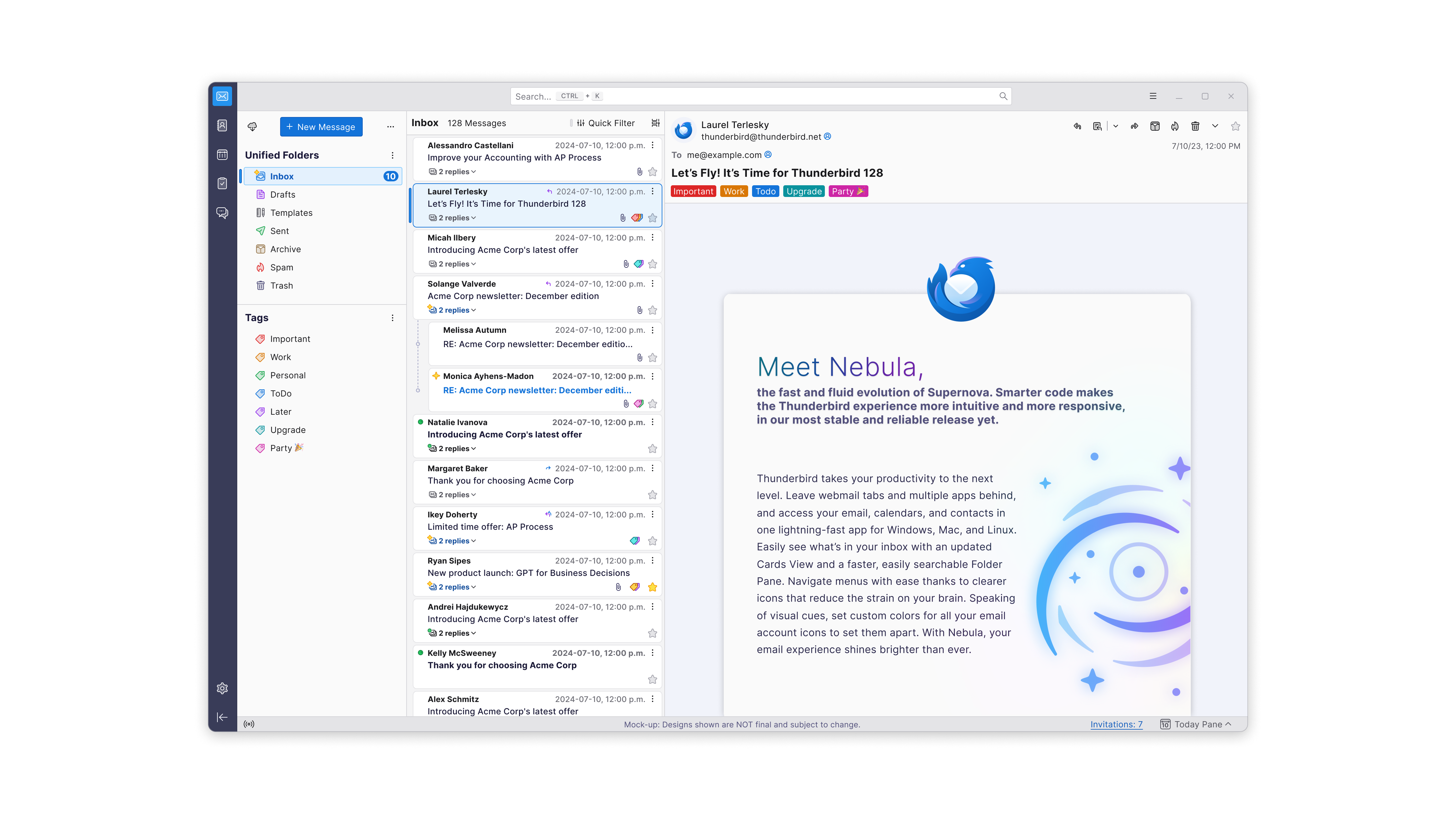
Enhanced Productivity
Email clients come packed with features designed to boost productivity. These include advanced search capabilities across multiple accounts, customizable filters and rules, as well as integration with calendar and task management tools. Features like email templates and delayed sending can streamline your workflow even more.
Care About Privacy?
Email clients offer enhanced security features, such as encryption and digital signatures, to protect your sensitive information. With local storage, you have more control over your data compared to relying solely on a web-based ESP.
No More Clutter and Distractions
Web-based email services often come with ads, sometimes disguised as emails, and other distractions. Email clients, on the other hand, provide a cleaner ad-free experience. It’s just easier to focus with a dedicated application just for email. Not having to reply on a browser for this purpose means less chance of getting sidetracked by latest news, social media, and random Google searches.
All Your Calendars in One Place
Last but not least, managing your calendar, or multiple calendars, is easier with an email client. You can sync calendars from various accounts, set reminders, and schedule meetings all in one place. This is particularly useful when handling calendar invites from different accounts, as it allows you to easily shift meetings between calendars or maintain one main calendar to avoid double booking.
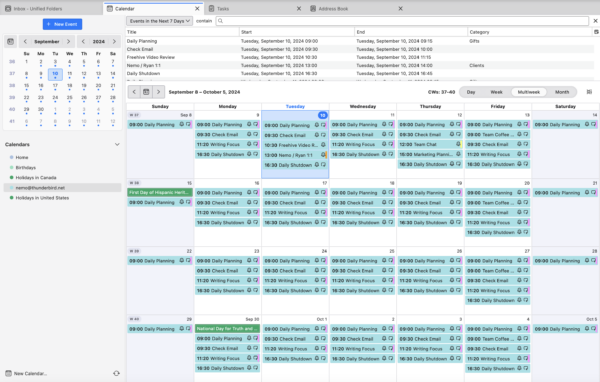
So, if you’re not already using an email client, perhaps this post has given you a few good reasons to at least try it out. An email client can help you organize your busy digital life, keep all your email and calendar accounts in one place, and even draft emails during your next transatlantic flight with non-existent or questionable Wi-Fi.
And just as email itself has evolved over the past decades, so have email client applications. They’ll adapt to modern trends and get enhanced with the latest features and integrations to keep everyone organized and productive – in 2024 and beyond.
The post Why Use a Mail Client vs Webmail appeared first on The Thunderbird Blog.
]]>The post Thunderbird Monthly Development Digest: August 2024 appeared first on The Thunderbird Blog.
]]>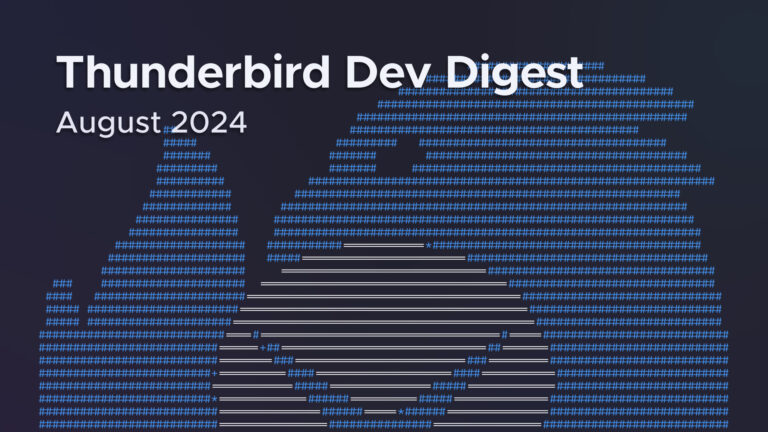
Hello Thunderbird Community! It’s August, where did our summer go? (or winter for the folks on the other hemisphere).
Our August has been packed with ESR fixes, team conferences, and some personal time off, so this is gonna be a bit of a shorter update, tackling more upcoming efforts than what recently landed on daily. Miss our last update? Find it here.
More Rust
If you’ve been looking at our monthly metrics you might have noticed that the % of Rust code in our code base is slowly increasing.
We’re planning to push forward this effort in the near future with more protocol reworks and clean up of low level code.
Stay tuned for more updates on this matter and some dedicated posts from the engineers that are driving this effort.
Pushing forward with Exchange
Nothing new to report here, other than that we’re continuing with this implementation and we hope to be able to enable this feature by default in a not so far off Beta.
The general objective before next ESR is to have complete email support and start tapping into Calendar and Address Book integration to offer the full experience out of the box.
Global database
This is also one of the most important pieces of work that we’ve been planning for a while. Bringing this to completion will drastically reduce our most common data loss problems as well as drastically speeding up the performance of Thunderbird when it comes to internal message search and archiving.
Calendar rebuild
Another very large initiative we’re kicking off during this new ESR cycle is a complete rebuild of our Calendar.
Not only are we going to clean up and improve our back-end code handling protocols and synchronization, but we’re also taking a hard look at our UI and UX, in order to provide a more flexible and intuitive experience, reducing the amount of dialogs, and implementing those features that users have come to expect from any calendaring application.
As usual, if you want to see things as they land you can always check the pushlog and try running daily, which would be immensely helpful for catching bugs early.
See ya next month.
Alessandro Castellani (he, him)
Director, Desktop and Mobile Apps
If you’re interested in joining the technical discussion around Thunderbird development, consider joining one or several of our mailing list groups here.
The post Thunderbird Monthly Development Digest: August 2024 appeared first on The Thunderbird Blog.
]]>The post Plan Less, Do More: Introducing Appointment By Thunderbird appeared first on The Thunderbird Blog.
]]>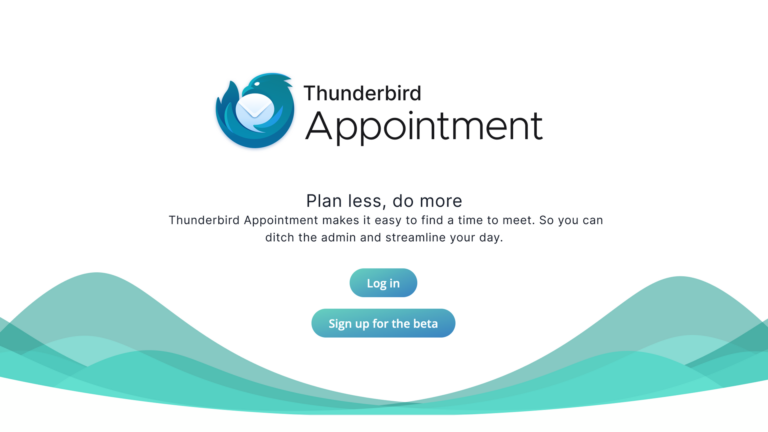
We’re excited to share a new project we’ve been working on at Thunderbird called Appointment. Appointment makes it simple to schedule meetings with anyone, from friends and family to colleagues and strangers. Escape the endless email threads trying to find a suitable meeting time across multiple time zones and organizations.
With Appointment, you can easily share your customized availability and let others schedule time on your calendar. It’s simple and straightforward, without any clutter.
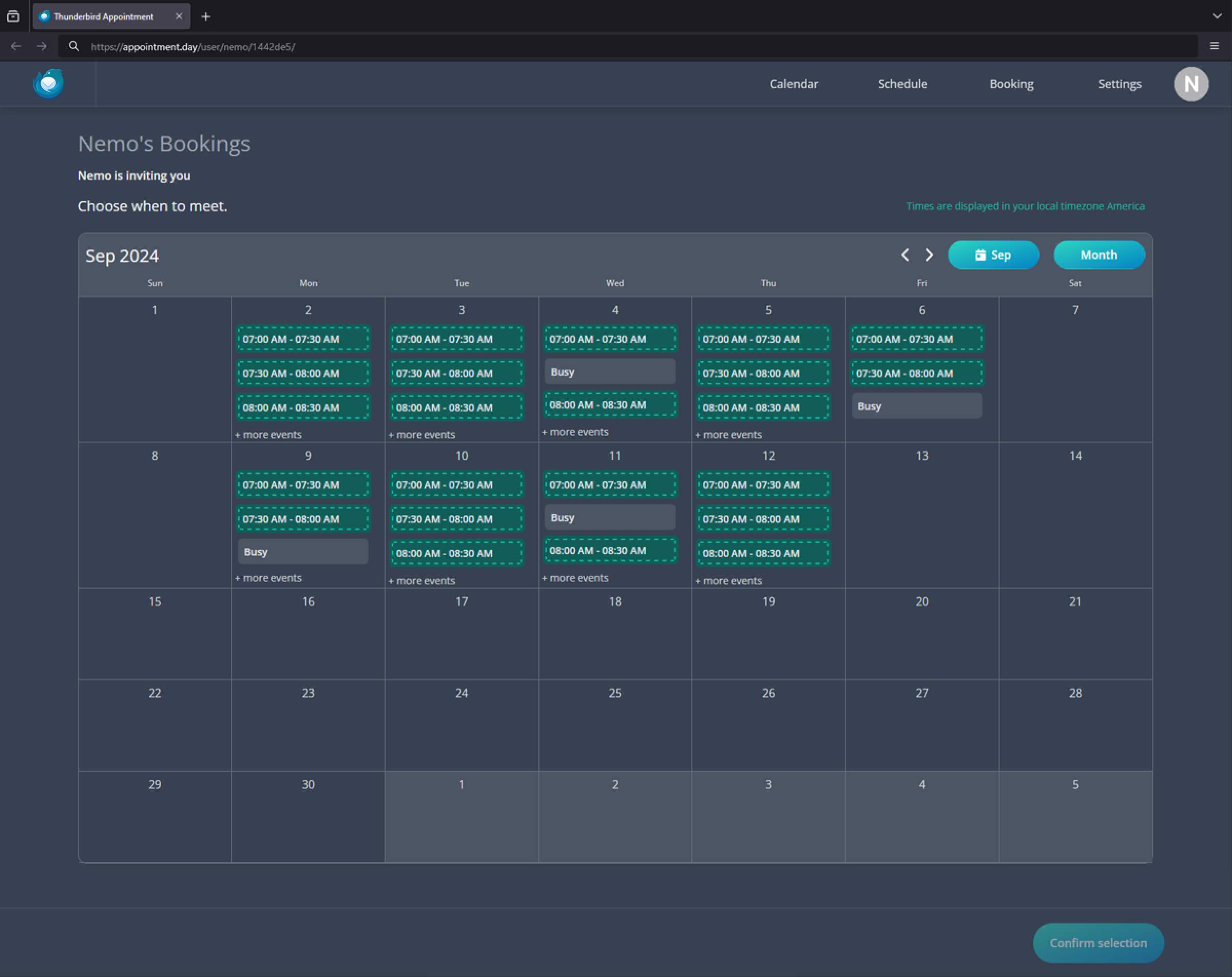
If you have tried similar tools, Appointment will feel familiar, while capturing what’s unique about Thunderbird: it’s open source and built on our fundamental values of privacy, openness, and transparency. In the future, we intend for Appointment to be part of a wider suite of helpful products enhancing the core Thunderbird experience. Our ambition is to provide you with not only a first-rate email application but a hub of productivity tools to make your days more efficient and stress-free.
We’ll be rolling out Appointment in phases, continuing to improve it as we open up access to more people. It’s currently in closed beta, so we encourage you to sign up for our waiting list. Let us know what features you find valuable and any improvements you’d like to see. Your feedback will be invaluable as we make this tool as useful and seamless as possible.
To that end, the development repository for Appointment is publicly available on Github, and we encourage any future testers or contributors to get involved and build this with us.
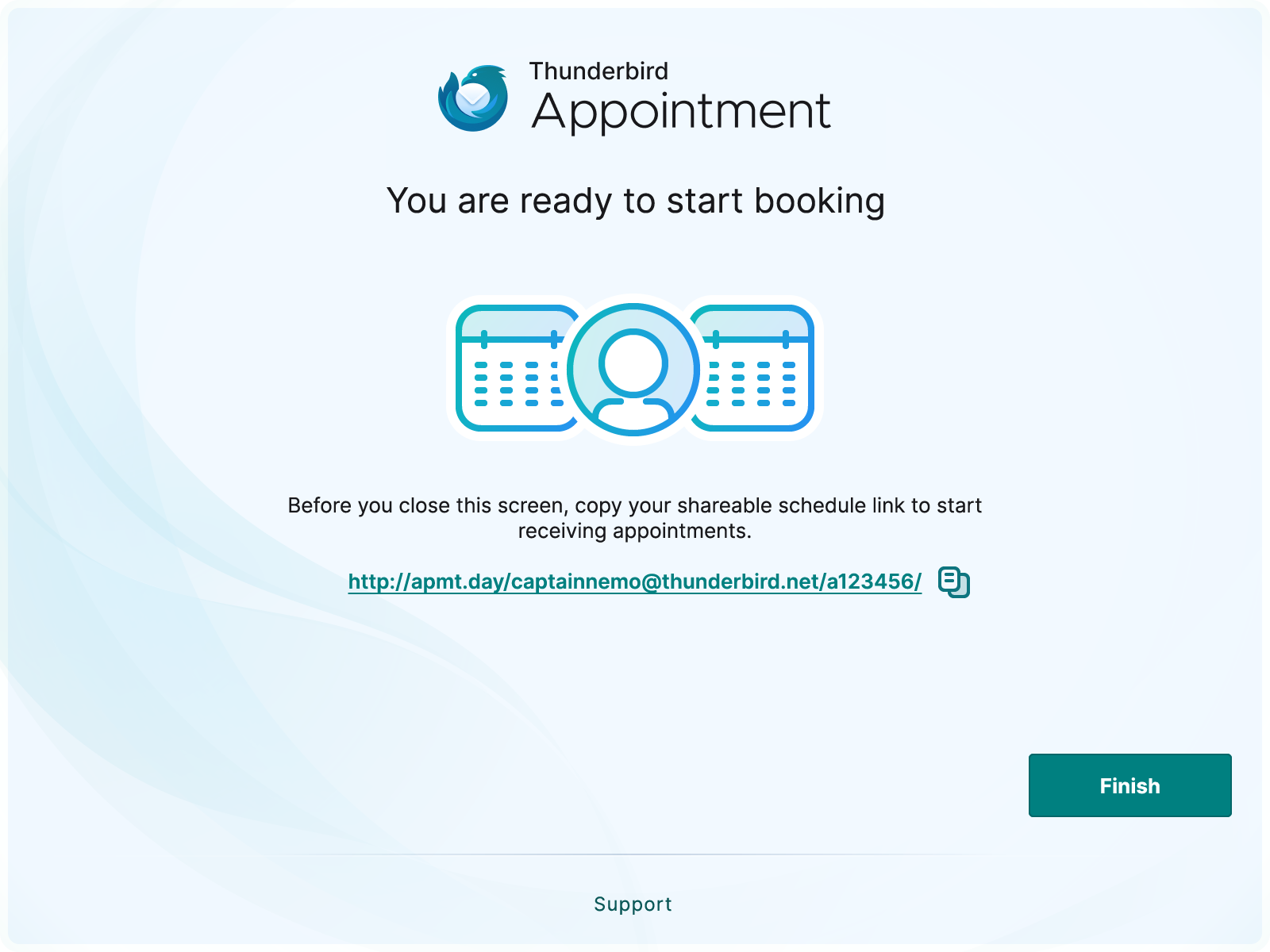
Free yourself from cluttered scheduling apps and never-ending email threads. The simplicity of Appointment lets you find that perfect meeting time, without wasting your precious time.
The post Plan Less, Do More: Introducing Appointment By Thunderbird appeared first on The Thunderbird Blog.
]]>The post VIDEO: How to Answer Thunderbird Questions on Mozilla Support appeared first on The Thunderbird Blog.
]]>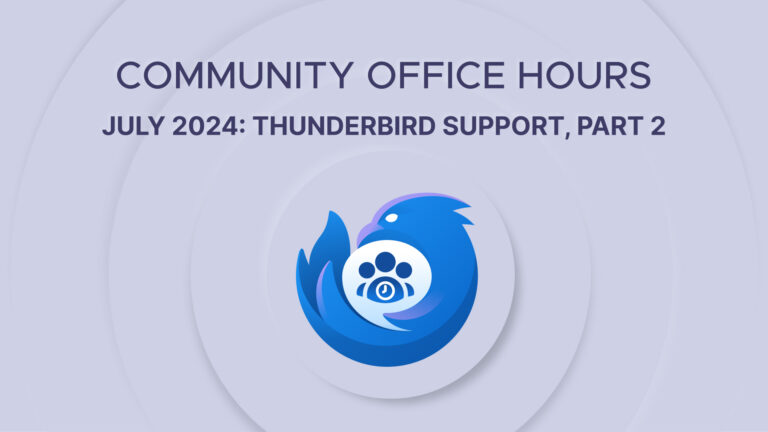
Not all heroes wear capes. Some of our favorite superheroes are the community members who provide Thunderbird support on the Mozilla Support (SUMO) forums. The community members who help others get to the root of their problems are everyday heroes, and this video shows what it takes to become one of them. Spoiler – you don’t need a spider bite or a tragic origin story! All it takes is patience, curiosity, and a little work.
In our next Office Hours, we’ll be chatting with our Thunderbird Council! One week before we record, we’ll put out a call for questions on social media and on the relevant TopicBox mailing lists. And if you have an idea for an Office Hours you’d like to see, let us know in the comments or email us at officehours@thunderbird.net.
Office Hours: Thunderbird Support (Part 2)
In the sleeper sequel hit of the summer, we sat down to chat with Wayne Mery, who in addition to his work with releases, is our Community Manager as well. Like Roland, Wayne has been with the project practically from the start, and was one of the first MZLA employees. If you’ve spent any time on SUMO, our subreddit, or Bugzilla, chances are you’ve seen Wayne in action helping users.
In this chat and demo, Wayne walks us through the steps to becoming a support superhero. The SUMO forums are community-driven, and (every additional contributor means more knowledge and hopefully fewer unanswered questions.) (This would be a good sport for something about the power of community in open source, and how many of us who got into open source as a career started as volunteers in forums like these.)
The video includes:
- The structure and markup language of the SUMO Forums
- How to find questions that need answering
- Where to meet and chat with other volunteers online
- A demonstration of the forum’s workflow
- A very helpful DOs and DON’Ts guide
- A demo where Wayne answers new questions to show his advice in action
Watch, Read, and Get Involved
This chat helps demystify how we and the global community provide support for Thunderbird users. We hope it and the included deck inspire you to share your knowledge, experience, and problem-solving skills. It’s a great way to get involved with Thunderbird – whether you’re a new or experienced user!
VIDEO (Also on Peertube):
WAYNE’S PRESENTATION:
The post VIDEO: How to Answer Thunderbird Questions on Mozilla Support appeared first on The Thunderbird Blog.
]]>The post Maximize Your Day: Templates to the Rescue appeared first on The Thunderbird Blog.
]]>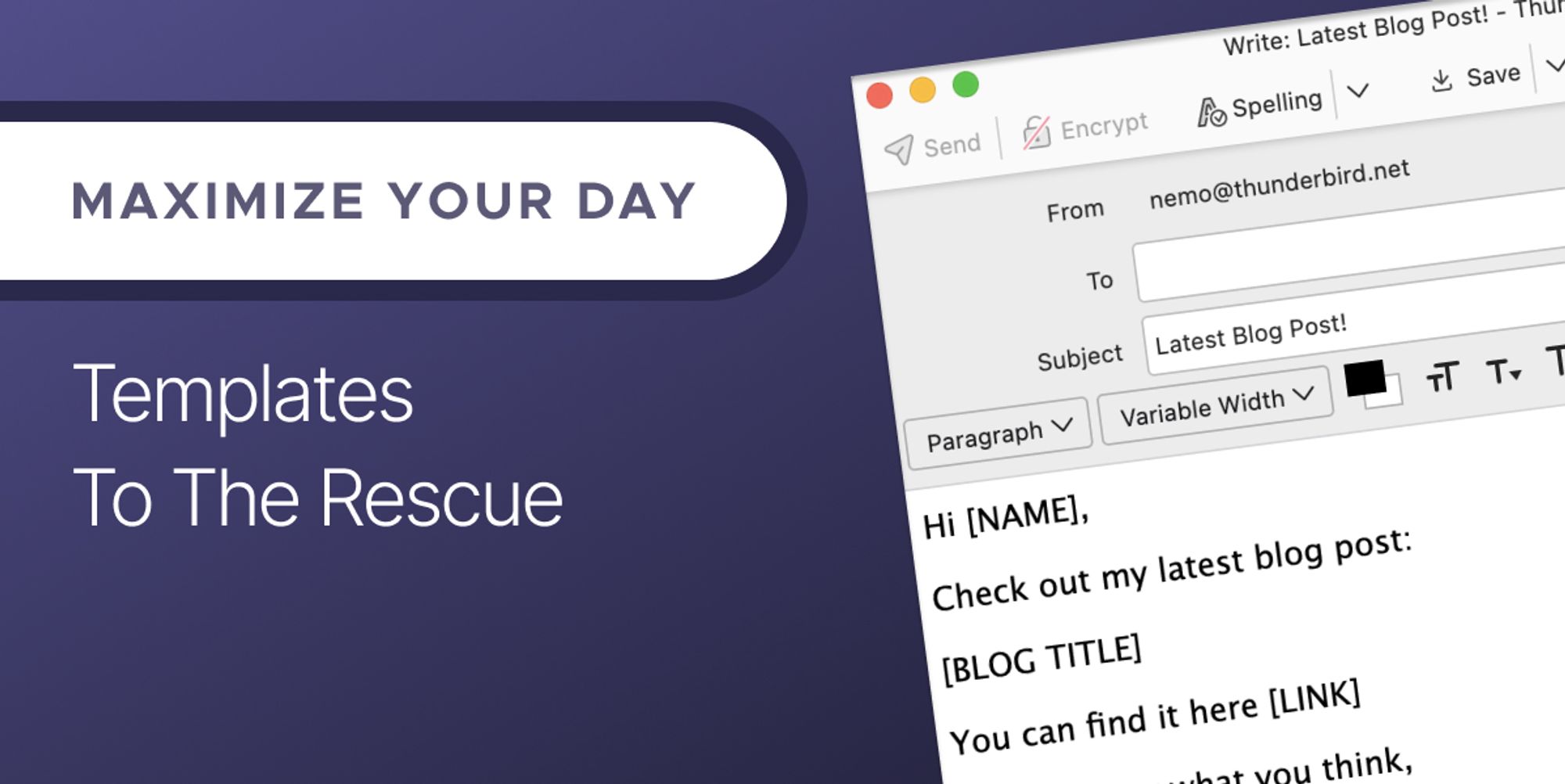
Hello! We’re back for the summer edition of our productivity series, and we’re here with a productivity tip that can save you time AND reduce email anxiety-induced procrastination. We’re talking about email templates.
Marketing and Comms Manager Natalie Ivanova shared why she’s a huge fan of email templates. When one of her three kids are sick, their school requires an email with lots of important details – their teacher’s name, their class number, and class division. She’d hunt through her sent messages for the last sick day email, then have to look up any new info for those key details. More often than not, this search led to procrastinating, which led to an annoyed phone call from her kid’s school.
To take the stress out of these emails, Natalie turned to templates. Templates take the hard work out of writing an email. Instead of facing a dreaded blank page, you have a structure you created, and all you have to do is fill in the blanks. In her case, she made a template for each kid, filled it with the info the school needed, and left blanks for any fields that would change.
Whether you’re updating teachers, sending regular updates to colleagues, or otherwise sending something over and over, let Thunderbird and the power of templates do the heavy lifting.
Creating a Template
Creating a template is a lot like writing an email. Click on ‘New Messages’ to get started. If your template is meant for one recipient – for example, your kid’s school – go ahead and enter the address. Your Subject Line will be how you find your template later – and can be part of the template itself! For a monthly report I send about Thunderbird in the media, I use ‘Media Sentiment Summary [MONTH YEAR]. It’s easy to find AND easy to change. You could almost say it’s magic!
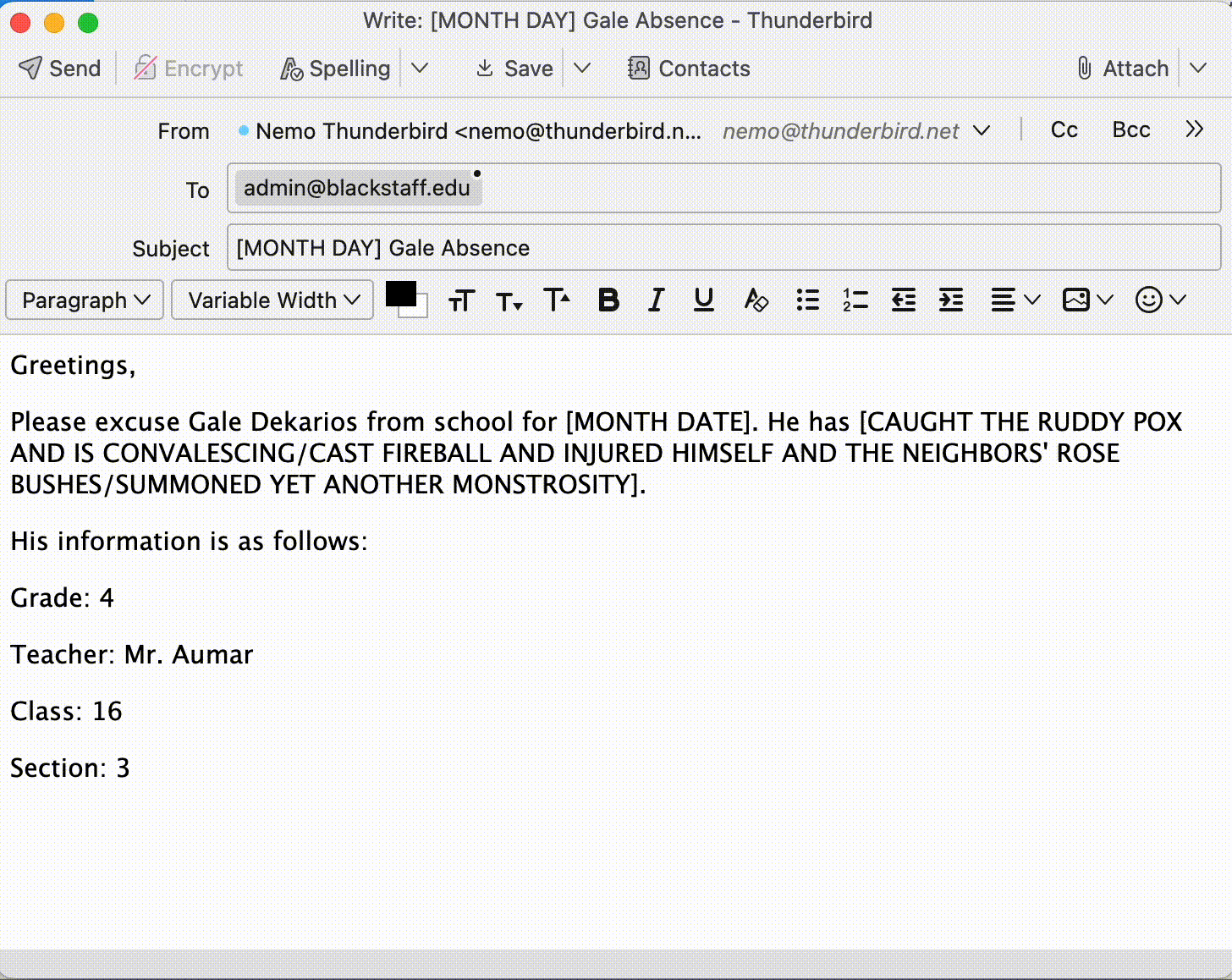
The body of your email is where you put the power of templates to work. For the sick kid template, most of the information is already there. All you need to do is literally hit send. For that monthly report, I put the fields I need to fill in brackets (with text in ALL CAPS to help me notice it and avoid the shame of sending an unedited template), both in the subject and the body.
Writing an Email from Templates
So, you’ve made a template. Yay!
Now, how do you use it?
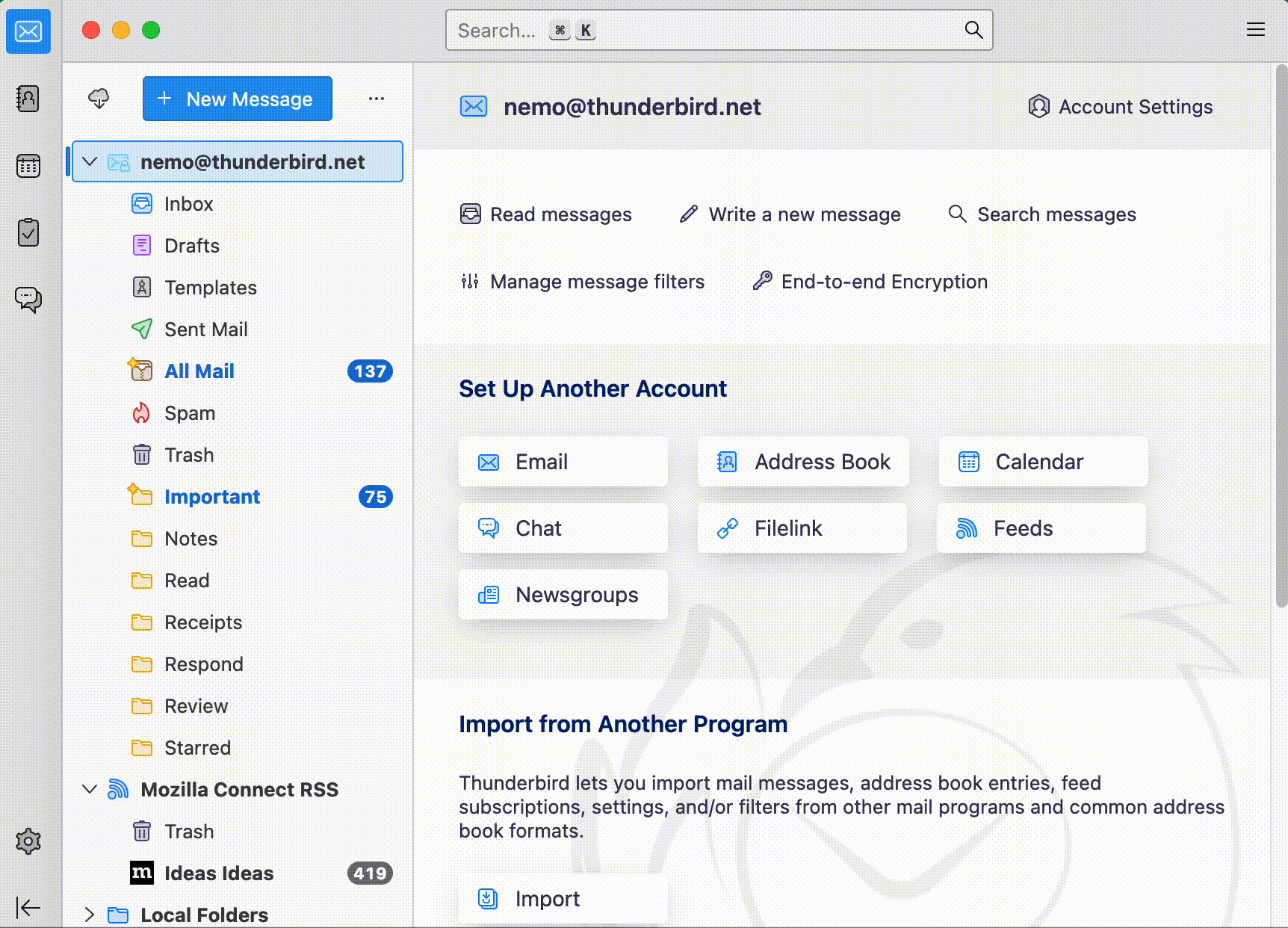
Thunderbird makes it very easy to find your new template. It lives in the ‘Templates’ folder in the Folder Pane window, just below the Drafts folder. Click on the Templates folder to open it, and click on the Message Menu in the upper right corner. Click ‘New Message from Template’, and your template is ready to edit and send. And every time you use your template, YOU are ready to have more time and less stress.
More Resources!
- The Muse has templates to make networking less intimidating
- Inflow explains how templates reduce email anxiety and help those with ADHD
- A Redditor created an outstanding collection of email templates to reduce email anxiety!
The post Maximize Your Day: Templates to the Rescue appeared first on The Thunderbird Blog.
]]>The post Thunderbird goes to GUADEC 2024 appeared first on The Thunderbird Blog.
]]>
GUADEC is the annual GNOME conference and this year it was in beautiful Denver, Colorado. Why are we writing about this on the Thunderbird blog? I’m so glad you asked. Thunderbird was there and our very own Ryan Sipes gave a compelling keynote talk!
Ryan’s GUADEC 2024 Keynote
Ryan gave a brief history lesson of Thunderbird, detailed how we survived tough times, and what exciting new things we are working on, including our recent Supernova release.
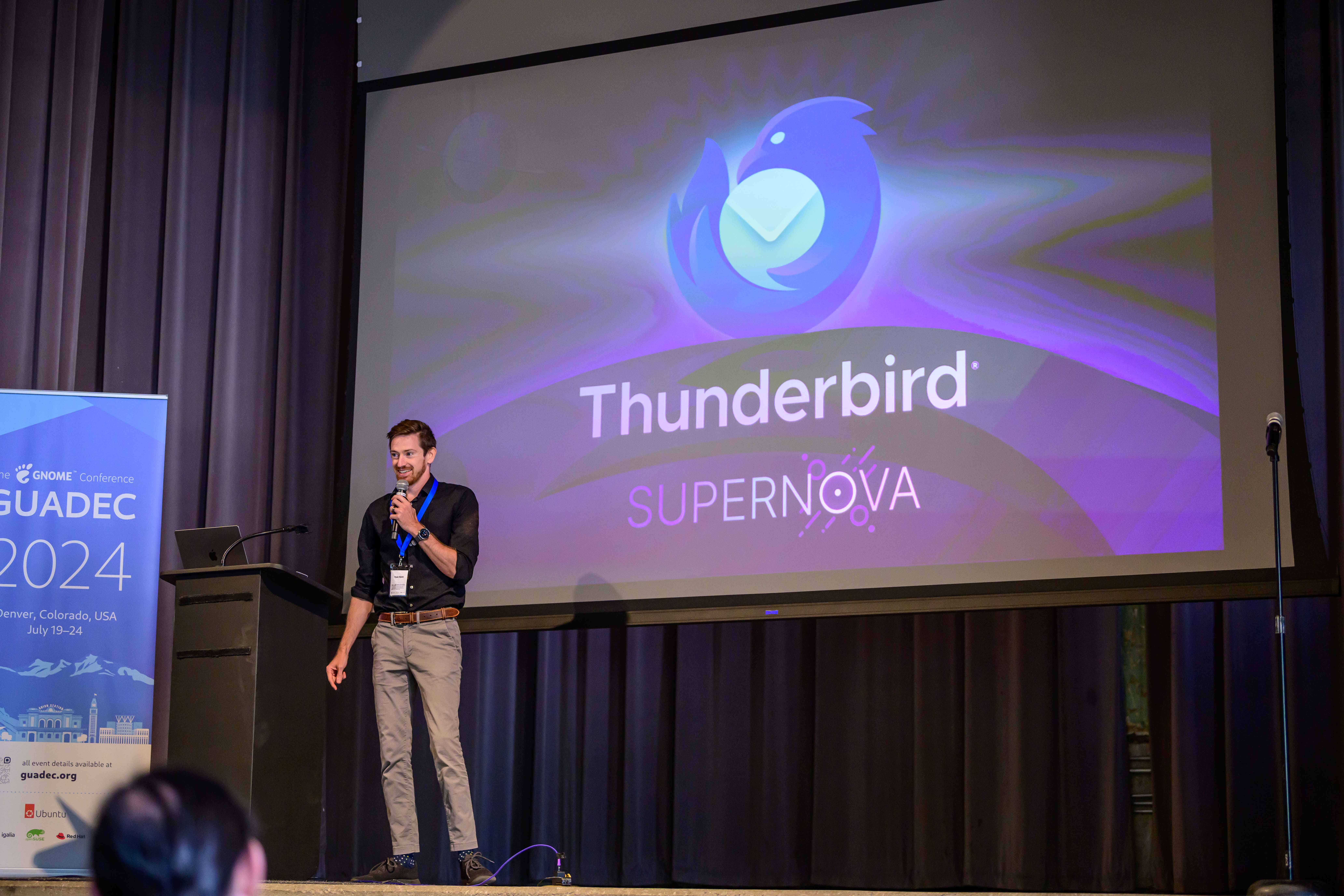
While Thunderbird is cross platform, Ryan highlighted our current focus on native integration with Linux systems, starting with an initial implementation of a Linux system tray icon. We are committed to our Linux users more than ever, no matter their choice of desktop environment, packaging type, or flavor of Linux.
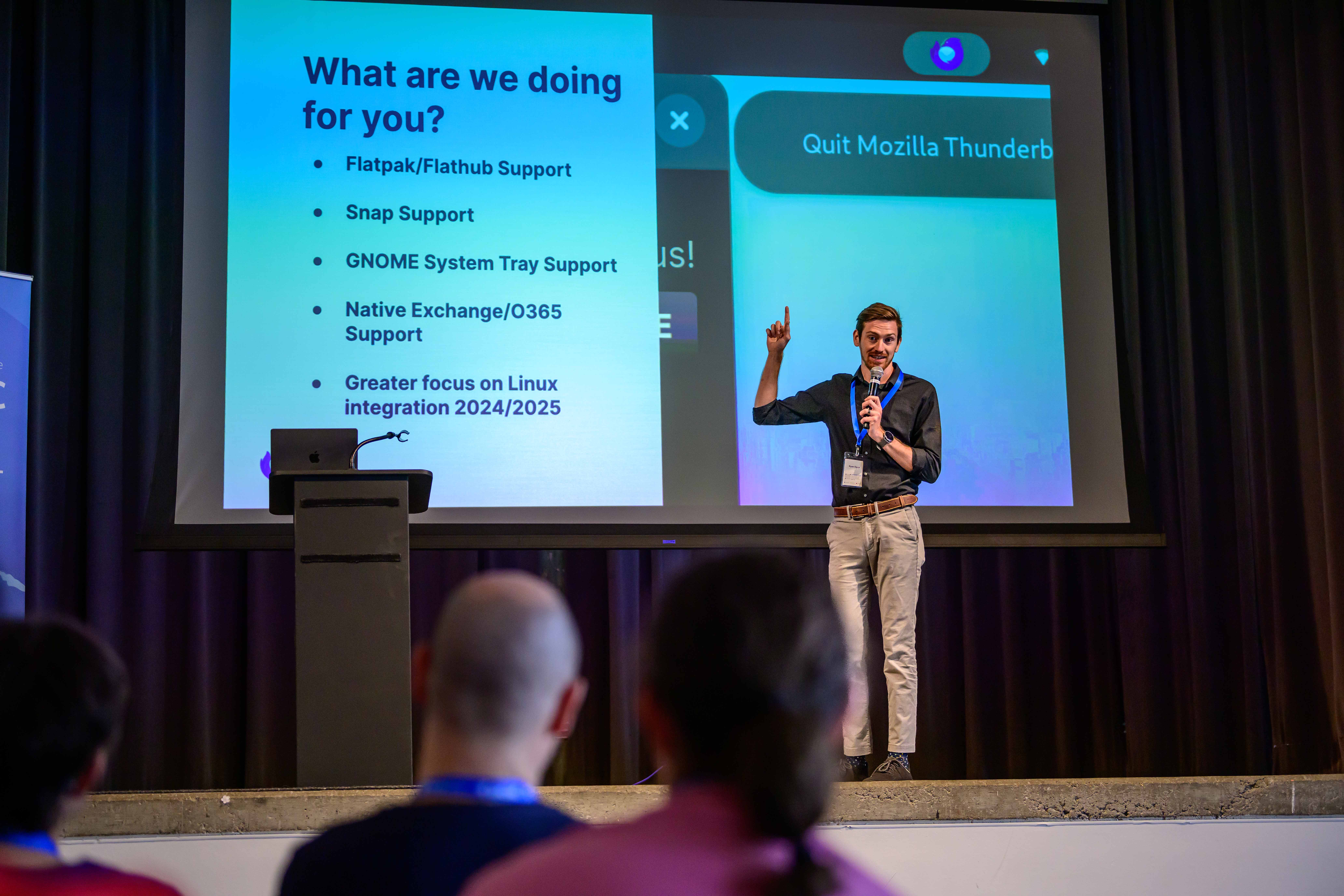
Thunderbird in the Hallway Track
Besides Ryan’s talk, there were several meaningful conversations, relevant to various aspects of Thunderbird.
- There are shared struggles between our calendar and GNOME calendar, revealing opportunities to work together towards a common solution.
- Since the Thunderbird flatpak is one of our supported packages for Linux systems, it was great to hear an update from the flatpak and xdg-desktop-portals developers. We can start to think of how we can leverage recent and upcoming changes to portals to improve the Thunderbird flatpak.
- Ryan’s talk pointed out our need for privacy respecting telemetry, and it turns out that is shared by the GNOME app developers as well. Expect to hear more about this in future blog posts, as events develop.
Overall, this year’s GUADEC was an excellent week of collaboration, where we shared many wonderful ideas and strengthened our comradery. Thunderbird’s presence at this conference showed us where we can work with the broader GNOME community and support one another in a way that benefits all of our users. We thank the GNOME foundation for the excellent organization.

Let the collaboration continue!
The post Thunderbird goes to GUADEC 2024 appeared first on The Thunderbird Blog.
]]>The post Thunderbird Monthly Development Digest: July 2024 appeared first on The Thunderbird Blog.
]]>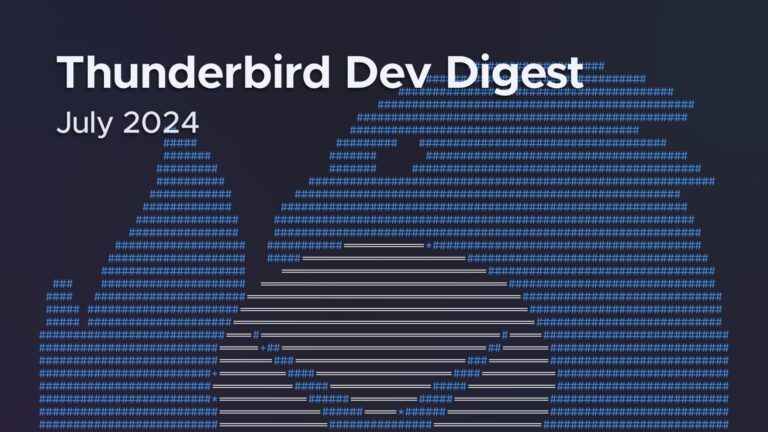
Hello Thunderbird Community! As we say goodbye to the month of July, we look back at our major accomplishments and the release of a new ESR version.
ESR Released!
Thunderbird 128 “Nebula” is finally out and we couldn’t be more thrilled.
We fixed more than 1400 bugs, included multiple new features, cleaned up a lot of old code, and enabled Rust development. There’s too much to list so if you’re interested please visit our fancy 128 What’s New Page, blog post, and Release notes to get a much deeper overview of all the juicy things you will get.
We do lots of QA and beta testing, but sometimes major issues are only exposed after significant public testing. That’s why we always roll out a new ESR release gradually. Once we’re confident no problems or regressions exist, we’ll turn on automatic updates — probably towards the end of August.
However, we have enabled manual updates for Windows and macOS users. If you open the About dialogue, you should receive a prompt to update.
If you’re using Flatpak or Snap on Linux, you are probably on version 128 already. For those who receive Thunderbird updates through their Linux distribution’s repositories, the experience may vary depending on the package maintainer. We don’t have control over that, so please reach out to your distro’s maintainer and ask if they have a timeline.
Linux System Tray
A 25-year-old bug was finally fixed!
If you’re running Daily on Linux, you probably noticed a fancy new system tray icon with a quick action to shut down Thunderbird. This is merely the first step towards a more native integration of Thunderbird inside your operating system, not just Linux.
Stay tuned for more improvements and expansion of this new feature. We promise we’ll try to not take another 25 years!
Folder Compaction Cleanup
Our fight to improve folder compaction and solve for good the issue of tmp files bubbling up in size seems to have come to an end. It was challenging to identify the problem, and even more to create a consistent reproducible scenario.
As all the users affected seem to confirm the disappearance of the issue, we took some time to create a migration to clean up those large leftover temporary files polluting your profile.
We’re gonna run this code in Daily and Beta for a few more weeks to make sure it’s safe and tested properly before uplifting it to ESR.
Exchange
As we continue the implementation of a few more features to make sure the full experience is reliable and complete-looking, we decided to switch the preference ON by default on Daily, in order to invite more testing and gather feedback and bugs as early as possible.
If you’re running Daily and have an Exchange account, please consider setting it up in Thunderbird and report any bug you might encounter.
As usual, if you want to see things as they land you can always check the pushlog and try running daily, which would be immensely helpful for catching bugs early.
See ya next month,
Alessandro Castellani (he, him)
Director, Desktop and Mobile Apps
If you’re interested in joining the technical discussion around Thunderbird development, consider joining one or several of our mailing list groups here.
The post Thunderbird Monthly Development Digest: July 2024 appeared first on The Thunderbird Blog.
]]>The post Meet The Thunderbird Team: Sol Valverde, UI/UX Designer appeared first on The Thunderbird Blog.
]]>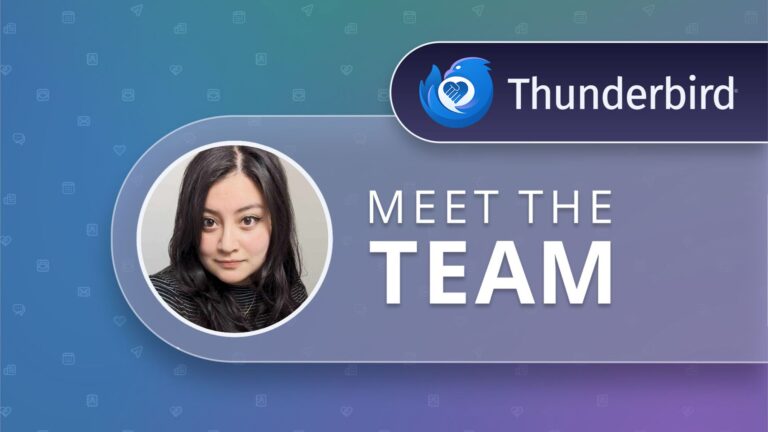
Welcome back to our Meet The Team series! I recently had a very entertaining conversation with Sol Valverde, one of the creative minds behind Thunderbird’s user experience and interface design. During our chat, Sol explained how growing up around developers influenced her career path, and discusses the thought process behind designing and improving Thunderbird’s visuals.
Sol also shared a hilarious and heartwarming anecdote about her family’s reaction to her joining our team. It’s a story that underscores the importance of maintaining core Thunderbird features that long-time users rely on, while still modernizing the interface.
For the best and most complete experience, listen to our entire conversation above. Or, you can read select excerpts below.
Q: Can you start by sharing your origin story? How did you end up in UI/UX design?
A: As a kid I always used to draw a lot. I did want to become uh some sort of artistic area professional. However, I do come from a family of programmers. My dad and uncle are both developers. My uncle, he’s been a huge Thunderbird fan for 20 years. But when he found out I got the job he was terrified. He was like “oh my God that’s cool! And also please don’t change anything. It’s perfect the way it is. Don’t touch it!”
Q: What does your role entail?
A: I tend to take the first pass at evaluating how a user is going to interact with something. Like for example the first user experience. When I look at the screen, of course I want to make sure it’s attractive. But I ask things like “will the user understand what they need to do in this screen? Is it intuitive?”
A good experience is potentially one that you will forget. Because if you remember, it probably means that you struggled.
Sol Valverde
Q: How do you ensure that a design is intuitive for users?
A: I love the example of a door. If you have a door without a handle, you can assume it should be pushed. But how do you interact with a door if you don’t know? A lot of doors have “Push” or “Pull” signs. But then you kind of also get the extra interaction with the handle. Sometimes it’s a handle you can grab, but sometimes it’s just a bar that has to be pushed. The design lets you know intuitively what should be done, without needing to read anything. We want to guide the user without hiding anything from the user.
I grew up and learned by grabbing things, breaking things, interacting with them. And that kind of learning for me is crucial. So if the user is going to come into this room and and learn what I want them to learn, I have to make it easy for them to figure it out. I do a lot of research. If I’m working on K-9 Mail, for example, I not only look at other email apps, but also at various social media apps. How easy it to switch accounts? What do I dislike about those applications?
Q: Are there any mobile apps that stand out? Where the user experience is so straightforward there wasn’t any kind of learning curve?
A: The simpler ones tend to be the most intuitive ones. So for example, when you’re using an app to read comics or manga, you tap the book you want, and then you swipe back and forth to turn the pages. Like mimicking the physical actions of reading.
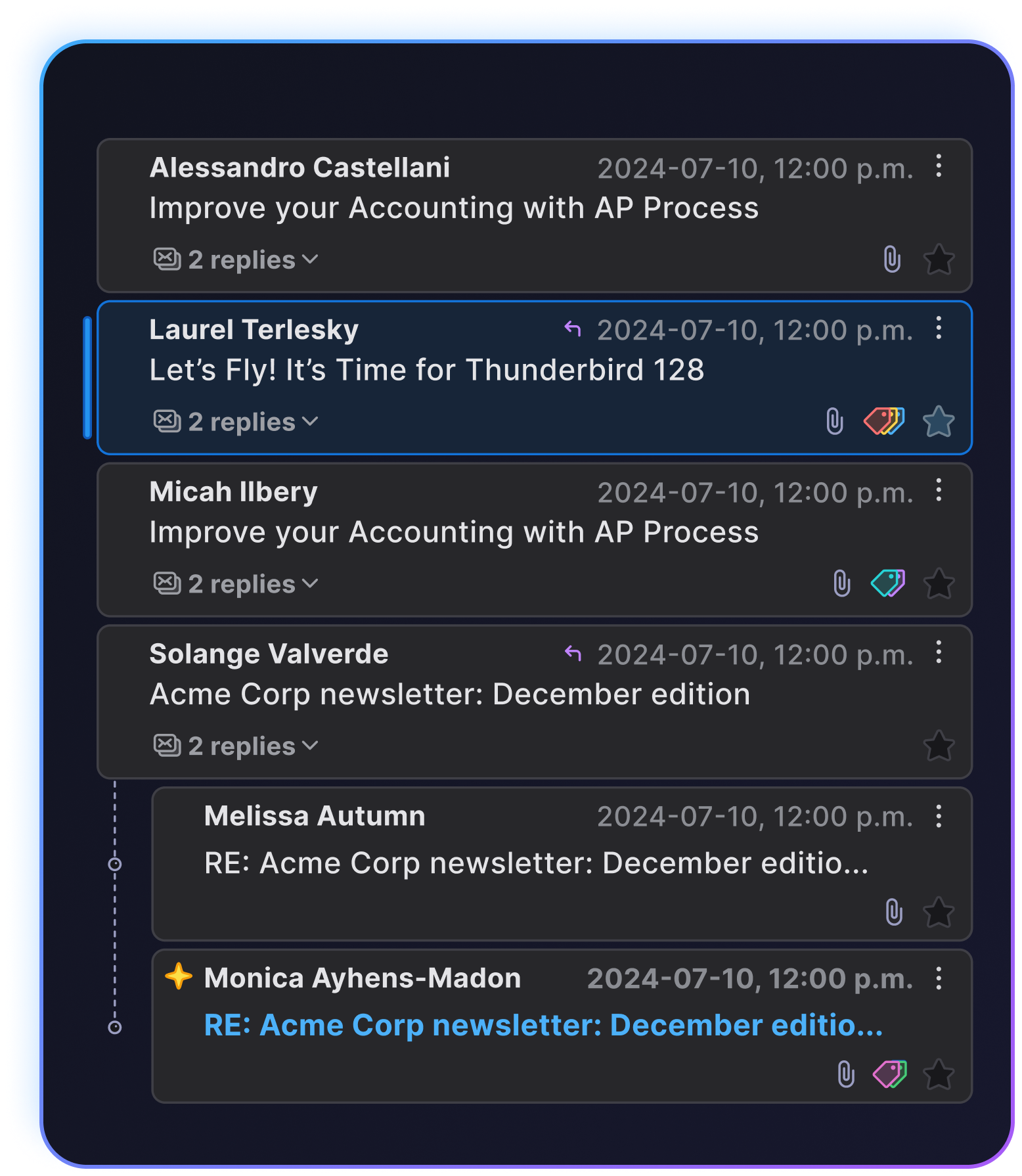
Q: What has been one of the most rewarding projects you’ve worked on at Thunderbird so far?
A: Definitely the Cards View revamp. We redid the first big chunk of code code, but then realized we hadn’t accounted for high contrast and other accessibility needs. We had to address those because accessibility is a must. So, when Micah and I started reworking the design, we thought, “What if we make it ten times better than we originally planned?” Thankfully, Alex was crazy enough to let us do it.
Q: How important is community feedback in your design process?
A: It’s invaluable! The community has a lot of opinions which is great. We design and extrapolate based on our own experiences and those of people we know. We do our best to put ourselves in others’ shoes and predict how they’ll interact with the design. Some comments were straightforward, like “I wish for this or that because it serves me better” or “I just like how it looks.” For UI, as long as it looks cohesive, I’m happy. However, some users provided deeper insights and explained their use personal use cases and concerns. That kind of feedback is so eye-opening, because it addresses things we hadn’t considered. I’m really grateful that they bring those perspectives forward.
Q: OK, big picture question: What’s your overall vision for the user experience in Thunderbird?
A: My whole desire for Thunderbird is it’s something easy to use. It’s something friendly and inviting. However, it can be as complicated or as easy as you want it to be. Intuitive at first glance, but powerful when you need it to be!
The post Meet The Thunderbird Team: Sol Valverde, UI/UX Designer appeared first on The Thunderbird Blog.
]]>The post VIDEO: Learn About Thunderbird Support Articles And How To Contribute appeared first on The Thunderbird Blog.
]]>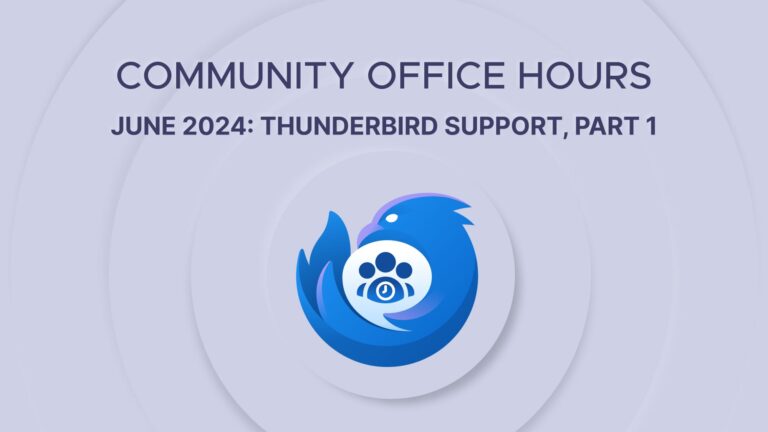
If you’re a regular follower of the Thunderbird blog, you might have wondered “what happened with the June office hours?” And while our teams were all pretty busy preparing for Thunderbird 128, we also have changed the Office Hours format. Instead of recording live, which sometimes made scheduling difficult, we’ll be prerecording most Office Hours and releasing a blog with the video and slides, just like this one!
One week before we record, we’ll put out a call for questions on social media and on the relevant TopicBox mailing lists. And every few months, we’ll have open, live ‘ask us anything’ office hours. We are definitely keeping the community in the Community Office Hours, even with the new format.
June Office Hours: Thunderbird Support (Part 1)
In this first of two Office Hours, the Community Team sat down to talk with User Support Specialist Roland Tanglao. Roland has been a long-time Mozilla Support (SUMO) regular, as well as a member of the Thunderbird community. A large part of Roland’s current work is on the Thunderbird side of SUMO, writing and updating Knowledge Base (KB) articles and responding to user questions in the forums.
Roland takes us through the who, what, and how of writing, updating, and translating Thunderbird KB articles. If you’ve ever wanted to write or translate a KB article, or wanted to suggest updates to ones which are out of date, Roland shows you how and where to get started.
Documentation is great way to become an open source contributor, or to broaden your existing involvement.
Highlights of Roland’s discussion include:
- The structure and markup language of the SUMO Wiki
- How to find KB issues that need help
- Where to meet and chat with other volunteers online
- A demonstration of the KB revision workflow
- Our KB sandbox where you can safely try things out
Watch, Read, and Get Involved
This chat helps demystify how we and the global community create, update, and localize KB articles. We hope it and the included deck inspire you to share your knowledge, eye for detail, or multilingual skills. It’s a great way to get involved with Thunderbird – whether you’re a new or experienced user!
VIDEO (Also on Peertube):
ROLAND’S PRESENTATION:
The post VIDEO: Learn About Thunderbird Support Articles And How To Contribute appeared first on The Thunderbird Blog.
]]>The post Welcome to Thunderbird 128 “Nebula” appeared first on The Thunderbird Blog.
]]>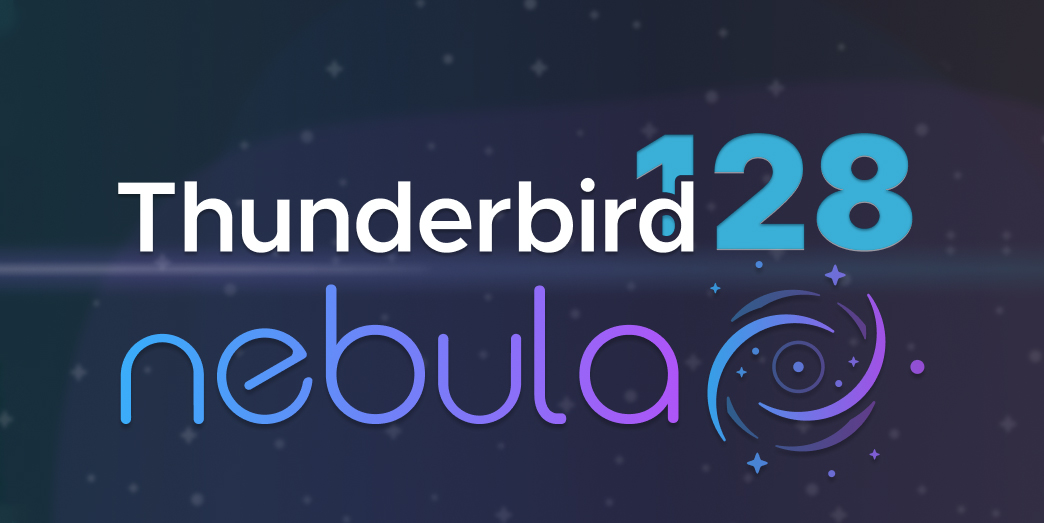
On behalf of the entire team, the Thunderbird Council, and our global community of contributors, I’m excited to announce the initial release of Thunderbird 128 “Nebula.” This annual Extended Support Release (ESR) builds on the solid foundation established by Supernova last year.
Nebula ushers in significant improvements to Thunderbird’s code, stability, overall user experience, and the speed at which we can deliver new features to you.
Here’s a small sample of what you can look forward to in this initial release.
Thunderbird 128: A Rust Revolution
We’ve devoted significant development time integrating Rust — a modern programming language originally created by Mozilla Research — into Thunderbird. Even though this is a seemingly invisible change, it is a major leap forward because it enhances our code quality and performance. This overhaul will allow us to share features between the desktop and future mobile versions of Thunderbird, and speed up our development process. It’s a win for our developers and a win for you.
Redesigned Cards View
The Cards View, which debuted in 115 Supernova, has been tuned and refined for an even better experience. The new layout is more attractive and makes it easier to scan your email threads and glean information at a glance. Plus, the height of email cards adjusts automatically based on your settings, ensuring everything looks just right.
Enhanced Folder Pane
The Folder Pane has received several improvements, including faster rendering and searching of unified folders, better recall of message thread states, and multi-folder selection. We hope these changes make managing your folders faster and more intuitive.
Accent Colors
Thunderbird now offers improved theme compatibility, which is especially beneficial for our Linux users on Ubuntu and Mint. Your Thunderbird should blend seamlessly with your desktop environment, matching the system’s accent colors perfectly.
More Refinements & Updates
Account Color Customization: By popular demand, you can now customize the color of your account icons. These colors also appear in the “From” selection when composing emails, adding a light personal touch to your email experience.
Streamlined Menu Navigation: We’ve simplified menu navigation with better visual cues and reduced cognitive load. These enhancements make using Thunderbird more efficient and enjoyable.
Native Windows Notifications: Thunderbird’s native Windows notifications are now fully functional. Clicking a notification will dismiss it, bring Thunderbird to the foreground, and select the relevant message. Notifications also disappear when Thunderbird is closed, ensuring a seamless experience.
Improved Context Menu: The context menu has been reorganized for a smoother experience, with primary actions now displayed as icons for quick access.
Upcoming Exchange and Mozilla Sync Features
We plan to launch the first phase of built-in support for Exchange, as well as Mozilla Sync, in a future Nebula point release (e.g. Thunderbird 128.X). Although these features are very close to being finished, technical obstacles prevented them from being ready today. Alex will keep you updated in his monthly Thunderbird Monthly Dev Digests.
For advanced users who want to help test our initial implementation of Exchange (currently limited to Mail), it is now available in our Daily and Beta builds. This Wiki page has more information as well as instructions for enabling it. While we definitely welcome your testing and feedback, please keep in mind this feature is currently experimental, and you may run into unexpected behavior or errors.
Looking Forward
In space, a supernova creates the building blocks of creation. In a nebula, those elements nurture new possibilities. Thunderbird 128 Nebula brings together and builds on the best of Supernova! Expect more updates and useful new features in the coming months.
Thank you for being a part of the growing Thunderbird community and sharing this adventure with us. Your feedback and support motivate us to chase constant improvements and deliver the best email experience possible.
Thunderbird 128 Availability For Windows, Linux, and macOS
[Updated July 31] Even with QA and beta testing, any major software release may have issues exposed after significant public testing. That’s why we are slowly enabling automatic updates until we’re confident no such issues exist. As of July 29, we have enabled manual upgrade to 128 via Help > About, and some users will begin receiving automatic updates. Thunderbird version 128.0 is also offered as direct download from thunderbird.net. For users running Thunderbird from the snap or flatpak, 128 is also available.
This post has been automatically translated from English to other languages by DeepL. Please forgive any grammatical or spelling errors.
The post Welcome to Thunderbird 128 “Nebula” appeared first on The Thunderbird Blog.
]]>The post Thunderbird for Android / K-9 Mail: June 2024 Progress Report appeared first on The Thunderbird Blog.
]]>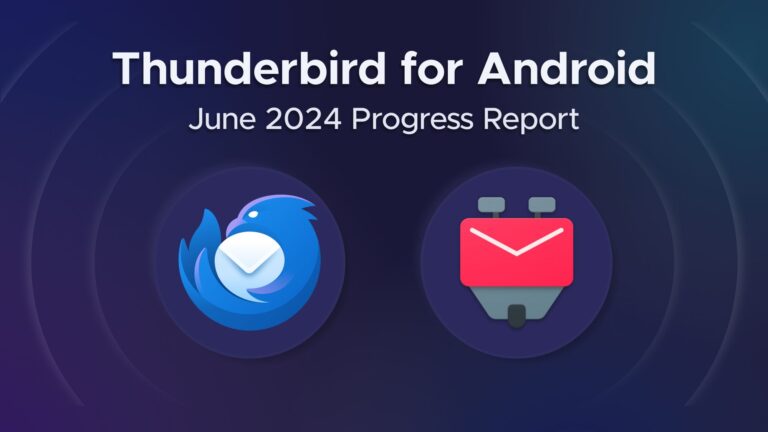
Is it July already? That means it’s time for another report on the progress of creating Thunderbird for Android.
Unfortunately, June has been one of these months without any flashy new features that would make for a nice screenshot to show off in a blog post. To not leave you hanging without any visuals, please enjoy this picture of Thunderbird team member Chris Aquino’s roommate Mister Betsy:

For a recap of the previous month’s activity, see May’s picture-less progress report.
New team member
This year Thunderbird has hired a lot of new people. I’m very happy to report that this also included a manager who will coordinate all of our mobile efforts. Some of you may already know him. Philipp Kewisch has been working on the calendar integrated into Thunderbird for desktop and has been with the project in one capacity or another for a very long time. We’re very excited to have him (back).
Building two apps
In June we continued to work on making the necessary changes to be able to build two apps – K-9 Mail and Thunderbird for Android.
Volunteers working on translating the app have probably already noticed that we changed a lot of user-visible texts that included the app name. In cases where the app name wasn’t strictly necessary, we removed it. In other cases we added a placeholder, so the name of the app can be inserted dynamically.
We also worked on internal changes to make it easier to build multiple apps. However, there’s still quite a bit of work left. So don’t expect a fully working Thunderbird-branded version of the app to be available next week.
Material 3
We’re still in the middle of migrating the user interface to Material 3. So far there hasn’t been any fine-tuning. What you currently see in beta versions of K-9 Mail is likely to change in the future. So we’re not looking for feedback on the design just yet.
Targeting Android 14
In May the changes to target Android 14 were included in a beta release. After a few weeks of testing and not receiving any reports of problems, we included these changes in K-9 Mail 6.804, a maintenance release of the stable branch.
As a reminder, these changes are necessary so the app is not run in a compatibility mode on Android 14. It means the app supports the latest Android restrictions (e.g. when it comes to running in the background) and security features. Google Play enforces this by not allowing apps to publish updates without targeting Android 14 after the August 31 deadline.
More translations
Thanks to the work of volunteer translators we were able to add support for the following languages to beta releases:
- Corsican
- Korean (was previously removed because coverage dropped below 70%)
- Vietnamese
Releases
In June 2024 we published the following stable release:
- K-9 Mail v6.804 (2024-06-07)
… and the following beta versions:
- K-9 Mail v6.902 (2024-06-21)
- K-9 Mail v6.903 (2024-06-24)
- K-9 Mail v6.904 (2024-06-27)
The post Thunderbird for Android / K-9 Mail: June 2024 Progress Report appeared first on The Thunderbird Blog.
]]>The post Thunderbird Monthly Development Digest: June 2024 appeared first on The Thunderbird Blog.
]]>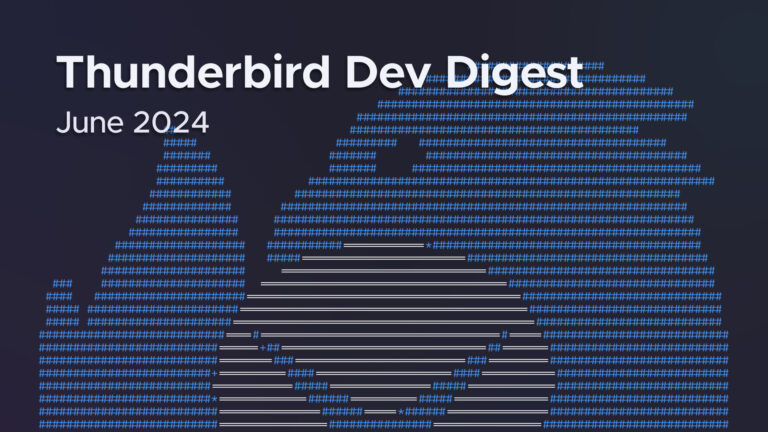
Hello Thunderbird Community!
I can’t believe it’s already the end of June. ESR is only a few days away, and things are moving faster than ever.
Preparing For ESR
This is going to be a slightly shorter update since the majority of our effort revolved around testing and polishing 128 beta, which will turn into ESR on July 10th.
We fixed a total of 127 bugs and a few more things are getting tackled.
Account Colors In Compose
You can now see the custom colors you chose for your accounts in the compose windows. This was an 18 year-old request that we were finally able to fulfill thanks to the incredible work that many core developers put in place during the past 2 years.
By implementing a much more reliable and modular code base, with a clearer separation between data and UI, we’re finally able to ship these long standing requested features much faster. There’s still a lot to do, but working on our code base is getting better and better.
Mozilla Sync
The client code is finished, everything is in place and we’re testing syncing server data against a temporary staging server.
We’re still working on spawning our own production server, which turned out more challenging than expected. This means that potentially we won’t enable Sync by default for the first ESR release and instead keep it hidden temporarily, with the objective of enabling it in a future point release (maybe 128.1 or 128.2) depending on when the production server will be ready.
We will keep you posted every step of the way.
Thunderbird Beta 128
If you haven’t downloaded 128 beta, please do so and help us test and report bugs if you spot them. You can download Thunderbird 128 Beta here, and if you find any issue, please open a bug report against this Meta Bug we’re using to track any potential regression specific to 128. Thank you!
See ya next month.
Alessandro Castellani (he, him)
Director, Desktop and Mobile Apps
If you’re interested in joining the technical discussion around Thunderbird development, consider joining one or several of our mailing list groups here.
The post Thunderbird Monthly Development Digest: June 2024 appeared first on The Thunderbird Blog.
]]>The post Maximize Your Day: Treat Your Email Like Laundry appeared first on The Thunderbird Blog.
]]>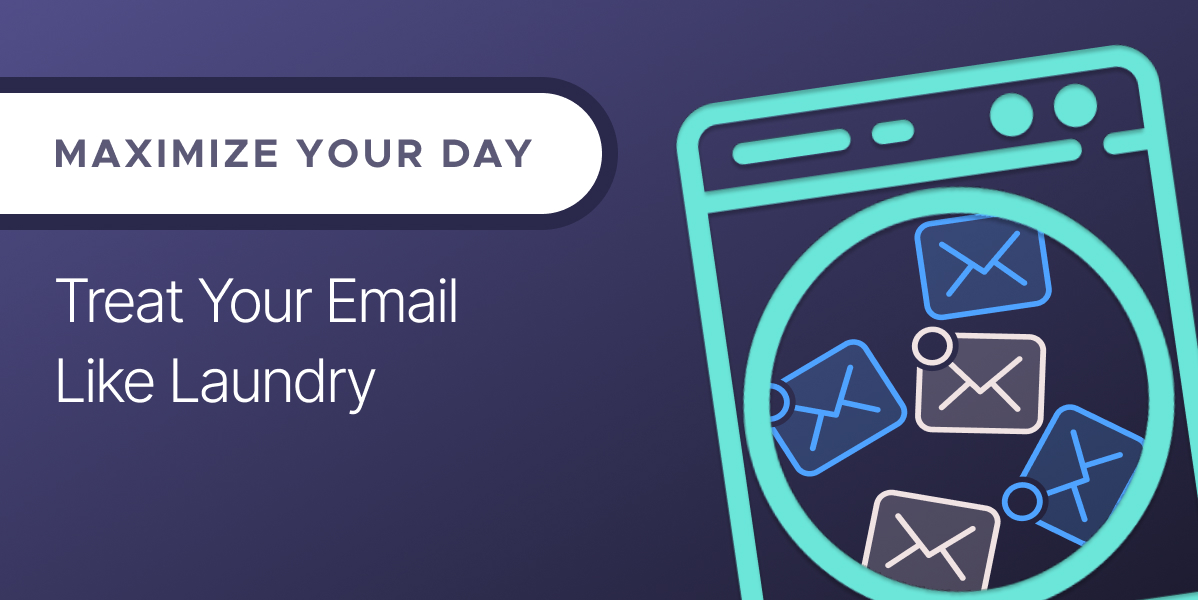
Imagine for a moment if we treated our laundry the same way we treat our email. It might look something like this: At least ten times an hour, we’d look in the dryer, sigh at the mix of wet and dry clothes, wonder where the shirt we needed was, and then close the dryer door again without emptying a thing. Laura Mae Martin, author of Uptime: A Practical Guide to Personal Productivity and Wellbeing, has a better approach. Treat your email like you would ideally treat your laundry.
How do we put this metaphor to work in our inboxes? Martin has some steps for getting the most out of this analogy, and the first is to set aside a specific time in your day to tackle your inbox. This is the email equivalent of emptying your dryer, not just looking in it, and sorting the clothes into baskets. You’re already setting future you up for a better day with this first step!
The Process
At this set time, you’ll have a first pass at everything in your inbox, or as much as you can, sorting your messages into one of four ‘baskets’ – Respond, To Read, Revisit, and Relax (aka, the archive where the email lives once you’ve acted on it from a basket, and the trash for deleted emails). Acting on those messages comes after the sorting is done. So instead of ‘touching’ your email a dozen times with your attention, you only touch it twice: sorting it, and acting on it.
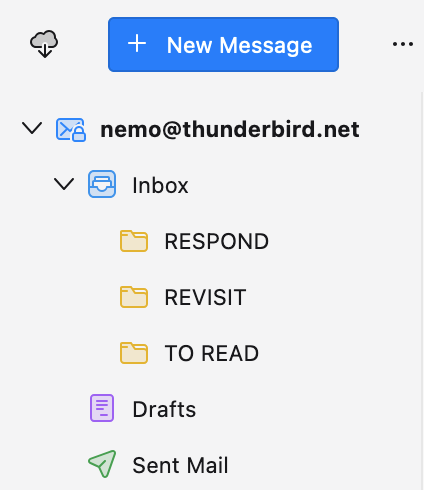
Let’s discuss those first three baskets in a little more detail.
First, the ‘Respond’ basket is for emails that require a response from you, which need you and your time to complete. Next, the ‘To Read’ basket is for emails that you’d like to read for informative purposes, but don’t require a response. Finally, the ‘Revisit’ basket is for emails where you need to respond but can’t right now because you’re waiting for the appropriate time, a response from someone, etc.
Here’s more info on how treating your email like laundry looks in your inbox. You don’t have separate dryers for work clothes and personal clothes, so ideally you want your multiple inboxes in one place, like Thunderbird’s Unified Folders view. The baskets (Respond, To Read, Revisit) are labels, tags, or folders. Unread messages should not be in the same place with sorted email; that’s like putting in wet clothes with your nice, dry laundry!
Baskets and Batch Tasking
You might be wondering “why not just use this time to sort AND respond to messages?” The answer is that this kind of multitasking saps your focus, thanks to something called attention residue. Hopping between sorting and replying – and increasing the chance of falling down attention rabbit holes doing the latter – makes attention residue thicker, stickier, and ultimately harder to shake. Batch tasking, or putting related tasks together for longer stretches of time, keeps potentially distracting tasks like email in check. So, sorting is one batch, responding is another, etc. No matter how much you’re tempted, don’t mix the tasks!
Putting It Into Practice
You know why you should treat your email like laundry, and you know the process. Here’s some steps for day one and beyond to make this efficient approach a habit.
One-time Setup:
- Put active emails in your inbox in one of the first three baskets (Respond, To Read, Revisit)
- If email doesn’t need one of these baskets, archive or delete them
Daily Tasks
- Remember the 4 Baskets are tasks to be done separately
- Pick a time to sort your email each day – at least once, and hopefully no more than two or three more times. Remember, this is time ONLY to sort emails into your baskets.
- Give future you the gift of a sorted inbox
- Find and schedule time during the day to deal with the baskets – but only one basket at a time! Have slots just for responding, reading, or checking on the progress of your Revisit emails. Think of your energy flow during the day, and assign your most mentally strenuous boxes for your peak energy times.
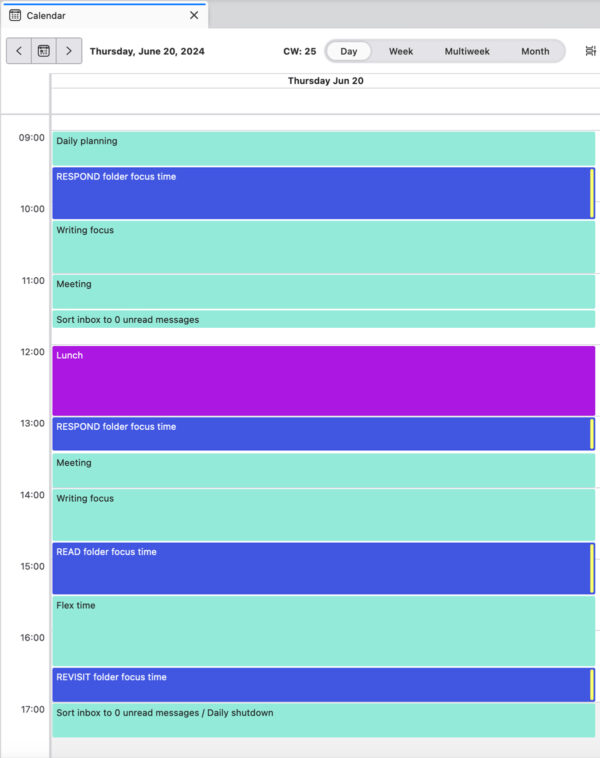
One Last Fold
Thanks for joining us in our continuing journey to turn our inboxes, calendars, and tasks lists into inspiring productivity tools instead of burdens. We know opening our inboxes can sometimes feel overwhelming, which makes it easier for them to steal our focus and our time. But if you treat your email like laundry, this chore can help make your inbox manageable and put you in control of it, instead of the other way around.
We’re excited to try this method, and we hope you are too. We’re also eager to try this advice with our actual laundry. Watch out, inboxes and floor wardrobes. We’re coming for you!
Until next time, stay productive!
Want more email productivity tips? Read this:
The post Maximize Your Day: Treat Your Email Like Laundry appeared first on The Thunderbird Blog.
]]>The post Thunderbird: The Build and Release Process Explained appeared first on The Thunderbird Blog.
]]>
Our Community Office Hours session for May 2024 has concluded, and it was quite informative (especially for non-developers like me)! Wayne and Daniel shed light on Thunderbird’s build and release process, ran through a detailed presentation, answered questions, and treated us to live demos showing how a new Thunderbird build gets pushed and promoted to release.
Below you’ll find a lightly edited recording of the session, and the presentation slides in PDF format.
We’ll be announcing the topic of our June Office Hours session soon, so keep an eye on the Thunderbird blog.
Links and Further Reading
- Download Channels: ESR, Beta, Daily, default release
- Thunderbird’s release and events calendar (closely follows the Firefox release schedule)
- Thunderbird Release Notes
- Thunderbird CI Docs
- Treeherder
- Thunderbird statistics
- Thunderbird crash statistics
ORIGINAL ANNOUNCEMENT
Have you ever wondered what the release process of Thunderbird is like? Wanted to know if a particular bug would be fixed in the next release? Or how long release support lasts? Or just how many point releases are there?
In the May Office Hours, we’ll demystify the current Thunderbird release process as we get closer to the next Extended Security Release on July 10, 2024.
May Office Hours: The Thunderbird Release Process
One of our guests you may know already: Wayne Mery, our release and community manager. Daniel Darnell, a key release engineer, will also join us. They’ll answer questions about what roles they play, how we stage releases, and when they know if releases are ready. Additionally, they’ll tell us about the future of Thunderbird releases, including working with add-on developers and exploring a monthly release cadence.
Join us as our guests answer these questions and more in the next edition of our Community Office Hours! You can also submit your own questions about this topic beforehand and we’ll be sure to answer them: officehours@thunderbird.net
Catch Up On Last Month’s Thunderbird Community Office Hours
While you’re thinking of questions to ask, watch last month’s office hours where we chatted with three key developers bringing Rust and native Microsoft Exchange support into Thunderbird. You can find the video on our TILvids page.
Join The Video Chat
We’ll be back in our Big Blue Button room, provided by KDE and the Linux Application Summit. We’re grateful for their support and to have an open source web conferencing solution for our community office hours.
Date and Time: Friday, May 31 at 17:30 UTC
Direct URL to Join: https://meet.thunderbird.net/b/hea-uex-usn-rb1
Access Code: 964573
The post Thunderbird: The Build and Release Process Explained appeared first on The Thunderbird Blog.
]]>The post Our First Thunderbird Contributor Highlight! appeared first on The Thunderbird Blog.
]]>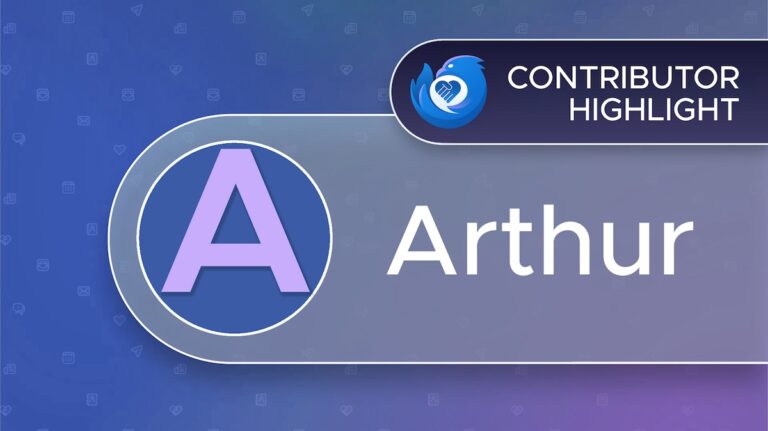
Thunderbird wouldn’t be here today without its incredible and dedicated contributors. The people developing Thunderbird and all of its add-ons, testing new releases, and supporting fellow users, for example, are the wind beneath our wings. It’s time to give them the spotlight in our new Contributor Highlight series.
We kick things off with Arthur, who contributes to Thunderbird by triaging and filing bug reports at Bugzilla, as well as assisting others.
Arthur, Chicago USA
Why do you like using Thunderbird?
Thunderbird helps me organize my life and I could not function in this world without its Calendar feature. It syncs well with things I do on my Android device and I can even run a portable version of it on my USB drive when I don’t have physical access to my home or office PC. Try doing that with that “other” email client.
What do you do in the Thunderbird community and why do you enjoy it? What motivates you to contribute?
Being a user myself, I can help other users because I know where they’re coming from. Also, having a forum like Bugzilla allows regular users to bring bugs to the attention of the Devs and for me to interface with those users to see if I can reproduce bugs or help them resolve issues. Having a direct line to Mozilla is an amazing resource. If you don’t have skin in the game, you can’t complain about the direction in which a product goes.
How do you relate your professional background and volunteerism to your involvement in Thunderbird?
As an IT veteran of 33+ years, I am very comfortable in user facing support and working with app vendors to resolve app problems but volunteering takes on many forms and is good for personal growth. Some choose to volunteer at their local Food Panty or Homeless shelter. I’ve found my comfort zone in leveraging my decades of IT experience to make something I know millions of users use and help make it better.
Share Your Contributor Highlight (or Get Involved!)
A big thanks to Arthur and all our Thunderbird contributors who have kept us alive and are helping us thrive! We’ll be back soon with more contributor highlights to spotlight more of our community.
If you’re a contributor who would like to share your story, get in touch with us at community@thunderbird.net. If you’re reading this and want to know more about getting involved with Thunderbird, check out our new and improved guide to learn about all the ways to contribute your skills to Thunderbird.
The post Our First Thunderbird Contributor Highlight! appeared first on The Thunderbird Blog.
]]>The post Thunderbird for Android / K-9 Mail: May 2024 Progress Report appeared first on The Thunderbird Blog.
]]>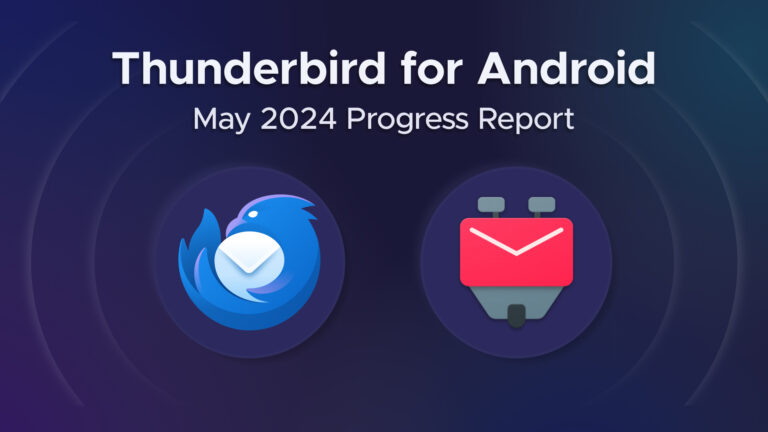
Welcome reader! This is the place where we, the Thunderbird for Android team, inform you about what we worked on in May 2024.
We’ve been publishing monthly progress reports for quite a while now. If you haven’t subscribed to the RSS feed yet, now would be a good time to start. You can even use your favorite desktop app to do so – see Thunderbird + RSS: How To Bring Your Favorite Content To The Inbox.
And if you need a reminder on where we left off last month, head over to April’s progress report.
Material 3
The most noticeable development effort going on right now is the conversion of the user interface to the design system Material 3. You can follow our progress by becoming a beta tester and installing the K-9 Mail 6.9xx beta versions.
The first step consisted of changing the theme to Material 3. That changes things like the style of buttons and dialogs.
Next, we replaced the many icons used throughout the app. But when using the beta version we — and some of you — noticed that not all of the new icons are a good fit. So we’ll update those icons in the next design iteration.
One of the main reasons for switching to Material 3 is the ability to support dynamic colors. It will allow the app to (optionally) use the system color scheme e.g. derived from the wallpaper. But in order for this to work properly, we need to update many places in the app that currently use fixed theme colors. This is an ongoing effort.
Targeting Android 14
As mentioned in April’s progress report, we’ve included the changes necessary to target Android 14 in the latest beta versions. So far we haven’t seen any crashes or bug reports related to these changes. So we plan to include them in the next maintenance release – K-9 Mail 6.804.
F-Droid metadata (part 3)
Unfortunately, this topic was part of the last two progress reports. So we’re very happy to report that the app description is now finally available again on our F-Droid app listing.
Other things we’ve worked on
Developer documentation
We’ve done some work on making our developer documentation more accessible. There’s now a table of contents and we have the capability to render it to HTML using mdbook. However, we haven’t set up automatic publishing yet. Until that happens, the documentation can be browsed on GitHub: K-9 Mail developer documentation.
Small IMAP improvements
We took some time to have a closer look at the communication between the app and the server when using the IMAP protocol and noticed a few places where the app could be more efficient. We’ve started addressing some of these inefficiencies. The result is that K-9 Mail can now perform some action with fewer network packets going back and forth between the app and the server.
Support for predictive back
Google is working on improving the user experience of the back gesture in Android. This effort is called predictive back. The idea is to reveal (part of) the screen to which a successful back gesture will navigate while the swipe gesture is still in progress.
In order for this to work properly, apps that currently intercept the back button/gesture will have to make some changes. We’ve started making the necessary modifications. But it’s still a work in progress.
Community Contributions
GitHub user Silas217209 added support for mailto: URIs on NFC tags (#7804). This was a feature a user requested in April.
Thank you for the contribution! 
Releases
In May 2024 we published the following stable release:
- K-9 Mail v6.803 (2024-05-10)
… and the following beta versions:
- K-9 Mail v6.900 (beta) (2024-05-15)
- K-9 Mail v6.901 (beta) (2024-05-15)
Thanks for reading, testing, and participating. We’ll see you next month!
The post Thunderbird for Android / K-9 Mail: May 2024 Progress Report appeared first on The Thunderbird Blog.
]]>The post Thunderbird Monthly Development Digest: May 2024 appeared first on The Thunderbird Blog.
]]>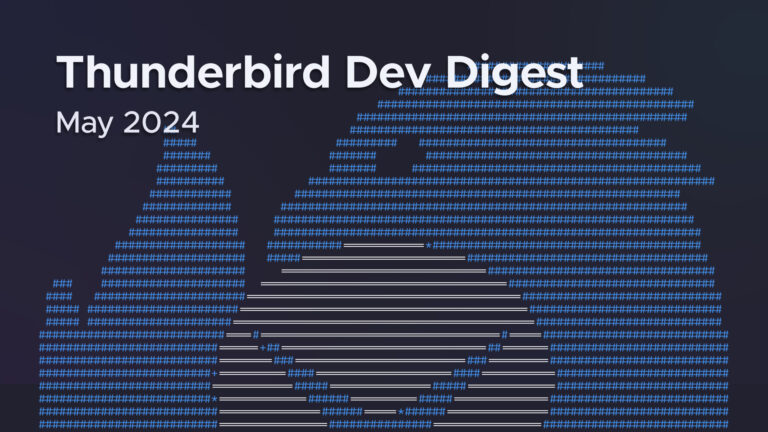
Hello Thunderbird Community!
We’re tossing May behind our shoulders, which means we’re in the final sprint before the next ESR (Extended Support Release). During the next couple of weeks you can expect some official communication on all the things that are going in the next major release of Thunderbird. Until then, here are some appetizers on our most recent efforts.
Rust-enabled builds
Our build and release team is working hard to ship Rust enabled builds by default. The first beta version of 128 will ship with Rust enabled by default, which will allow all of you to test experimental features without needing to compile the code locally.
Microsoft Exchange support
We’re very very very close!
So far we have the main flow completed, and we’re able to set up an account, fetch folders, fetch messages, and display messages. We’re finalizing the outgoing flow in order to send messages, and after that we will start an audit to ensure that all the usual features you expect from interacting with your email are working.
Expect some future call to actions to test things and invites to switch the experimental pref ON.
Native Linux system tray support
Enabling Rust builds in Thunderbird also gives us the ability to implement some long awaited features much faster. We’re still testing and cleaning things up, but if you’re adventurous you can check out our GitHub repositories for Linux System Tray and DBus hooks and run them locally.
Folder multi-selection
Folder pane multi-selection is almost completed and it should land soon. There are still some rough edges we need to tackle, mostly due to some C++ code not liking multiple folders copy/move and undo actions, but we’re confident that we will have this done before the end of June.
You can check the code and follow the progress here.
Account color customization
Another requested feature we’re aiming to ship in 128 is the customization of account colors. This is the first patch of an upcoming stack that will add some nice visual cues in the message list and the compose window for users with multiple accounts.
Folder compaction
We shared this in our Daily mailing list, but in case you missed it, we rebuilt the Folder Compaction code from scratch. This should potentially solve all the issues of profiles bubbling up in size, or compact operations silently failing and piling up on each other.
These changes should be uplifted to Beta soon. Please test it as much as possible and report any bugs as soon as you encounter them.
Native Windows notifications
Another important achievement was the ability to completely support native Windows 10/11 notifications and make them fully functional.
You can already consume this feature on Daily, and moving forward Thunderbird will be using native OS notifications by default.
We plan to add some nice quick actions and improve the usefulness of native notifications in the future, so stay tuned!
As usual, if you want to see things as they land you can always check the pushlog and try running daily, which would be immensely helpful for catching bugs early.
See ya next month.
Alessandro Castellani (he, him)
Director, Desktop and Mobile Apps
If you’re interested in joining the technical discussion around Thunderbird development, consider joining one or several of our mailing list groups here.
The post Thunderbird Monthly Development Digest: May 2024 appeared first on The Thunderbird Blog.
]]>The post Maximize Your Day: Time Blocking with Thunderbird appeared first on The Thunderbird Blog.
]]>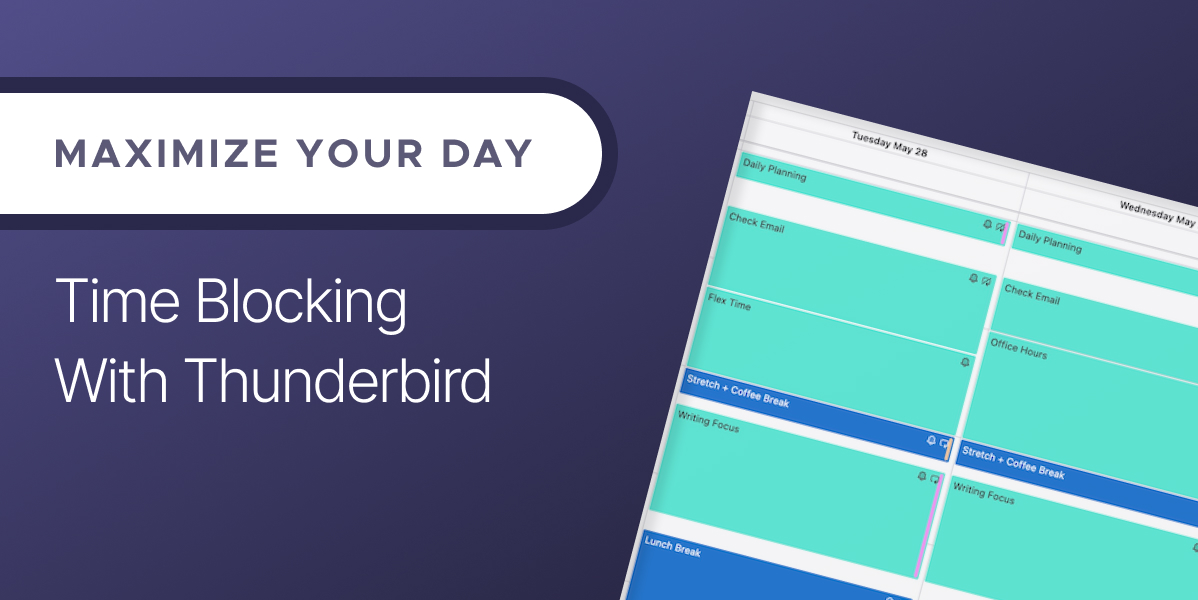
This might be unexpected coming from an email app developer, but hear us out: we want you to spend the least amount of time possible in your inbox.
The Thunderbird Team wants to help you manage your most precious, nonrenewable resource: your time. This post kicks off a series of Thunderbird tips and tricks focusing on our favorite time management and productivity advice.
When we asked Director of Product, Ryan Sipes, what time management strategy he wanted to share first, he said time blocking. Time blocking is a favorite of author and productivity guru Cal Newport. This technique schedules your entire day to minimize focus-stealing activities and maximize deep work that requires your full attention.
This sounds daunting, but we’re on this productivity journey with you! All you need to start is your calendar or planner, whether it’s in Thunderbird, another app, or using pen and paper. Personally, we’re fans of having our notebook and laptop on hand when we schedule our day ahead.
Don’t worry that an all-day schedule won’t leave time for fun or impromptu plans. You’ll be more present when you’re off work, whether it’s cherished time with loved ones or working on that novel you always wanted to write. And since you’re adjusting your schedule as you go, you’ll be able to add plans without overwhelming yourself.
With that, let’s get started time blocking with Thunderbird!
Get Your Calendars in One Place
First, have all your calendars (work, personal, school, etc.) in one place. Thunderbird can combine online calendars from different accounts for you (and let you customize their colors)! This SUMO article explains — with screenshots — how to add your calendars and create new ones.
Suggestions for Getting Started

It’s hard to change some fixed blocks of time, like team meetings or scheduled personal obligations. But the spaces in between are a blank canvas waiting to be filled with everything you need and want to do. How you fill them is up to you, but here are some suggestions for time blocking with Thunderbird:
- Know when you do your best work. If you can focus more in the morning, or after a 30-minute walk, schedule blocks of deep work around that. If you don’t know when you do your best work, observe how you work for a week or two! Take notes on your energy and focus levels during the day.
- Use your professional and personal priorities to fill out your time blocks. Whether your planning exists in project management software or handwritten notes, identify your urgent and important tasks that need your focus and time.
- Use breaks between longer blocks for less urgent and potentially distracting tasks like checking your email or catching up on chats. If you limit the amount of time you spend on these tasks (a technique known as time boxing), and minimize or turn off their notifications, your day becomes a lot more productive.
- Adjust your schedule whenever you need it, not just at the end of the day or week. Move blocks, shorten or lengthen them, etc. As you learn to be more aware of how you use your time, you’ll become better at estimating how long you need for tasks, and the best time of day to do them.
Time Blocking and Beyond
Thanks for joining us for this first productivity newsletter. We hope this post and the ones to come help you reclaim the time for things you need and want to do. Next month we’ll share more advice, and techniques you can use in Thunderbird to maximize your valuable time.
We’re on this journey with you, learning new skills and working them into our lives until they become habits. Making changes, even for the better, is hard. If a day or two or seven go by and you’re losing track of your time again, it’s okay. Make this the cue to start your productivity training montage, and let us be the awesome 80s rock soundtrack to support you.
Until next time, stay productive!
The post Maximize Your Day: Time Blocking with Thunderbird appeared first on The Thunderbird Blog.
]]>The post The New Thunderbird Website Has Hatched appeared first on The Thunderbird Blog.
]]>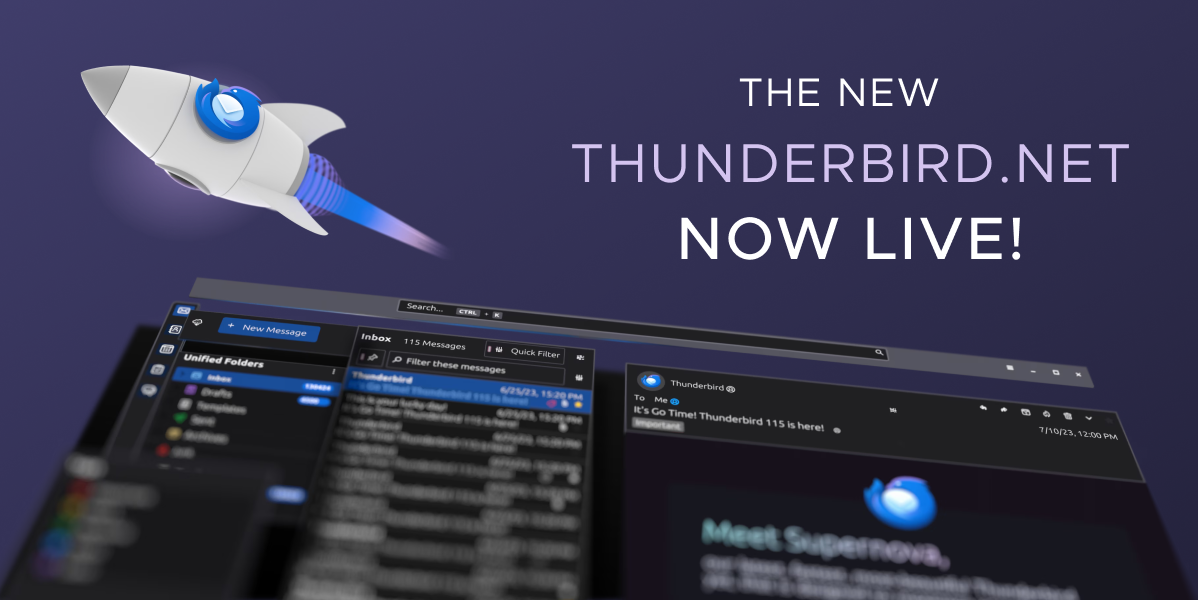
Thunderbird.net has a new look, but the improvements go beyond that. We wanted a website where you could quickly find the information you need, from support to contribution, in clear and easy to understand text. While staying grateful to the many amazing contributors who have helped build and maintain our website over the past 20 years, we wanted to refresh our information along with our look. Finally, we wanted to partner with Freehive’s Ryan Gorley for their sleek, cohesive design vision and commitment to open source.
We wanted a website that’s ready for the next 20 years of Thunderbird, including the upcoming arrival of Thunderbird on mobile devices. But you don’t have to wait for that future to experience the new website now.
The New Thunderbird.net
The new, more organized framework starts with the refreshed Home page. All the great content you’ve relied on is still here, just easier to find! The expanded navigation menu makes it almost effortless to find the information and resources you need.
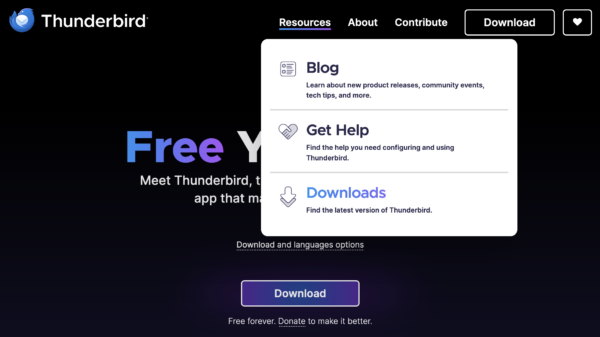
Resources provide a quick link to all the news and updates in the Thunderbird Blog and the unmatched community assistance in Mozilla Support, aka SUMO. Release notes are linked from the download and other options page. That page has also been simplified while still maintaining all the usual options. It’s now the main way to get links to download Beta and Daily, and in the future any other apps or versions we produce.
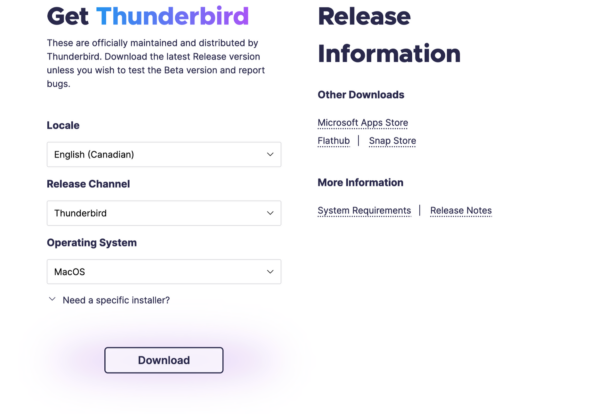
The About section introduces the values and the people behind the Thunderbird project, which includes our growing MZLA team. Our contact page connects you with the right community resources or team member, no matter your question or concern. And if you’d like to join us, or just see what positions are open, you’ll find a link to our career page here.

Whether it’s giving your time and skill or making a financial donation, it’s easy to discover all the ways to contribute to the project. Our new and improved Participate page shows how to get involved, from coding and testing to everyday advocacy. No matter your talents and experience, everyone can contribute!
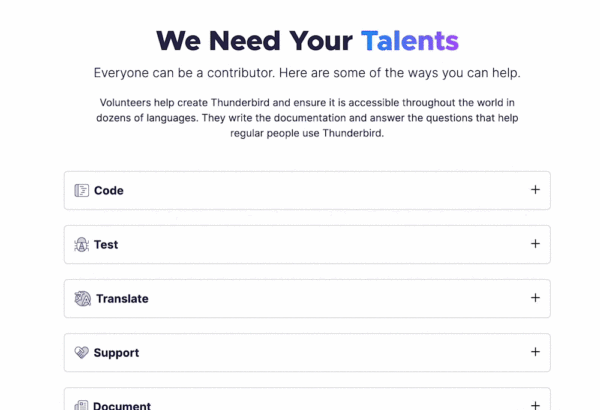
If you want to download the latest stable release, or to donate and help bring Thunderbird everywhere, those options are still an easy click from the navigation menu.
Your Feedback
We’d love to have your thoughts and feedback on the new website. Is there a new and improved section you love? Is there something we missed? Let us know in the comments below. Want to see all the changes we made? Check the repository for the detailed commit log.
The post The New Thunderbird Website Has Hatched appeared first on The Thunderbird Blog.
]]>The post Thunderbird for Android / K-9 Mail: April 2024 Progress Report appeared first on The Thunderbird Blog.
]]>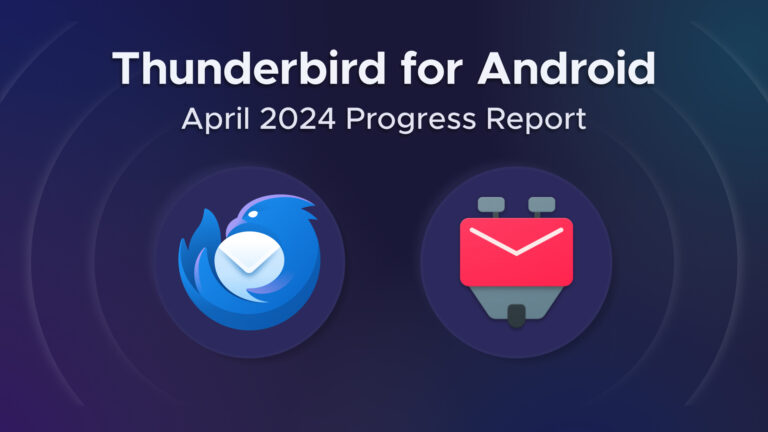
Welcome to our monthly report on turning K-9 Mail into Thunderbird for Android! Last month you could read about how we found and fixed bugs after publishing a new stable release. This month we start with… telling you that we fixed even more bugs.
Fixing bugs
After the release of K-9 Mail 6.800 we dedicated some time to fixing bugs. We published the first bugfix release in March and continued that work in April.
K-9 Mail 6.802
The second bugfix release contained these changes:
- Push: Notify user if permission to schedule exact alarms is missing
- Renamed “Send client ID” setting to “Send client information”
- IMAP: Added support for the \NonExistent LIST response attribute
- IMAP: Issue EXPUNGE command after moving without MOVE extension
- Updated translations; added Hebrew translation
I’m especially happy that we were able to add back the Hebrew translation. We removed it prior to the K-9 Mail 6.800 release due to the translation being less than 70% complete (it was at 49%). Since then volunteers translated the missing bits of the app and in April the translation was almost complete.
Unfortunately, the same isn’t true for the Korean translation that was also removed. It was 69% complete, right below the threshold. Since then there has been no significant change. If you are a K-9 Mail user and a native Korean speaker, please consider helping out.
F-Droid metadata (again?)
In the previous progress report we described what change had led to the app description disappearing on F-Droid and how we intended to fix it. Unfortunately we found out that our approach to fixing the issue didn’t work due to the way F-Droid builds their app index. So we changed our approach once again and hope that the app description will be restored with the next app release.
Push & the permission to schedule alarms
K-9 Mail 6.802 notifies the user when Push is enabled in settings, but the permission to schedule exact alarms is missing. However, what we really want to do is ask the user for this permission before we allow them to enable Push.
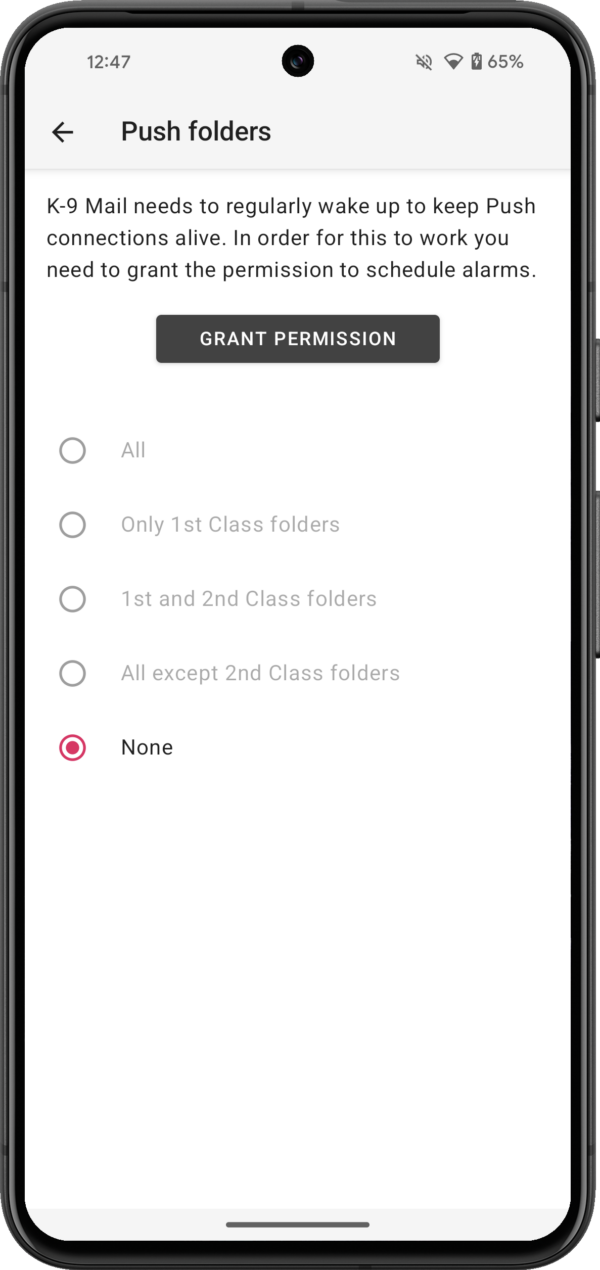
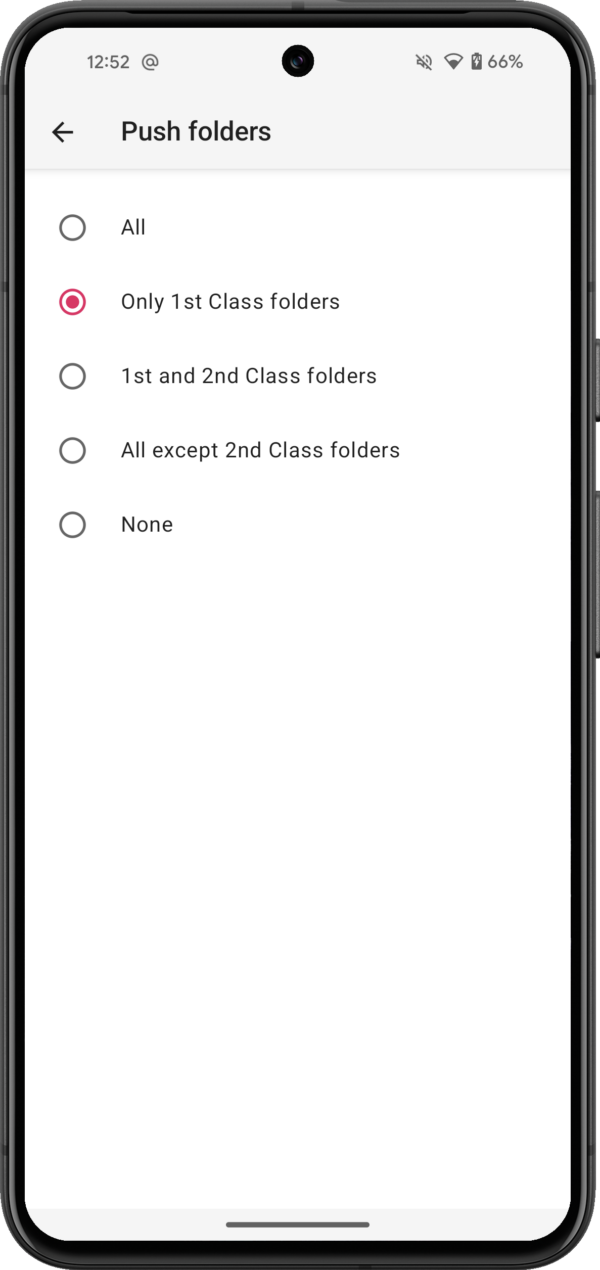
This change was completed in April and will be included in the next bugfix release, K-9 Mail 6.803.
Material 3
As briefly mentioned in March’s progress report, we’ve started work on switching the app to Google’s latest version of Material Design – Material 3. In April we completed the technical conversion. The app is now using Material 3 components instead of the Material Design 2 ones.
The next step is to clean up the different screens in the app. This means adjusting spacings, text sizes, colors, and sometimes more extensive changes.
We didn’t release any beta versions while the development version was still a mix of Material Design 2 and Material 3. Now that the first step is complete, we’ll resume publishing beta versions.
If you are a beta tester, please be aware that the app still looks quite rough in a couple of places. While the app should be fully functional, you might want to leave the beta program for a while if the look of the app is important to you.
Targeting Android 14
Part of the necessary app maintenance is to update the app to target the latest Android version. This is required for the app to use the latest security features and to cope with added restrictions the system puts in place. It’s also required by Google in order to be able to publish updates on Google Play.
The work to target Android 14 is now mostly complete. This involved some behind the scenes changes that users hopefully won’t notice at all. We’ll be testing these changes in a future beta version before including them in a K-9 Mail 6.8xx release.
Building two apps
If you’re reading this, it’s probably because you’re excited for Thunderbird for Android to be finally released. However, we’ve also heard numerous times that people love K-9 Mail and wished the app would stay around. That’s why we’ve announced in December to do just that.
We’ve started work on this and are now able to build two apps from the same source code. Thunderbird for Android already includes the fancy new Thunderbird logo and a first version of a blue theme.

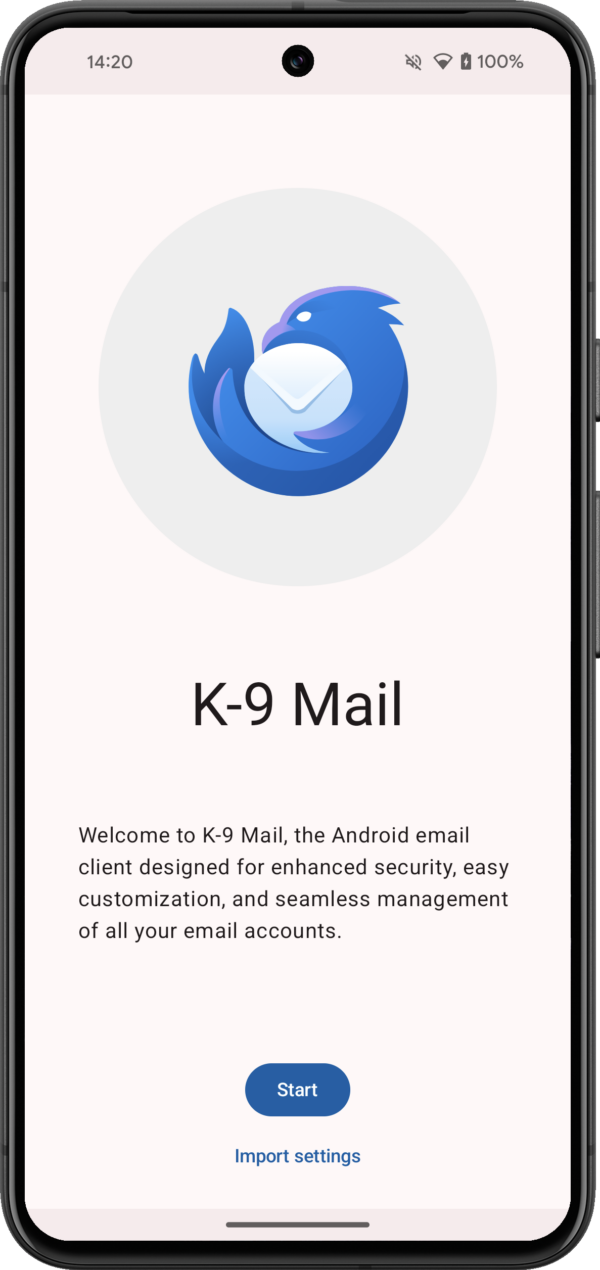
But as you can see in the screenshots above, we’re not quite done yet. We still have to change parts of the app where the app name is displayed to use a placeholder instead of a hard-coded string. Then there’s the About screen and a couple of other places that require app-specific behavior.
We’ll keep you posted.
Releases
In April 2024 we published the following stable release:
- K-9 Mail v6.802 (2024-04-05)
The post Thunderbird for Android / K-9 Mail: April 2024 Progress Report appeared first on The Thunderbird Blog.
]]>The post Thunderbird Monthly Development Digest: April 2024 appeared first on The Thunderbird Blog.
]]>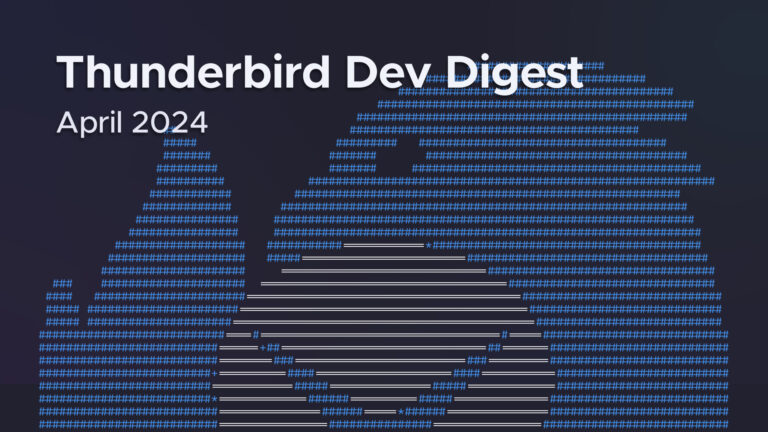
Hello Thunderbird Community, and welcome back to the monthly Thunderbird development digest. April just ended and we’re running at full speed into May. We’re only a couple of months away from the next ESR, so things are landing faster and we’re seeing the finalization of a lot of parallel efforts.
20-Year-Old bugs
Something that has been requested for almost 20 years finally landed on Daily. The ability to control the display of recipients in the message list and better distinguish unknown addresses from those saved in the Address Book was finally implemented in Bug 243258 – Show email address in message list.
This is one of the many examples of features that in the past were very complicated and tricky to implement, but that we were finally able to address thanks to the improvements of our architecture and being able to work with a more flexible and modular code.
We’re aiming at going through those very very old requests and slowly addressing them when possible.
Exchange alpha
More Exchange support improvements and features are landing on Daily almost…daily (pun intended). If you want to test things with a local build, you can follow this overview from Ikey.
We will soon look at the possibility of enabling Rust builds by default, making sure that all users will be able to consume our Rust code from next beta, and only needing to switch a pref in order to test Exchange.
Folder compaction
If you’ve been tracking our most recent struggles, you’re probably aware of one of the lingering annoying issues which sees the bubbling up of the size of the user profile caused by local folder corruption.
Ben dive bombed into the code and found a spaghetti mess that was hard to untangle. You can read more about his exploration and discoveries in his recent post on TB-Planning.
We’re aiming to land this code hopefully before the end of the week and start calling for some testing and feedback from the community to ensure that all the various issues have been addressed correctly.
You can follow the progress in Bug 1890448 – Rewrite folder compaction.
Cards View
If you’re running Beta or Daily, you might have noticed some very fancy new UI for the Cards View. This has been a culmination of many weeks of UX analysis to ensure a flexible and consistent hover, selection, and focus state.
Micah and Sol identified a total of 27 different interaction states on that list, and implementing visual consistency while guaranteeing optimal accessibility levels for all operating systems and potential custom themes was not easy.
We’re very curious to hear your feedback.
Context menu
A more refined and updated context menu for the message list also landed on Daily.
A very detailed UX exploration and overview of the implementation was shared on the UX Mailing list a while ago.
This update is only the first step of many more to come, so we apologize in advance if some things are not super polished or things seem temporarily off.
ESR Preview
If you’re curious about what the next ESR will look like or checking new features, please consider downloading and installing Beta (preferably in another directory to not override your current profile.) Help us test this new upcoming release and find bugs early.
As usual, if you want to see things as they land you can always check the pushlog and try running daily, which would be immensely helpful for catching bugs early.
See ya next month.
Alessandro Castellani (he, him)
Director, Desktop and Mobile Apps
If you’re interested in joining the technical discussion around Thunderbird development, consider joining one or several of our mailing list groups here.
The post Thunderbird Monthly Development Digest: April 2024 appeared first on The Thunderbird Blog.
]]>The post Adventures In Rust: Bringing Exchange Support To Thunderbird appeared first on The Thunderbird Blog.
]]>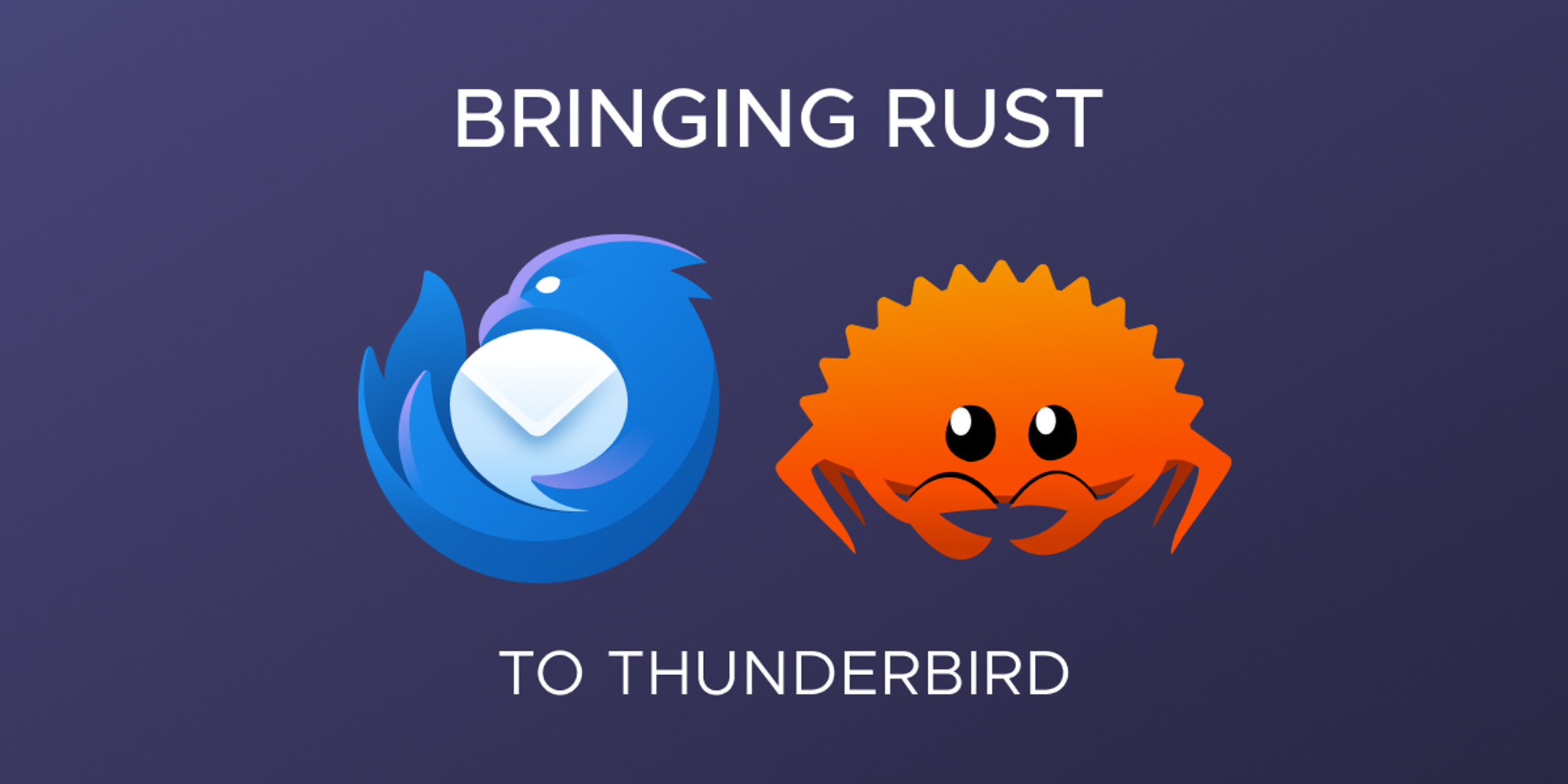
Microsoft Exchange is a popular choice of email service for corporations and educational institutions, and so it’s no surprise that there’s demand among Thunderbird users to support Exchange. Until recently, this functionality was only available through an add-on. But, in the next ESR (Extended Support) release of Thunderbird in July 2024, we expect to provide this support natively within Thunderbird. Because of the size of this undertaking, the first roll-out of the Exchange support will initially cover only email, with calendar and address book support coming at a later date.
This article will go into technical detail on how we are implementing support for the Microsoft Exchange Web Services mail protocol, and some idea of where we’re going next with the knowledge gained from this adventure.
Historical context
Thunderbird is a long-lived project, which means there’s lots of old code. The current architecture for supporting mail protocols predates Thunderbird itself, having been developed more than 20 years ago as part of Netscape Communicator. There was also no paid maintainership from about 2012 — when Mozilla divested and transferred ownership of Thunderbird to its community — until 2017, when Thunderbird rejoined the Mozilla Foundation. That means years of ad hoc changes without a larger architectural vision and a lot of decaying C++ code that was not using modern standards.
Furthermore, in the entire 20 year lifetime of the Thunderbird project, no one has added support for a new mail protocol before. As such, no one has updated the architecture as mail protocols change and adapt to modern usage patterns, and a great deal of institutional knowledge has been lost. Implementing this much-needed feature is the first organization-led effort to actually understand and address limitations of Thunderbird’s architecture in an incremental fashion.
Why we chose Rust
Thunderbird is a large project maintained by a small team, so choosing a language for new work cannot be taken lightly. We need powerful tools to develop complex features relatively quickly, but we absolutely must balance this with long-term maintainability. Selecting Rust as the language for our new protocol support brings some important benefits:
- Memory safety. Thunderbird takes input from anyone who sends an email, so we need to be diligent about keeping security bugs out.
- Performance. Rust runs as native code with all of the associated performance benefits.
- Modularity and Ecosystem. The built-in modularity of Rust gives us access to a large ecosystem where there are already a lot of people doing things related to email which we can benefit from.
The above are all on the standard list of benefits when discussing Rust. However, there are some additional considerations for Thunderbird:
- Firefox. Thunderbird is built on top of Firefox code and we use a shared CI infrastructure with Firefox which already enables Rust. Additionally, Firefox provides a language interop layer called XPCOM (Cross-Platform Component Object Model), which has Rust support and allows us to call between Rust, C++, and JavaScript.
- Powerful tools. Rust gives us a large toolbox for building APIs which are difficult to misuse by pushing logical errors into the domain of the compiler. We can easily avoid circular references or provide functions which simply cannot be called with values which don’t make sense, letting us have a high degree of confidence in features with a large scope. Rust also provides first-class tooling for documentation, which is critically important on a small team.
- Addressing architectural technical debt. Introducing a new language gives us a chance to reconsider some aging architectures while benefiting from a growing language community.
- Platform support and portability. Rust supports a broad set of host platforms. By building modular crates, we can reuse our work in other projects, such as Thunderbird for Android/K-9 Mail.
Some mishaps along the way
Of course, the endeavor to introduce our first Rust component in Thunderbird is not without its challenges, mostly related to the size of the Thunderbird codebase. For example, there is a lot of existing code with idiosyncratic asynchronous patterns that don’t integrate nicely with idiomatic Rust. There are also lots of features and capabilities in the Firefox and Thunderbird codebase that don’t have any existing Rust bindings.
The first roadblock: the build system
Our first hurdle came with getting any Rust code to run in Thunderbird at all. There are two things you need to know to understand why:
First, since the Firefox code is a dependency of Thunderbird, you might expect that we pull in their code as a subtree of our own, or some similar mechanism. However, for historical reasons, it’s the other way around: building Thunderbird requires fetching Firefox’s code, fetching Thunderbird’s code as a subtree of Firefox’s, and using a build configuration file to point into that subtree.
Second, because Firefox’s entrypoint is written in C++ and Rust calls happen via an interoperability layer, there is no single point of entry for Rust. In order to create a tree-wide dependency graph for Cargo and avoid duplicate builds or version/feature conflicts, Firefox introduced a hack to generate a single Cargo workspace which aggregates all the individual crates in the tree.
In isolation, neither of these is a problem in itself. However, in order to build Rust into Thunderbird, we needed to define our own Cargo workspace which lives in our tree, and Cargo does not allow nesting workspaces. To solve this issue, we had to define our own workspace and add configuration to the upstream build tool, mach, to build from this workspace instead of Firefox’s. We then use a newly-added mach subcommand to sync our dependencies and lockfile with upstream and to vendor the resulting superset.
XPCOM
While the availability of language interop through XPCOM is important for integrating our frontend and backend, the developer experience has presented some challenges. Because XPCOM was originally designed with C++ in mind, implementing or consuming an XPCOM interface requires a lot of boilerplate and prevents us from taking full advantage of tools like rust-analyzer. Over time, Firefox has significantly reduced its reliance on XPCOM, making a clunky Rust+XPCOM experience a relatively minor consideration. However, as part of the previously-discussed maintenance gap, Thunderbird never undertook a similar project, and supporting a new mail protocol requires implementing hundreds of functions defined in XPCOM.
Existing protocol implementations ease this burden by inheriting C++ classes which provide the basis for most of the shared behavior. Since we can’t do this directly, we are instead implementing our protocol-specific logic in Rust and communicating with a bridge class in C++ which combines our Rust implementations (an internal crate called ews_xpcom) with the existing code for shared behavior, with as small an interface between the two as we can manage.
Please visit our documentation to learn more about how to create Rust components in Thunderbird.
Implementing Exchange support with Rust
Despite the technical hiccups experienced along the way, we were able to clear the hurdles, use, and build Rust within Thunderbird. Now we can talk about how we’re using it and the tools we’re building. Remember all the way back to the beginning of this blog post, where we stated that our goal is to support Microsoft’s Exchange Web Services (EWS) API. EWS communicates over HTTP with request and response bodies in XML.
Sending HTTP requests
Firefox already includes a full-featured HTTP stack via its necko networking component. However, necko is written in C++ and exposed over XPCOM, which as previously stated does not make for nice, idiomatic Rust. Simply sending a GET request requires a great deal of boilerplate, including nasty-looking unsafe blocks where we call into XPCOM. (XPCOM manages the lifetime of pointers and their referents, ensuring memory safety, but the Rust compiler doesn’t know this.) Additionally, the interfaces we need are callback-based. For making HTTP requests to be simple for developers, we need to do two things:
- Support native Rust async/await syntax. For this, we added a new Thunderbird-internal crate,
xpcom_async. This is a low-level crate which translates asynchronous operations in XPCOM into Rust’s native async syntax by defining callbacks to buffer incoming data and expose it by implementing Rust’sFuturetrait so that it can be awaited by consumers. (If you’re not familiar with theFutureconcept in Rust, it is similar to a JSPromiseor a Python coroutine.) - Provide an idiomatic HTTP API. Now that we had native
async/awaitsupport, we created another internal crate (moz_http) which provides an HTTP client inspired byreqwest. This crate handles creating all of the necessary XPCOM objects and providing Rustic error handling (much nicer than the standard XPCOM error handling).
Handling XML requests and responses
The hardest task in working with EWS is translating between our code’s own data structures and the XML expected/provided by EWS. Existing crates for serializing/deserializing XML didn’t meet our needs. serde’s data model doesn’t align well with XML, making distinguishing XML attributes and elements difficult. EWS is also sensitive to XML namespaces, which are completely foreign to serde. Various serde-inspired crates designed for XML exist, but these require explicit annotation of how to serialize every field. EWS defines hundreds of types which can have dozens of fields, making that amount of boilerplate untenable.
Ultimately, we found that existing serde-based implementations worked fine for deserializing XML into Rust, but we were unable to find a satisfactory tool for serialization. To that end, we introduced another new crate, xml_struct. This crate defines traits governing serialization behavior and uses Rust’s procedural derive macros to automatically generate implementations of these traits for Rust data structures. It is built on top of the existing quick_xml crate and designed to create a low-boilerplate, intuitive mapping between XML and Rust. While it is in the early stages of development, it does not make use of any Thunderbird/Firefox internals and is available on GitHub.
We have also introduced one more new crate, ews, which defines types for working with EWS and an API for XML serialization/deserialization, based on xml_struct and serde. Like xml_struct, it is in the early stages of development, but is available on GitHub.
Overall flow chart
Below, you can find a handy flow chart to help understand the logical flow for making an Exchange request and handling the response.
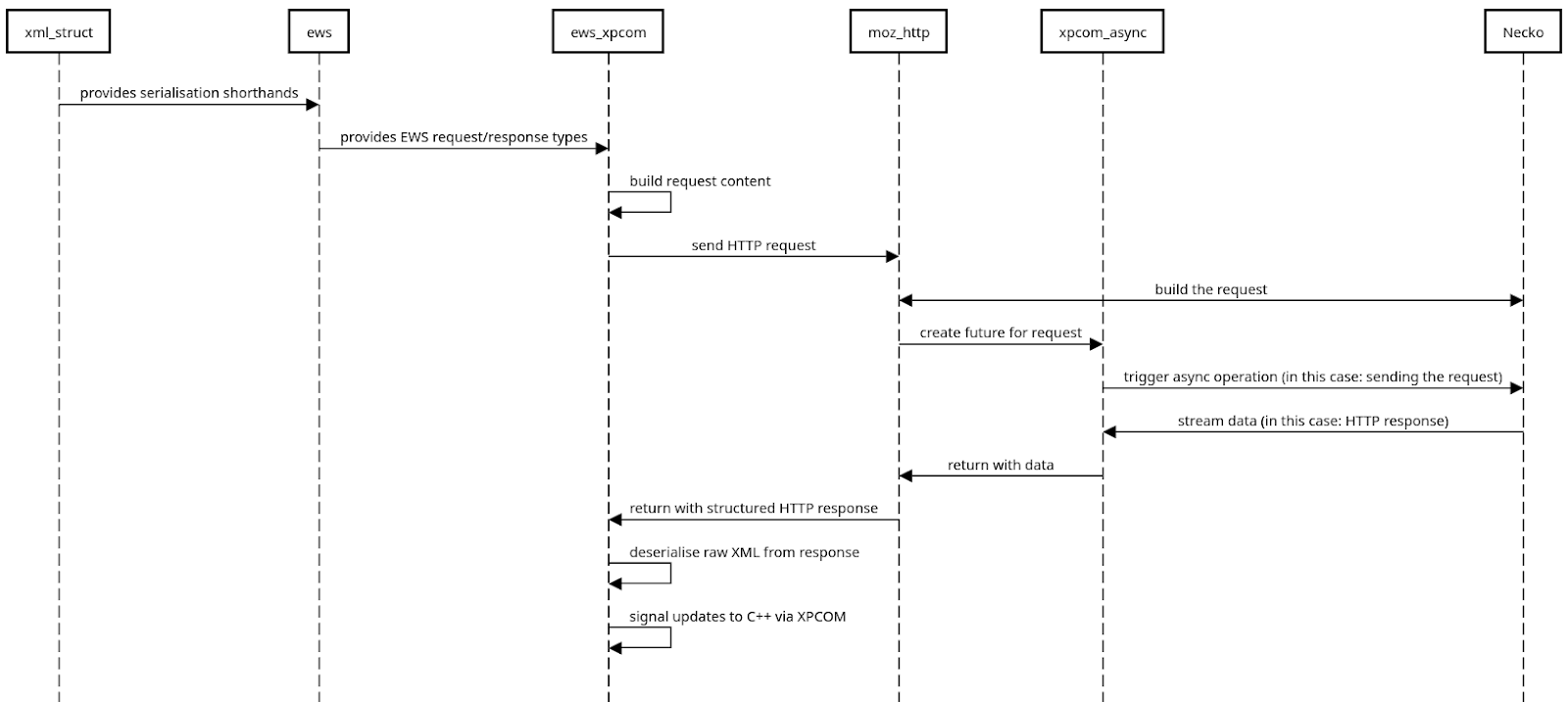
Fig 1. A bird’s eye view of the flow
What’s next?
Testing all the things
Before landing our next major features, we are taking some time to build out our automated tests. In addition to unit tests, we just landed a mock EWS server for integration testing. The current focus on testing is already paying dividends, having exposed a couple of crashes and some double-sync issues which have since been rectified. Going forward, new features can now be easily tested and verified.
Improving error handling
While we are working on testing, we are also busy improving the story around error handling. EWS’s error behavior is often poorly documented, and errors can occur at multiple levels (e.g., a request may fail as a whole due to throttling or incorrect structure, or parts of a request may succeed while other parts fail due to incorrect IDs). Some errors we can handle at the protocol level, while others may require user intervention or may be intractable. In taking the time now to improve error handling, we can provide a more polished implementation and set ourselves up for easier long-term maintenance.
Expanding support
We are working on expanding protocol support for EWS (via ews and the internal ews_xpcom crate) and hooking it into the Thunderbird UI. Earlier this month, we landed a series of patches which allow adding an EWS account to Thunderbird, syncing the account’s folder hierarchy from the remote server, and displaying those folders in the UI. (At present, this alpha-state functionality is gated behind a build flag and a preference.) Next up, we’ll work on fetching message lists from the remote server as well as generalizing outgoing mail support in Thunderbird.
Documentation
Of course, all of our work on maintainability is for naught if no one understands what the code does. To that end, we’re producing documentation on how all of the bits we have talked about here come together, as well as describing the existing architecture of mail protocols in Thunderbird and thoughts on future improvements, so that once the work of supporting EWS is done, we can continue building and improving on the Thunderbird you know and love.
QUESTIONS FROM YOU
EWS is deprecated for removal in 2026. Are there plans to add support for Microsoft Graph into Thunderbird?
This is a common enough question that we probably should have addressed it in the post! EWS will no longer be available for Exchange Online in October 2026, but our research in the lead-up to this project showed that there’s a significant number of users who are still using on-premise installs of Exchange Server. That is, many companies and educational institutions are running Exchange Server on their own hardware.
These on-premise installs largely support EWS, but they cannot support the Azure-based Graph API. We expect that this will continue to be the case for some time to come, and EWS provides a means of supporting those users for the foreseeable future. Additionally, we found a few outstanding issues with the Graph API (which is built with web-based services in mind, not desktop applications), and adding EWS support allows us to take some extra time to find solutions to those problems before building Graph API support.
Diving into the past has enabled a sound engineering-led strategy for dealing with the future: Thanks to the deep dive into the existing Thunderbird architecture we can begin to leverage more efficient and productive patterns and technologies when implementing protocols.
In time this will have far reaching consequences for the Thunderbird code base which will not only run faster and more reliably, but significantly reduce maintenance burden when landing bug fixes and new features.
Rust and EWS are elements of a larger effort in Thunderbird to reduce turnarounds and build resilience into the very core of the software.
The post Adventures In Rust: Bringing Exchange Support To Thunderbird appeared first on The Thunderbird Blog.
]]>The post April 2024 Community Office Hours: Rust and Exchange Support appeared first on The Thunderbird Blog.
]]>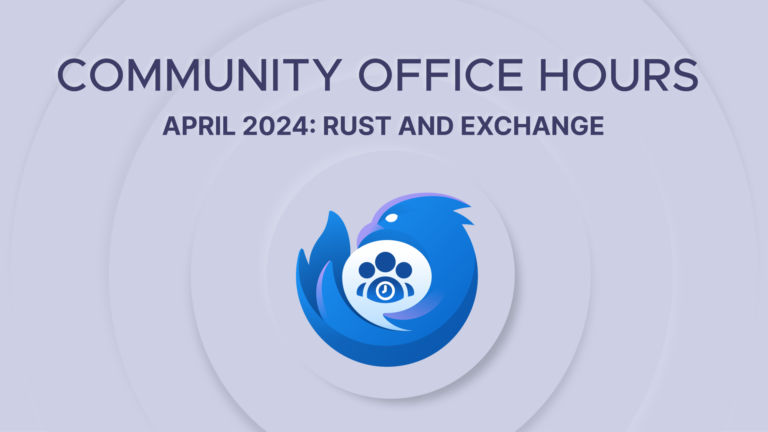
We admit it. Thunderbird is getting a bit Rusty, but in a good way! In our monthly Development Digests, we’ve been updating the community about enabling Rust in Thunderbird to implement native support for Exchange. Now, we’d like to invite you for a chat with Team Thunderbird and the developers making this change possible. As always, send your questions in advance to officehours@thunderbird.net! This is a great way to get answers even if you can’t join live.
Be sure to note the change in day of the week and the UTC time. (At least the time changes are done for now!) We had to shift our calendar a bit to fit everyone’s schedules and time zones!
April Office Hours: Rust and Exchange
This month’s topic is a new and exciting change to the core functionality: using Rust to natively support Microsoft Exchange. Join us and talk with the three key Thunderbird developers responsible for this shiny (rusty) new addition: Sean Burke, Ikey Doherty, and Brendan Abolivier! You’ll find out why we chose Rust, challenges we encountered, how we used Rust to interface with XPCOM and Necko to provide Exchange support. We’ll also give you a peek into some future plans around Rust.
Catch Up On Last Month’s Thunderbird Community Office Hours
While you’re thinking of questions to ask, watch last month’s office hours where we answered some of your frequently asked recent questions. You can watch clips of specific questions and answers on our TILvids channel. If you’d prefer a written summary, this blog post has you covered.
Join The Video Chat
We’ve also got a shiny new Big Blue Button room, thanks to KDE! We encourage everyone to check out their Get Involved page. We’re grateful for their support and to have an open source web conferencing solution for our community office hours.
Date and Time: Tuesday, April 23 at 16:00 UTC
Direct URL to Join: https://meet.thunderbird.net/b/hea-uex-usn-rb1
Access Code: 964573
The post April 2024 Community Office Hours: Rust and Exchange Support appeared first on The Thunderbird Blog.
]]>The post Team Thunderbird Answers Your Most Frequently Asked Questions appeared first on The Thunderbird Blog.
]]>
We know the Thunderbird community has LOTS of questions! We get them on Mozilla Support, Mastodon, and X.com (formerly Twitter). They pop up everywhere, from the Thunderbird subreddit to the teeming halls of conferences like FOSDEM and SCaLE. During our March Community Office Hours, we took your most frequently asked questions to Team Thunderbird and got some answers. If you couldn’t watch the full session, or would rather have the answers in abbreviated text clips, this post is for you!
Thunderbird for Android / K-9 Mail
The upcoming release on Android is definitely on everyone’s mind! We received lots of questions about this at our conference booths, so let’s answer them!
Will there be Exchange support for Thunderbird for Android?
Yes! Implementing Exchange in Rust in the Thunderbird Desktop client will enable us to reuse those Rust crates as shared libraries with the Mobile client. Stay up to date on Exchange support progress via our monthly Developer Digests.
Will Thunderbird Add-ons be available on Android?
Right now, no, they will not be available. K-9 Mail uses a different code base than Thunderbird Desktop. Thunderbird add-ons are designed for a desktop experience, not a mobile one. We want to have add-ons in the future, but this will likely not happen within the next two years.
When Thunderbird for Android launches, will it be available on F-Droid?
It absolutely will.
When Thunderbird for Android is ready to be released, what will the upgrade path look like?
We know some in the K-9 Mail community love their adorable robot dog and don’t want to give him up yet. So we will support K-9 Mail (same code, different brand) in parallel for a year or two, until the product is more mature, and we see that more K-9 Mail users are organically switching.
Because of Android security, users will need to manually migrate from K-9 Mail to Thunderbird for Android, versus an automatic migration. We want to make that effortless and unobtrusive, and the Sync feature using Mozilla accounts will be a large part of that. We are exploring one-tap migration tools that will prompt you to switch easily and keep all your data and settings – and your peace of mind.
Will CalDAV and CardDAV be available on Thunderbird for Android?
Probably! We’re still determining this, but we know our users like having their contacts and calendars inside one app for convenience, as well as out of privacy concerns. While it would be a lot of engineering effort, we understand the reasoning behind these requests. As we consider how to go forward, we’ll release all these explorations and ideas in our monthly updates, where people can give us feedback.
Will the K-9 Mail API provide the ability to download the save preferences that Sync stores locally to plug into automation like Ansible?
Yes! Sync is open source, so users can self-host their own instead of using Mozilla services. This question touches on the differences between data structure for desktop and mobile, and how they handle settings. So this will take a while, but once we have something stable in a beta release, we’ll have articles on how to hook up your own sync server and do your own automation.
Thunderbird for Desktop
When will we have native Exchange support for desktop Thunderbird?
We hope to land this in the next ESR (Extended Support Release), version 128, in limited capacity. Users will still need to use the OWL Add-on for all situations where the standard exchange web service is not available. We don’t yet know if native calendar and address book support will be included in the ESR. We want to support every aspect of Exchange, but there is a lot of code complexity and a history of changes from Microsoft. So our primary goal is good, stable support for email by default, and calendar and address book if possible, for the next ESR.
When will conversations and a true threaded view be added to Thunderbird?
Viewing your own sent emails is an important component of a true conversation view. This is a top priority and we’re actively working towards it. Unfortunately, this requires overhauling the backend database that underlies Thunderbird, which is 20 years old. Our legacy database is not built to handle conversation views with received and sent messages listed in the same thread. Restructuring a two decades old database is not easy. Our goal is to have a new global message database in place by May 31. If nothing has exploded, it should be much easier to enable conversation view in the front end.
When will we get a full sender name column with the raw email address of the sender? This will help further avoid phishing and spam.
We plan to make this available in the next ESR — Thunderbird 128 — which is due July 2024.
Will there ever be a browser-based view of Thunderbird?
Despite our foundations in Firefox, this is a huge effort that would have to be built from scratch. This isn’t on our roadmap and not in our plans for now. If there was a high demand, we might examine how feasible this could be. Alex explains this in more detail during the short video below:
The post Team Thunderbird Answers Your Most Frequently Asked Questions appeared first on The Thunderbird Blog.
]]>The post Thunderbird for Android / K-9 Mail: March 2024 Progress Report appeared first on The Thunderbird Blog.
]]>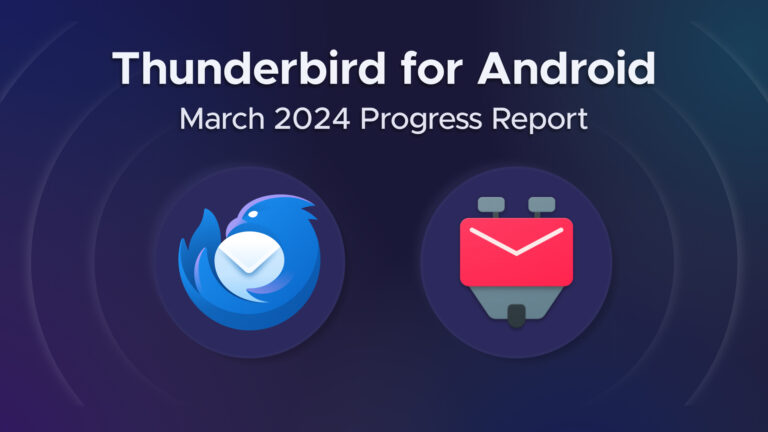
If you’ve been wondering how the work to turn K-9 Mail into Thunderbird for Android is coming along, you’ve found the right place. This blog post contains a report of our development activities in March 2024.
We’ve published monthly progress reports for a while now. If you’re interested in what happened previously, check out February’s progress report. The report for the preceding month is usually linked in the first section of a post. But you can also browse the Android section of our blog to find progress reports and release announcements.
Fixing bugs
For K-9 Mail, new stable releases typically include a lot of changes. K-9 Mail 6.800 was no exception. That means a lot of opportunities to accidentally introduce new bugs. And while we test the app in several ways – manual tests, automated tests, and via beta releases – there’s always some bugs that aren’t caught and make it into a stable version. So we typically spend a couple of weeks after a new major release fixing the bugs reported by our users.
K-9 Mail 6.801
Stop capitalizing email addresses
One of the known bugs was that some software keyboards automatically capitalized words when entering the email address in the first account setup screen. A user opened a bug and provided enough information ( ) for us to reproduce the issue and come up with a fix.
) for us to reproduce the issue and come up with a fix.
Line breaks in single line text inputs
At the end of the beta phase a user noticed that K-9 Mail wasn’t able to connect to their email account even though they copy-pasted the correct password to the app. It turned out that the text in the clipboard ended with a line break. The single line text input we use for the password field didn’t automatically strip that line break and didn’t give any visual indication that there was one.
While we knew about this issue, we decided it wasn’t important enough to delay the release of K-9 Mail 6.800. After the release we took some time to fix the problem.
DNSSEC? Is anyone using that?
When setting up an account, the app attempts to automatically find the server settings for the given email address. One part of this mechanism is looking up the email domain’s MX record. We intended for this lookup to support DNSSEC and specifically looked for a library supporting this.
Thanks to a beta tester we learned that DNSSEC signatures were never checked. The solution turned out to be embarrassingly simple: use the library in a way that it actually validates signatures.
Strange error message on OAuth 2.0 failure
A user in our support forum reported a strange error message (“Cannot serialize abstract class com.fsck.k9.mail.oauth.XOAuth2Response”) when using OAuth 2.0 while adding their email account. Our intention was to display the error message returned by the OAuth server. Instead an internal error occurred.
We tracked this down to the tool optimizing the app by stripping unused code and resources when building the final APK. The optimizer was removing a bit too much. But once the issue was identified, the fix was simple enough.
Crash when downloading an attachment
Shortly after K-9 Mail 6.800 was made available on Google Play, I checked the list of reported app crashes in the developer console. Not a lot of users had gotten the update yet. So there were only very few reports. One was about a crash that occurred when the progress dialog was displayed while downloading an attachment.
The crash had been reported before. But the number of crashes never crossed the threshold where we consider a crash important enough to actually look at.
It turned out that the code contained the bug since it was first added in 2017. It was a race condition that was very timing sensitive. And so it worked fine much more often than it did not.
The fix was simple enough. So now this bug is history.
Don’t write novels in the subject line
The app was crashing when trying to send a message with a very long subject line (around 1000 characters). This, too, wasn’t a new bug. But the crash occurred rarely enough that we didn’t notice it before.
The bug is fixed now. But it’s still best practice to keep the subject short!
Work on K-9 Mail 6.802
Even though we fixed quite a few bugs in K-9 Mail 6.801, there’s still more work to do. Besides fixing a couple of minor issues, K-9 Mail 6.802 will include the following changes.
F-Droid metadata
In preparation of building two apps (Thunderbird for Android and K-9 Mail), we moved the app description and screenshots that are used for F-Droid’s app listing to a new location inside our source code repository. We later found out that this new location is not supported by F-Droid, leading to an empty app description on the F-Droid website and inside their app.
We switched to a different approach and hope this will fix the app description once K-9 Mail 6.802 is released.
Push not working due to missing permission
Fresh installs of the app on Android 14 no longer automatically get the permission to schedule exact alarms. But this permission is necessary for Push to work. This was a known issue. But since it only affects new installs and users can manually grant this permission via Android settings, we decided not to delay the stable release until we added a user interface to guide the user through the permission flow.
K-9 Mail 6.802 will include a first step to improve the user experience. If Push is enabled but the permission to schedule exact alarms hasn’t been granted, the app will change the ongoing Push notification to ask the user to grant this permission.
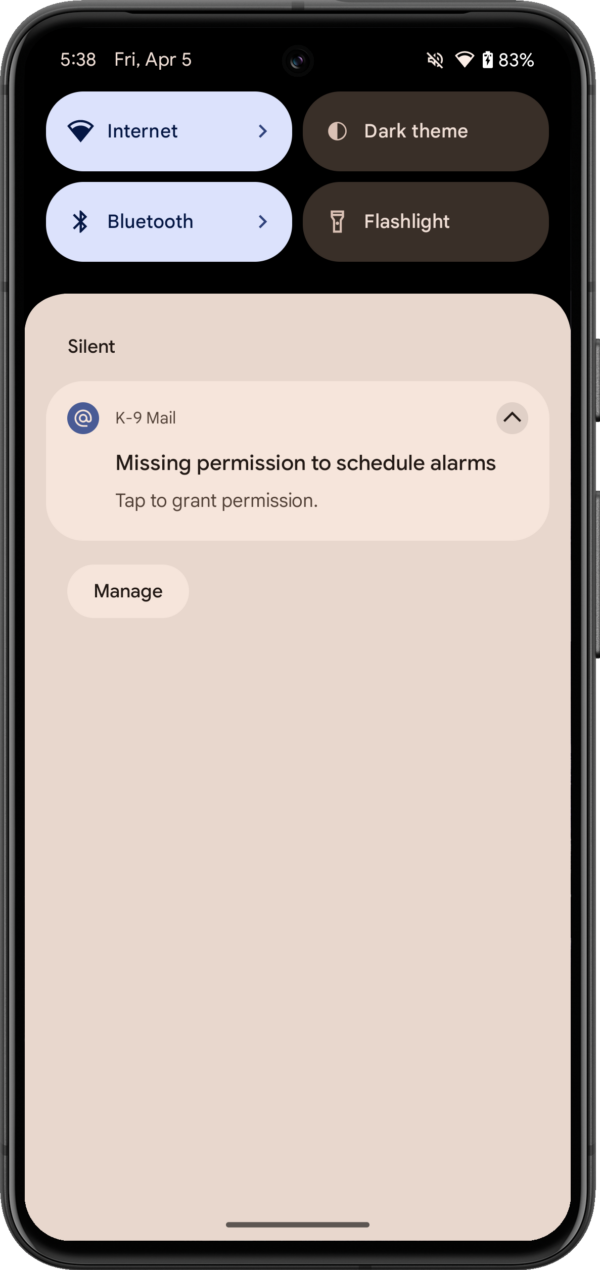
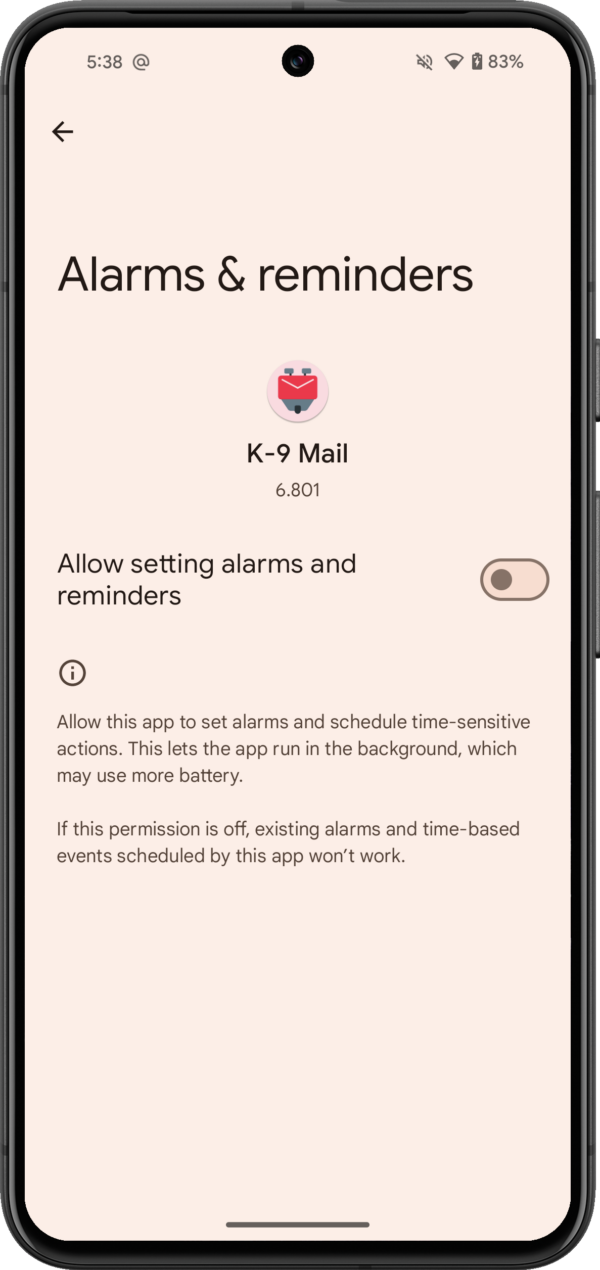
In a future update we’ll expand on that and ask the user to grant the permission before allowing them to enable Push.
What about new features?
Of course we haven’t forgotten about our roadmap. As mentioned in February’s progress report we’ve started work on switching the user interface to use Material 3 and adding/improving Android 14 compatibility.
There’s not much to show yet. Some Material 3 changes have been merged already. But the user interface in our development version is currently very much in a transitional phase.
The Android 14 compatibility changes will be tested in beta versions first, and then back-ported to K-9 Mail 6.8xx.
Releases
In March 2024 we published the following stable release:
- K-9 Mail v6.801 (2024-03-11)
There hasn’t been a release of a new beta version in March.
The post Thunderbird for Android / K-9 Mail: March 2024 Progress Report appeared first on The Thunderbird Blog.
]]>The post Automated Testing: How We Catch Thunderbird Bugs Before You Do appeared first on The Thunderbird Blog.
]]>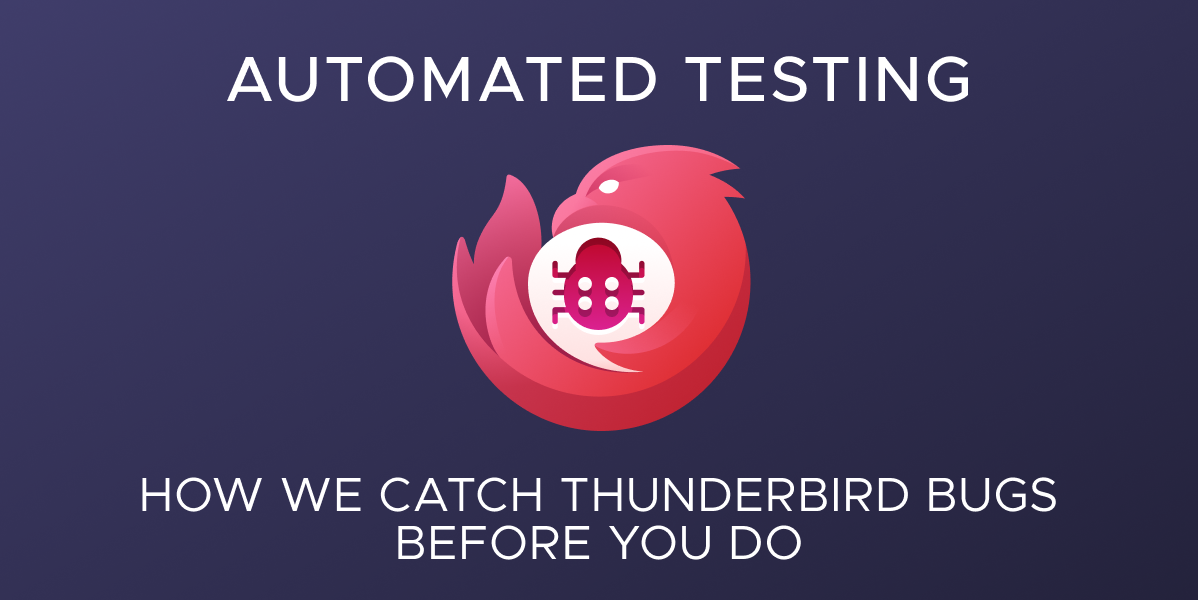
Since the release of Thunderbird 115, a big focus has been on improving the state of our automated testing. Automated testing increases the software quality by minimizing the number of bugs accidentally introduced by changes to the code. For each change made to Thunderbird, our testing machines run a set of tests across Windows, macOS, and Linux to detect mistakes and unintended consequences. For a single change (or a group of changes that land at the same time), 60 to 80 hours of machine time is used running tests.
Our code is going to be under more pressure than ever before – with a bigger team making more changes, and monthly releases reducing the time code spends on testing channels before being released.
We want to find the bugs before our users do.
Why We’re Testing
We’re not writing tests merely to make ourselves feel better. Tests improve Thunderbird by:
- Preventing mistakes
If we test that some code behaves in an expected way, we’ll find out immediately if it no longer behaves that way. This means a shorter feedback loop, and we can fix the problem before it annoys the users. - Finding out when somebody upstream breaks us
Thunderbird is built from the Firefox code. The Firefox code, which we are not responsible for, is 30 to 40 times the size of the code we are responsible for. When something inevitably changes in Firefox that affects us, we want to know about it immediately so that we can respond. - Freeing up human testers
If we use computers to prove that the program does what it’s supposed to do, particularly if we avoid tedious repetition and difficult-to-set-up tasks, then the limited human resources we have can do more things that humans are better at.
For example, I’ve recently added tests that check 22 ways to trigger fetching mail, and 10 circumstances fetching mail might not work. There’s no way our human testers (great though they are) are testing all of them, but our automated tests can and do, several times a day. - Thinking through what the code should be doing
Testing forces an engineer to look at the code from a different point-of-view, and this is helpful to think about what the code is supposed to do in more circumstances. It also makes it easier to prove that the code does work in obscure circumstances. - Finding existing bugs
In software terms we’re working with some very old code, and much of it is untested. Testing it puts a fresh set of eyes on the code and reveals some of the mistakes of the past, and where the ravages of time have broken things. It also helps the person writing the tests to understand what the code does, a lot better than just reading the code does.
We’re not trying to completely cover a feature or every edge case in tests. We are trying to create a testing framework around the feature so that when we find a bug, as well as fixing it, we can easily write a test preventing the bug from happening again without being noticed. For too much of the code, this has been impossible without a weeks-long detour into tests.
Breaking New Ground
In the past few months we’ve figured out how to make automated tests for things that were previously impossible:
- Communication with mail servers using encrypted channels.
- OAuth2 authentication with mail servers.
- Communication with web servers where a specific address must be used and an unencrypted channel must not be used.
- Servers at any given host name or port. Previously, if we wanted to start a server for automated testing, it had to be on the local machine at a non-standard location. Now we can pretend that the server is anywhere, and using standard ports, which is needed for proper testing of account configuration features. (Actually, this was possible before, but now it’s much easier.)
These new abilities are being used to wrap better testing around account set-up features, ahead of the new Account Hub development, so that we can be sure nothing breaks without being noticed. They’re also helping test that collecting mail works when it should, or gives the error prompts we expect when it doesn’t.
Code coverage
We record every line of code that runs during our tests. Collecting all that data tells what code doesn’t run during our tests. If a block of code doesn’t run during any of our tests, nothing will tell us when it breaks until somebody uses the code and complains.
Our code coverage data can be viewed at coverage.thunderbird.net. You can also look at Firefox’s data at coverage.moz.tools.
Looking at the data, you might notice that our overall number is now lower than it was when we started measuring. This doesn’t mean that our testing got worse, it actually shows where we added a lot of code (that isn’t maintained by us) in the third_party directory. For a better reflection of the progress we’ve made, check out the individual directories, especially mail/base which contains the most important user interface code.
- Just setting up the code coverage tools and looking at the results uncovered several memory leaks. (A memory leak is where memory is allocated for a task and not released when it is no longer needed.) We fixed these leaks and some more that existed in our test code. We now have very low levels of memory leaking in our test runs, so if we make a mistake it is easy to spot.
- Code coverage data can also point to code that is no longer used. We’ve removed some big chunks of this dead code, which means we’re not wasting time maintaining it.
Mozmill no more
Towards the end of last year we finally retired an old test suite known as Mozmill. Those tests were partially migrated to a different test suite (Mochitest) about four years ago, and things were mostly working fine so it wasn’t a priority to finish. These tests now do things in a more conventional way instead of relying on a bunch of clever but weird tricks.
How much of the code is test code?
About 27%. This is a very rough estimate based on the files in our code repository (minus some third-party directories) and whether they are inside a directory with “test” in the name or not. That’s risen from about 19% in the last five years.
There is no particular goal in mind, but I can imagine a future where there is as much test code as non-test code. If we achieve that, Thunderbird will be in a very healthy place.

Looking ahead, we’ll be asking contributors to add tests to their patches more often. This obviously depends on the circumstance. But if you’re adding or fixing something, that is the best time to ensure it continues to work in the future. As always, feel free to reach out if you need help writing or running tests, either via Matrix or Topicbox mailing lists:
- Matrix: You can join our development chat channel at #maildev:mozilla.org
- Topicbox mailing list: The Thunderbird Developers list a good place to raise questions about Thunderbird development.
Geoff Lankow, Staff Engineer
The post Automated Testing: How We Catch Thunderbird Bugs Before You Do appeared first on The Thunderbird Blog.
]]>The post Thunderbird Time Machine: Was Thunderbird 3.0 Worth The Wait? appeared first on The Thunderbird Blog.
]]>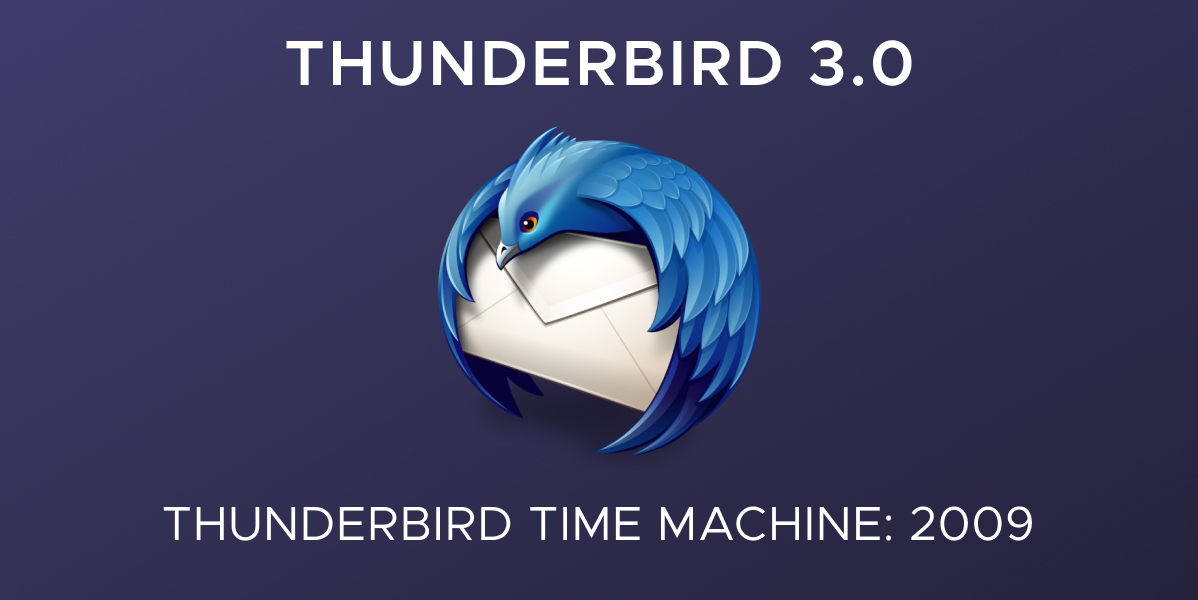
Let’s step back into the Thunderbird Time Machine and teleport ourselves back to December 2009. If you were on the bleeding edge, maybe you were upgrading your computer to the newly released Windows 7 (or checking out Ubuntu 9.10 “Karmic Koala”.) Perhaps you were pouring all your free time into Valve’s ridiculously fun team-based survival shooter Left 4 Dead 2. And maybe, just maybe, you were eagerly anticipating installing Thunderbird 3.0 — especially since it had been a lengthy two years since Thunderbird 2.0 had launched.
What happened during those two years? The Thunderbird developer community — and Mozilla Messaging — clearly stayed busy and productive. Thunderbird 3.0 introduced several new feature milestones!
1) The Email Account Wizard
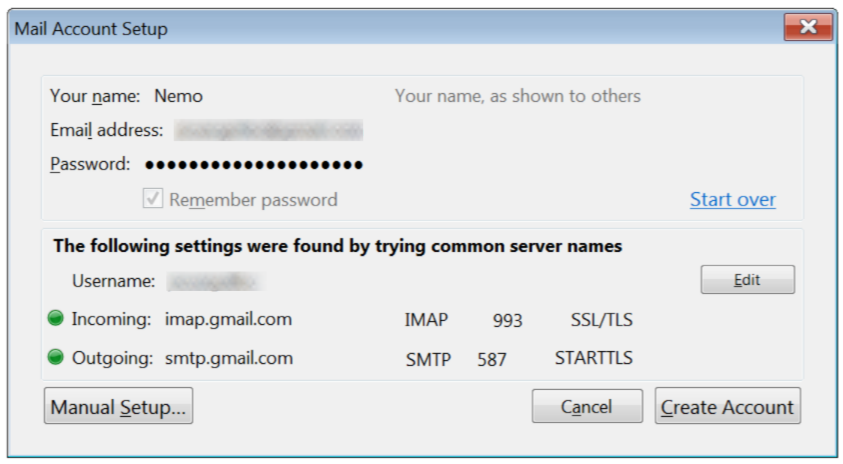
We take it for granted now, but in the 2000s, adding an account to an email client wasn’t remotely simple. Traditionally you needed to know your IMAP/POP3 and SMTP server URLs, port numbers, and authentication settings. When Thunderbird 3.0 launched, all that was required was your username and password for most mainstream email service providers like Yahoo, Hotmail, or Gmail. Thunderbird went out and detected the rest of the settings for you. Neat!
2) A New Tabbed Interface
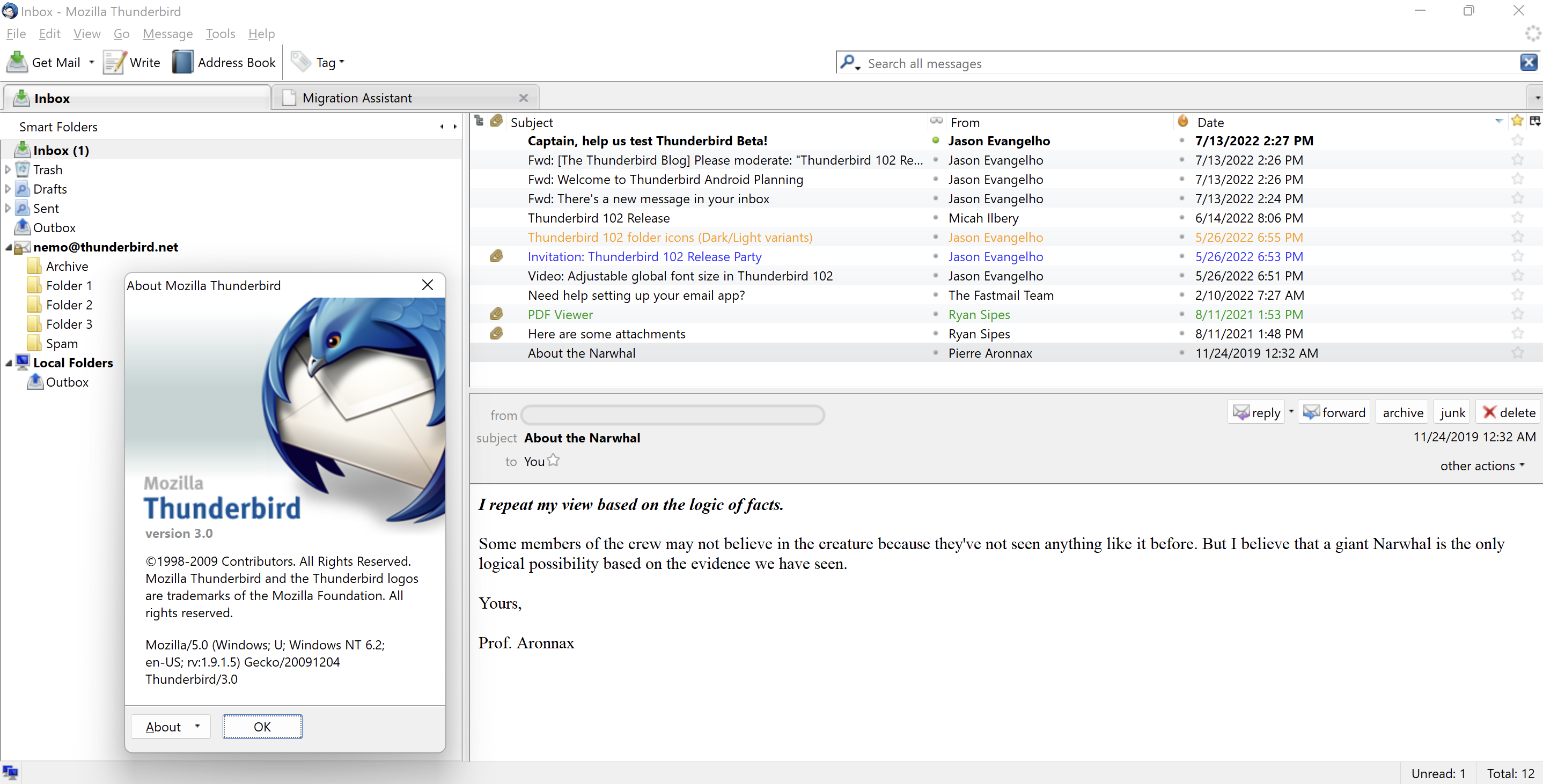
With Firefox at its core, Thunderbird followed in the footsteps of most web browsers by offering a tabbed interface. Imagine! Being able to quickly tab between various searches and emails without navigating a chaotic mess of separate windows!
3) A New Add-on Manager

Speaking of Firefox, Thunderbird quickly adopted the same kind of Add-on Manager that Firefox had recently integrated. No need to fire up a browser to search for useful extensions to Thunderbird — now you could search and install new functionality from right inside Thunderbird itself.
4) Advanced Search Options
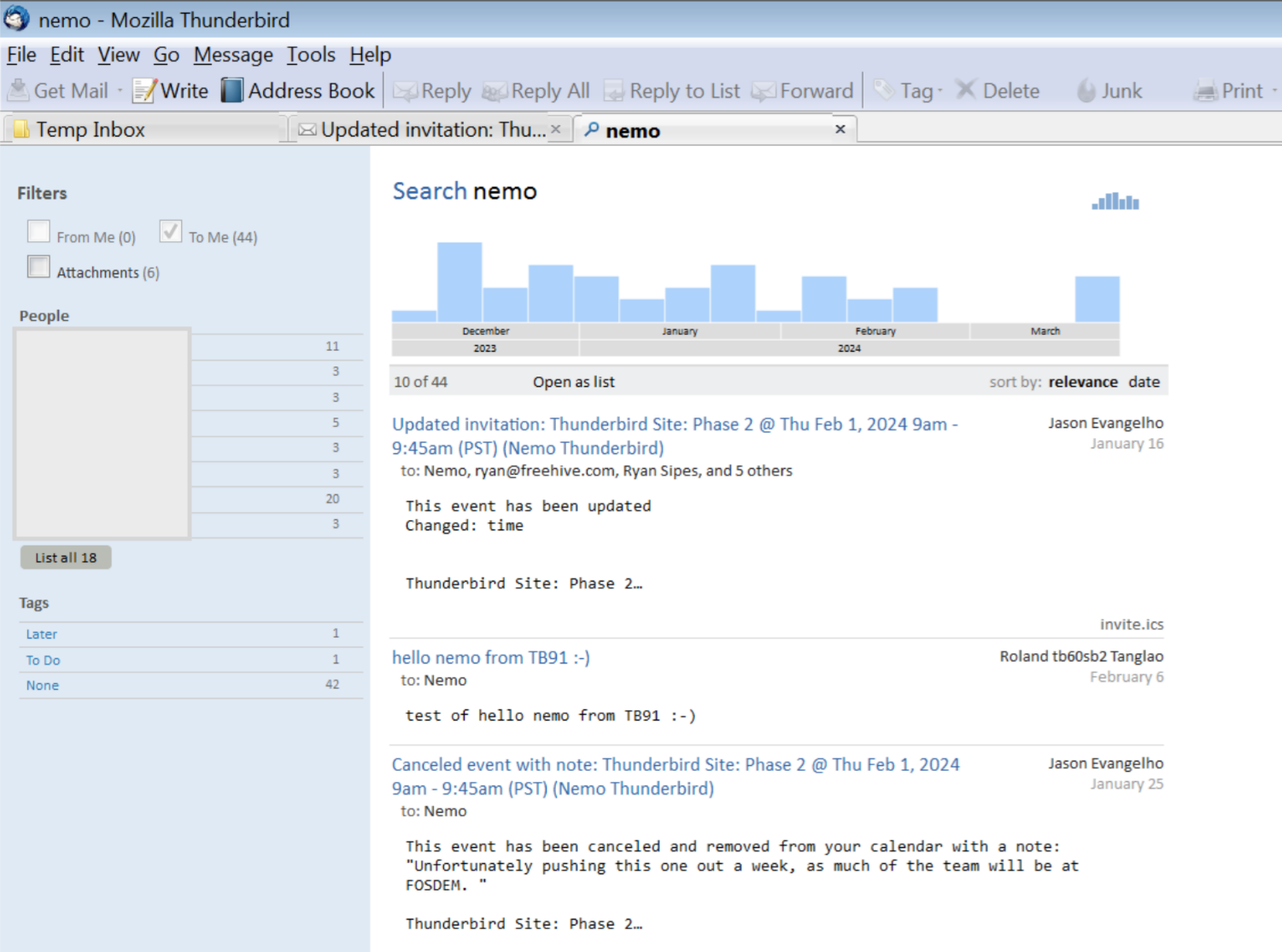
Searching your emails got a massive boost in Thunderbird 3.0. Advanced filtering tools means you could filter your results by sender, attachments, people, folders, and more. A shiny new timeline view was also introduced, letting you jump directly to a certain date’s results.
5) The Migration Assistant
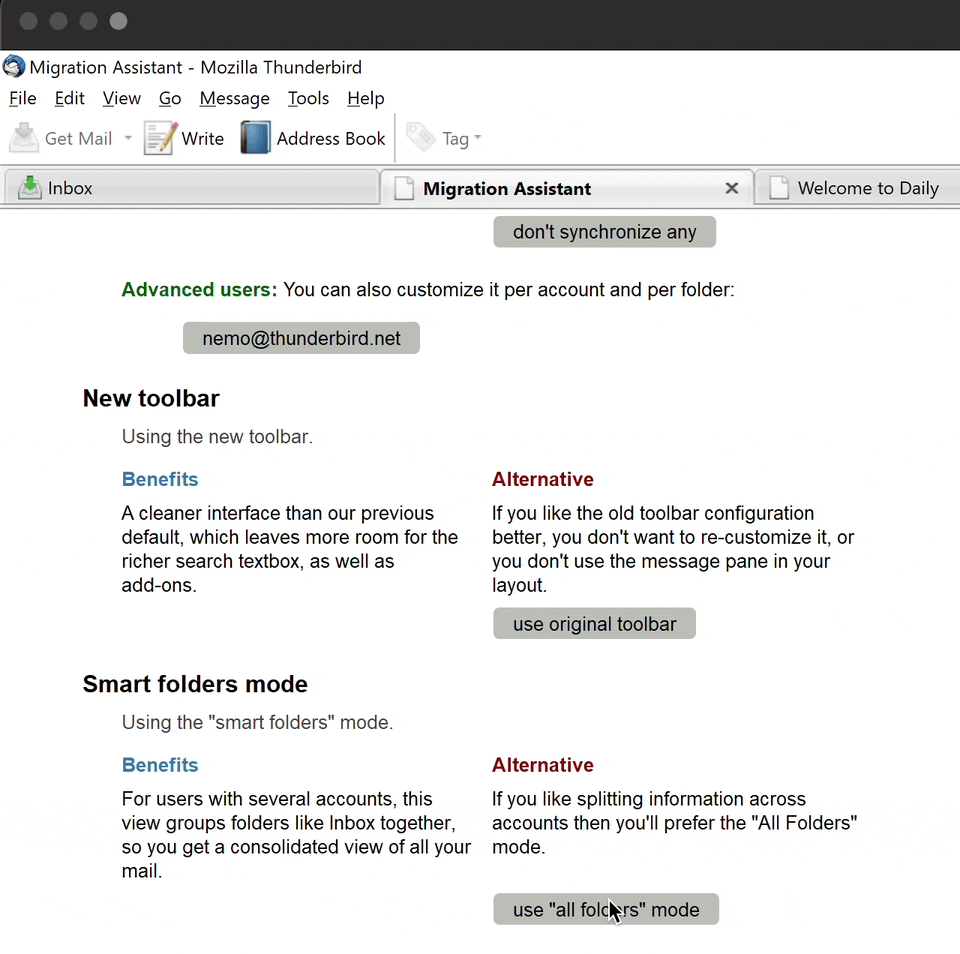
Tying this all together was a simple but wonderful migration assistant. It served as a way to introduce users to certain new features (like per-account IMAP synchronization), and visually toggle them on or off (useful for displaying the revised Message Toolbar and giving users a choice of where to enjoy it). To me, this particular addition felt ahead of its time. We’ve been discussing the idea of re-introducing it in a future Thunderbird release, but one of the steep hurdles to doing so now is localization. If it’s something you’d like to see, let us know in the comments.
Try It Out For Yourself
If you want to personally step into the Thunderbird Time Machine, every version ever released for Windows, Linux, and macOS is available in this archive. I ran mine inside of a Windows 7 virtual machine, since my native Linux install complained about missing libraries when trying to get Thunderbird 3.0 running.
Regardless if you’re a new Thunderbird user or a veteran who’s been with us since 2003, thanks for being on the journey with us!
Previous Time Machine Destinations:
The post Thunderbird Time Machine: Was Thunderbird 3.0 Worth The Wait? appeared first on The Thunderbird Blog.
]]>The post ThunderSnap! Why We’re Helping Maintain The Thunderbird Snap On Linux appeared first on The Thunderbird Blog.
]]>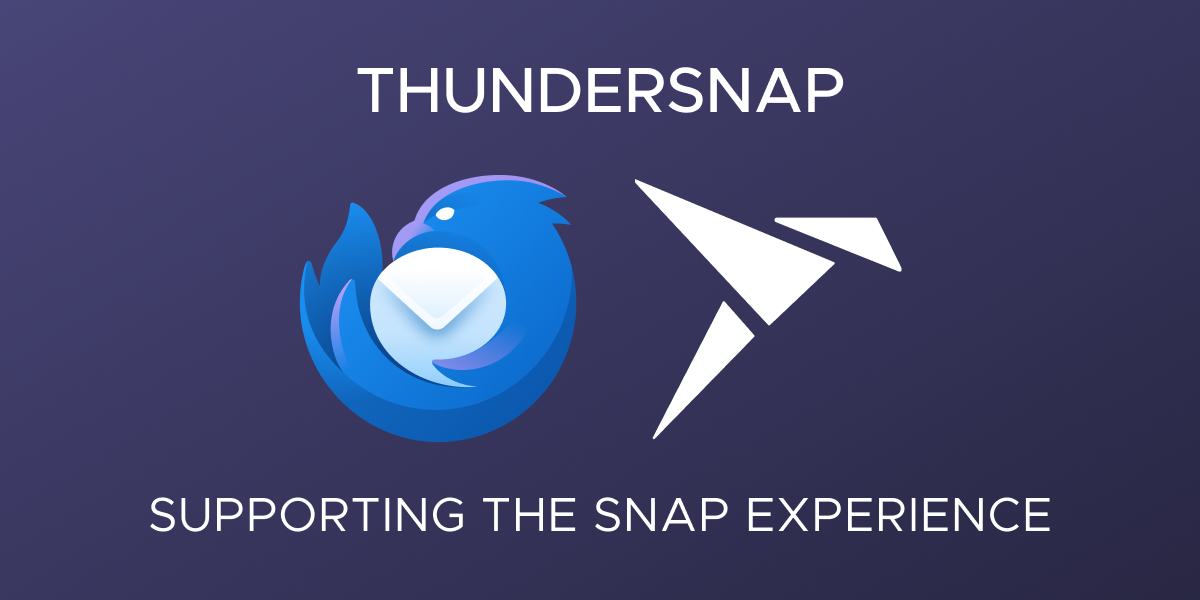
We love our Linux users across all Linux distributions. That is why we’ve stepped up to help maintain the Thunderbird Snap available in the Snap Store.
Last year we took ownership of the Thunderbird Flatpak, and it has been our officially recommended package for Linux users. However, we are expanding our horizons to make sure the Thunderbird Snap experience is officially supported too. We at Thunderbird are team “free software”, independent of the packaging technology. This will mostly affect our Ubuntu users but there are plenty of other Snap users out there as well.
Why support both the Snap and Flatpak?
In the spirit of free software, we want to support as many of our users as possible without discriminating on their package preferences. We are not a large company with infinite resources, so we can’t support everything under the sun. But we can make informed decisions that reach the majority of our Linux users.
The Thunderbird Snap has been well maintained by the Ubuntu desktop team for years, and we felt it was time to step up and help out.
What does this mean for me?
If you are an Ubuntu user, then you may already be using the Thunderbird Snap. The next release of Ubuntu is 24.04 (available April 25) and will be the first Ubuntu release that seeds the Thunderbird Snap on the ISO. So if you do a fresh full install of Ubuntu, you will be using the Thunderbird Snap that you know is directly supported by the Thunderbird team.
If you are not an Ubuntu user but Snaps are still a part of your life, then you will still benefit from the same rolling updates provided by the Snap experience.
What changes are expected?
From a user perspective, you should see no changes. Just keep using whichever Thunderbird Snap channel you are comfortable with.
From a developer perspective, we have added the Snap build to our build infrastructure on treeherder. This means whenever a full build is triggered automatically from commits, the Snap is built as well for testing. Whenever the build is one we want to release to the public, this will trigger a general flow:
- A version bump is pushed to the existing Thunderbird Snap github repository.
- The existing launchpad mirror will pick up this change and automatically build the Snap for x86 and arm64.
- If the launchpad Snap build succeeds, the Snap will be uploaded to the designated Snap store channel.
So all we are changing is adding the snap build into the Thunderbird build infrastructure and plugging it into the existing automation that feeds the snap store.
Where do I report a bug on the Thunderbird Snap?
As with all supported package types of Thunderbird, we would like bugs about the Thunderbird Snap to be reported on bugzilla.mozilla.org under the Thunderbird project.
The post ThunderSnap! Why We’re Helping Maintain The Thunderbird Snap On Linux appeared first on The Thunderbird Blog.
]]>The post Thunderbird Monthly Development Digest: March 2024 appeared first on The Thunderbird Blog.
]]>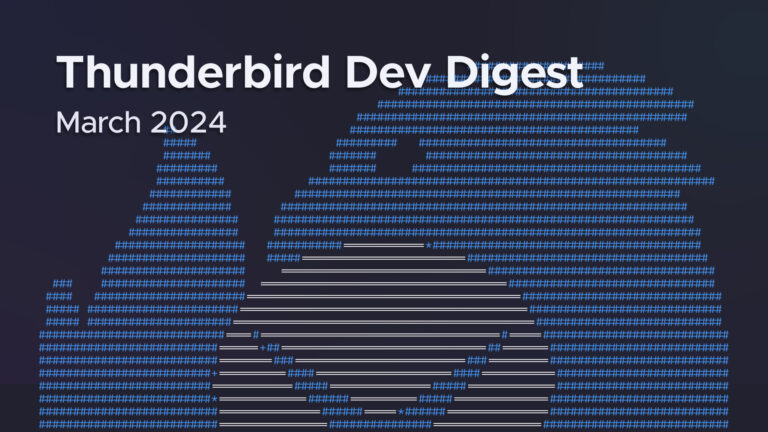
Hello Thunderbird Community! March is over, which means it’s time for another Development Digest to share the current progress and product direction of Thunderbird development.
Is this your first time reading the Development Digest? Find them all using the Dev Digest tag!
Rust and Exchange
It seems that this section is part of every Development Digest! But that’s the reality of these large efforts, spanning across multiple months with slow but steady progress.
This month we completed initial Exchange Autodiscovery and compatibility with OAuth in our account setup flow, as well as fetching and rendering of all folders. Some areas still need polish and clean up. But work continues towards having things behind a pref in the next beta release. You can follow the progress in this bug.
Meanwhile, here are some goodies to try if you need to parse the Microsoft Exchange Web Services data set and the current crates for serializing and deserializing XML don’t serve you well. https://github.com/thunderbird/xml_struct
List management
Shout out to Magnus for implementing the first step towards a more manageable mailing list subscription flow. An initial implementation of the List Management feature just landed on daily and beta, and it was recently announced in the tb-beta mailing list with a screenshot to show it in action.
It’s currently accessible via a context menu on the List ID. But we’re planning to do some UX and UI explorations to find the best way to expose it without making it annoying.
You can follow the work from this bug.
Esmification completed!
Another big shout out to Magnus for finishing the ESMification effort! As users, you won’t see or notice any difference, but for developers this substantial architectural change saw the removal of all .jsm files in favor of standard JavaScript modules.
A huge win for a more standardized code base! This allows us to leverage all the nice features of modern JavaScript in Thunderbird development.
Tiny changes and improvements in Thunderbird development
A lot of nice quality of life improvements tend to happen in small chunks that are not easy to see or spot right away.
Here’s a list of the projects we’re actively working on and will be focusing on for the next month:
- Cards view UI completion.
- Fixed missing FindBar in multimessage and browser view.
- Implementation of a new visual selection paradigm.
- Improvements to usability and accessibility of the Quick Filter bar.
- Completion of the email setup in the new Account Hub.
- Many add-ons API improvements and additions (big shout out to John).
- Support for viewing nested signed messages and other OpenPGP improvements.
Stay tuned and make sure to sign up to our mailing lists to get detailed updates on all the items in this list, and a lot more.
As usual, if you want to see things as they land you can always check the pushlog and try running daily, which would be immensely helpful for catching bugs early.
See ya next time in our April Development Digest.
Alessandro Castellani (he, him)
Director of Product Engineering
If you’re interested in joining the technical discussion around Thunderbird development, consider joining one or several of our mailing list groups here.
The post Thunderbird Monthly Development Digest: March 2024 appeared first on The Thunderbird Blog.
]]>The post March 2024 Community Office Hours: Open Forum and FAQ appeared first on The Thunderbird Blog.
]]>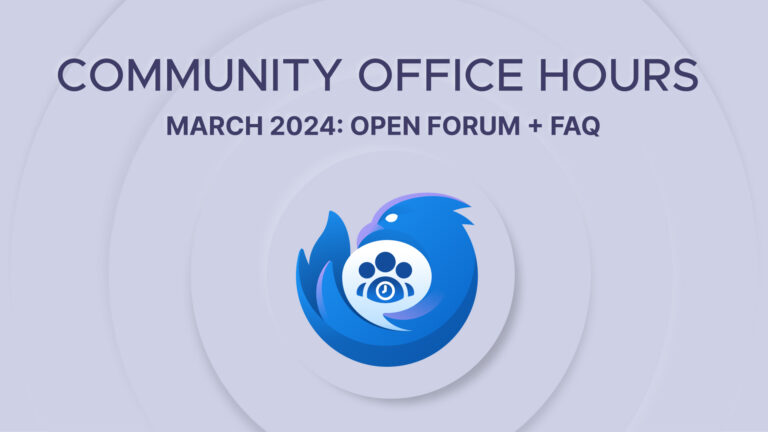
This month’s topics for our Thunderbird Community Office Hours will be decided by you! We’d like to invite the community to bring their questions, comments, and general conversation to Team Thunderbird for an informal and informational chat. As always, send your questions in advance to officehours@thunderbird.net!
Be sure to note the change in day of the week and time, especially if you’re in Europe and not on summer time yet!
March Office Hours: Open Forum and FAQ
While we love having community office hours with specific topics, from our design process to Add-ons, we want to make time for an open forum, where you bring the topics of discussion. Do you have a great idea for a feature request, or need help filing a bug? Or do you want to know how to use SUMO better, or get some Thunderbird tips? Maybe you want to know more about Team Thunderbird, whether it’s how we got started in open source to how we like our coffee. This is the time to ask these questions and more!
We also just got back from SCaLE21x, and we had so many great questions from people who stopped by the booth. So in addition to answering your questions, whether emailed or live, we’d like to tackle some the things people asked most during our first SCaLE appearance.
Catch Up On Last Month’s Thunderbird Community Office Hours
While you’re thinking of questions to ask, watch last month’s office hours with John Bieling all about Add-on development. We had a fantastic chat about the history, present state, and future of Add-ons, with advice on getting involved in development and support. Watch the video below and read more about our guest at last month’s blog post.
Join The Video Chat
Date and Time: Wednesday, March 27 at 17:00 UTC
Direct URL to Join: https://mozilla.zoom.us/j/95272980798
Meeting ID: 95272980798
Password: 439169
Dial by your location:
- +1 646 518 9805 US (New York)
- +1 669 219 2599 US (San Jose)
- +1 647 558 0588 Canada
- +33 1 7095 0103 France
- +49 69 7104 9922 Germany
- +44 330 088 5830 United Kingdom
- Find your local number: https://mozilla.zoom.us/u/adkUNXc0FO
The post March 2024 Community Office Hours: Open Forum and FAQ appeared first on The Thunderbird Blog.
]]>The post Thunderbird for Android / K-9 Mail: February 2024 Progress Report appeared first on The Thunderbird Blog.
]]>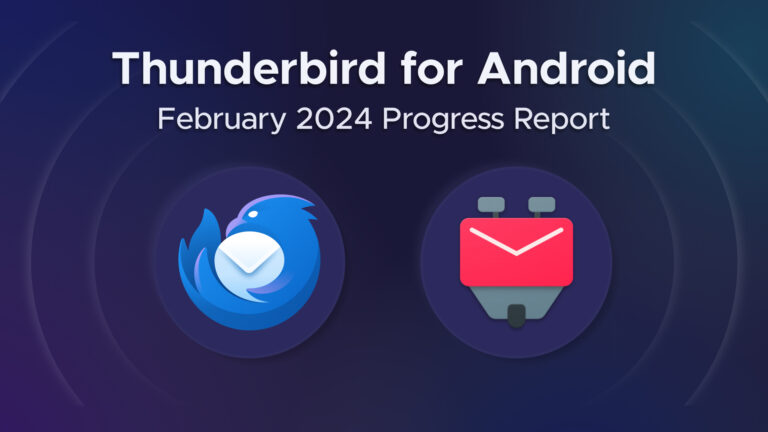
Welcome to a new report on the progress of transforming K-9 Mail into Thunderbird for Android. I hope you’ve enjoyed the extra day in February. We certainly did and used this opportunity to release a new stable version on February 29.
If you’re new to this series or the unusually long February made you forget what happened the previous month, you might want to check out January’s progress report.
New stable release
We spent most of our time in February getting ready for a new stable release – K-9 Mail 6.800. That mostly meant fixing bugs and usability issues reported by beta testers. Thanks to everyone who tested the app and reported bugs 
Read all about the new release in our blog post Towards Thunderbird for Android – K-9 Mail 6.800 Simplifies Adding Email Accounts.
What’s next?
With the new account setup being mostly done, we’ll concentrate on the following two areas.
Material 3
The question of whether to update the user interface to match the design used by the latest Android version seems to have always split the K-9 Mail user base. One group prefers that we work on adding new features instead. The other group wants their email app of choice to look similar to the apps that ship with Android.
Never updating the user interface to the latest design is not really an option. At some point all third-party libraries we’re using will only support the latest platform design. Not updating those libraries is also not an option because Android itself is constantly changing and requires app/library updates just to keep existing functionality working.
I think we found a good balance by not being the first ones to update to Material 3. By now a lot of other app developers have done so and countless bugs related to Material 3 have been found and fixed. So it’s a good time for us to start switching to Android’s latest design system now.
We’re currently still in a research phase to figure out what parts of the app need changing. Once that’s done, we’ll change the base theme and fix up the app screen by screen. You will be able to follow along by becoming a beta tester and installing K-9 Mail 6.9xx beta versions once those become available.
Android 14 compatibility
K-9 Mail is affected by a couple of changes that were introduced with Android 14. We’ve started to look into which parts of the app need to be updated to be able to target Android 14.
We’ve already identified these:
- Schedule exact alarms are denied by default – For some reason Google decided to also apply this change to apps targeting Android 13. We already mentioned this in our November/December 2023 progress report in the section “Push Not Working On Android 14”.
- Restrictions to implicit and pending intents – This affects the way we communicate with the crypto provider app (OpenKeychain) when using OpenPGP.
Our current plan is to include the necessary changes in updates to the K-9 Mail 6.8xx line.
Community Contributions
- S Tanveer Hussain submitted a pull request to update the information about third-party libraries in K-9 Mail’s About screen (#7601)
- GitHub user LorenzHo provided a patch to not focus the recipient input field when the Compose screen was opened using a mailto: URI (#7623). Unfortunately, this change had to be backed out later because of unintended side effects. But we’re hopeful a modified version of this change will make it into the app soon.
Thank you for your contributions!
Releases
In February 2024 we published a new stable release:
- K-9 Mail v6.800 (2024-02-29)
… and the following beta versions:
- K-9 Mail v6.715 (beta) (2024-02-01)
- K-9 Mail v6.716 (beta) (2024-02-13)
- K-9 Mail v6.717 (beta) (2024-02-16)
The post Thunderbird for Android / K-9 Mail: February 2024 Progress Report appeared first on The Thunderbird Blog.
]]>The post Towards Thunderbird for Android – K-9 Mail 6.800 Simplifies Adding Email Accounts appeared first on The Thunderbird Blog.
]]>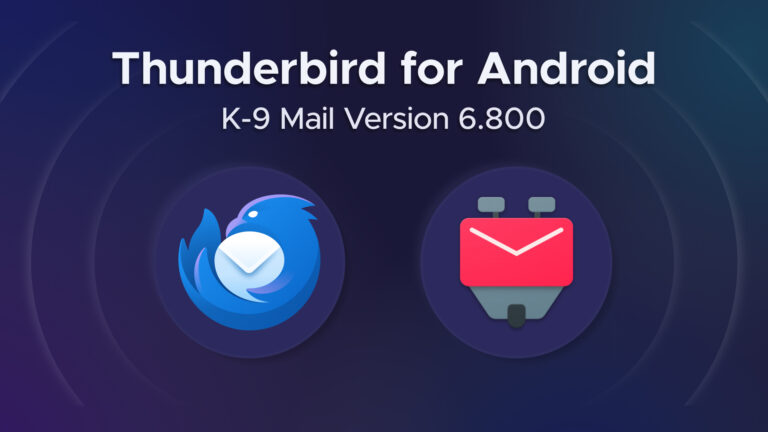
We’re happy to announce the release of K-9 Mail 6.800. The main goal of this version is to make it easier for you to add your email accounts to the app.
With another item crossed off the list, this brings us one step closer towards Thunderbird for Android.
New account setup
Setting up an email account in K-9 Mail is something many new users have struggled with in the past. That’s mainly because automatic setup was only supported for a handful of large email providers. If you had an email account with another email provider, you had to manually enter the incoming and outgoing server settings. But finding the correct server settings can be challenging.
So we set out to improve the setup experience. Since this part of the app was quite old and had a couple of other problems, we used this opportunity to rewrite the whole account setup component. This turned out to be more work than originally anticipated. But we’re quite happy with the result.
Let’s have a brief look at the steps involved in setting up a new account.
1. Enter email address
To get the process started, all you have to do is enter the email address of the account you want to set up in K-9 Mail.
2. Provide login credentials
After tapping the Next button, the app will use Thunderbird’s Autoconfig mechanism to try to find the appropriate incoming and outgoing server settings. Then you’ll be asked to provide a password or use the web login flow, depending on the email provider.
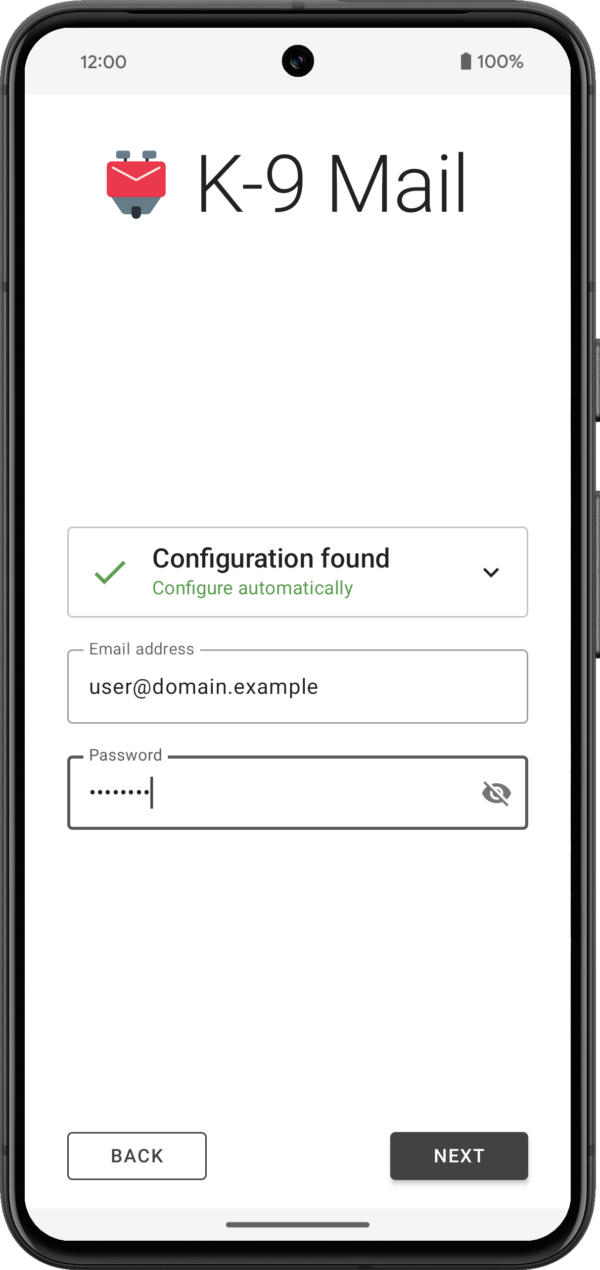
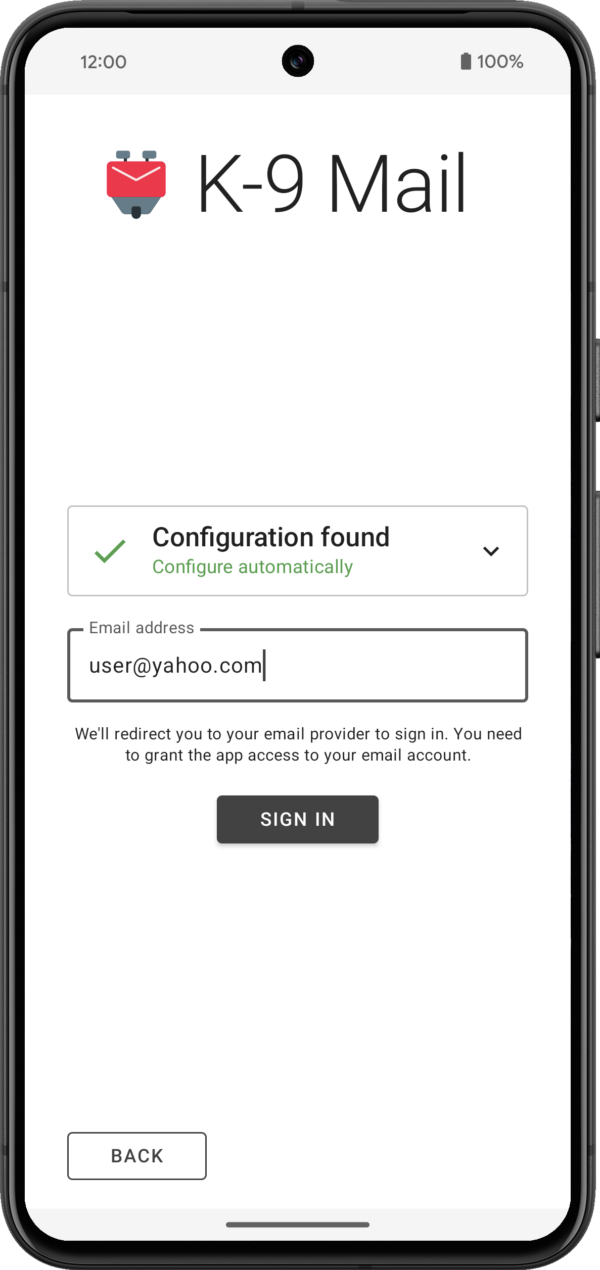
The app will then try to log in to the incoming and outgoing server using the provided credentials.
3. Provide some basic information about the account
If your login credentials check out, you’ll be asked to provide your name for outgoing messages. For all the other inputs you can go with the defaults. All settings can be changed later, once an account has been set up.
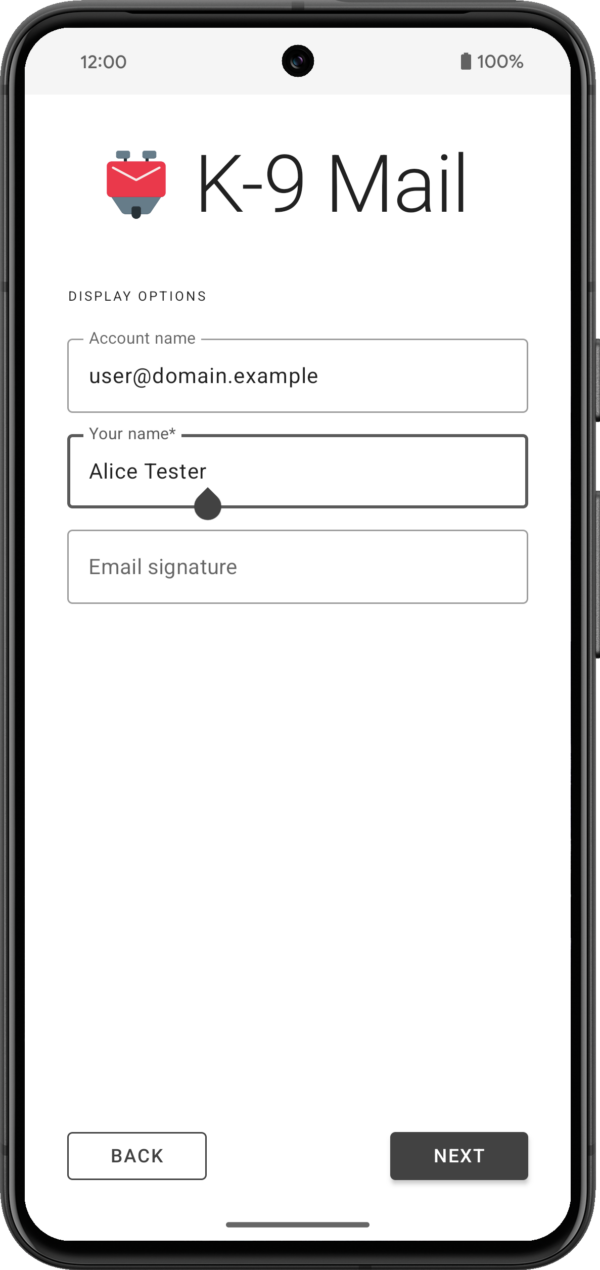
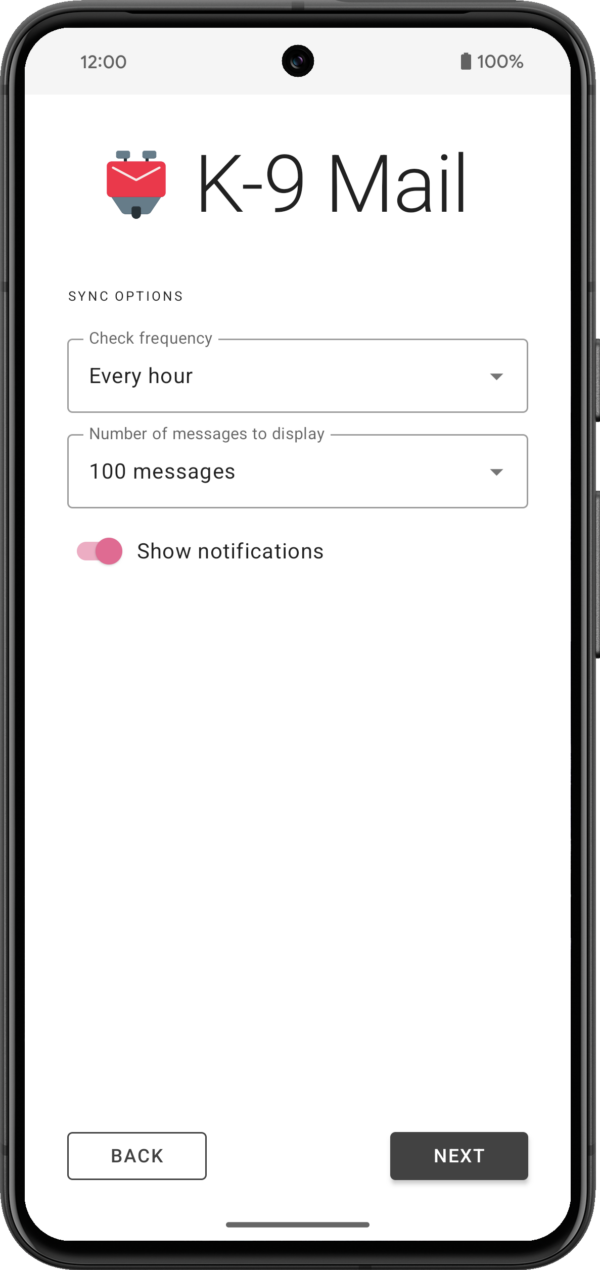
If everything goes well, that’s all it takes to set up an account.
Of course there’s still cases where the app won’t be able to automatically find a configuration and the user will be asked to manually provide the incoming and outgoing server settings. But we’ll be working with email providers to hopefully reduce the number of times this happens.
What else is new?
While the account setup rewrite was our main development focus, we’ve also made a couple of smaller changes and bug fixes. You can find a list of the most notable ones below.
Improvements and behavior changes
- Made it harder to accidentally trigger swipe actions in the message list screen
- IMAP: Added support for sending the ID command (that is required by some email providers)
- Improved screen reader experience in various places
- Improved display of some HTML messages
- Changed background color in message view and compose screens when using dark theme
- Adding to contacts should now allow you again to add the email address to an existing contact
- Added image handling within the context menu for hyperlinks
- A URI pasted when composing a message will now be surrounded by angle brackets
- Don’t use nickname as display name when auto-completing recipient using the nickname
- Changed compose icon in the message list widget to match the icon inside the app
- Don’t attempt to open file: URIs in an email; tapping such a link will now copy the URL to the clipboard instead
- Added option to return to the message list after marking a message as unread in the message view
- Combined settings “Return to list after delete” and “Show next message after delete” into “After deleting or moving a message”
- Moved “Show only subscribed folders” setting to “Folders” section
- Added copy action to recipient dropdown in compose screen (to work around missing drag & drop functionality)
- Simplified the app icon so it can be a vector drawable
- Added support for the IMAP MOVE extension
Bug fixes
- Fixed bug where account name wasn’t displayed in the message view when it should
- Fixed bugs with importing and exporting identities
- The app will no longer ask to save a draft when no changes have been made to an existing draft message
- Fixed bug where “Cannot connect to crypto provider” was displayed when the problem wasn’t the crypto provider
- Fixed a crash caused by an interaction with OpenKeychain 6.0.0
- Fixed inconsistent behavior when replying to messages
- Fixed display issue with recipients in message view screen
- Fixed display issues when rendering a message/rfc822 inline part
- Fixed display issue when removing an account
- Fixed notification sounds on WearOS devices
- Fixed the app so it runs on devices that don’t support home screen widgets
Other changes
- Removed Hebrew and Korean translations because of how incomplete they were; volunteer translators welcome!
Known issues
- A fresh app install on Android 14 will be missing the “alarms & reminders” permission required for Push to work. Please allow setting alarms and reminders in Android’s app settings under Alarms & reminders.
- Some software keyboards automatically capitalize words when entering the email address in the first account setup screen.
- When a password containing line breaks is pasted during account setup, these line breaks are neither ignored nor flagged as an error. This will most likely lead to an authentication error when checking server settings.
Where To Get K-9 Mail Version 6.800
Version 6.800 has started gradually rolling out. As always, you can get it on the following platforms:
GitHub | F-Droid | Play Store
(Note that the release will gradually roll out on the Google Play Store, and should appear shortly on F-Droid, so please be patient if it doesn’t automatically update.)
The post Towards Thunderbird for Android – K-9 Mail 6.800 Simplifies Adding Email Accounts appeared first on The Thunderbird Blog.
]]>The post Thunderbird Monthly Development Digest: February 2024 appeared first on The Thunderbird Blog.
]]>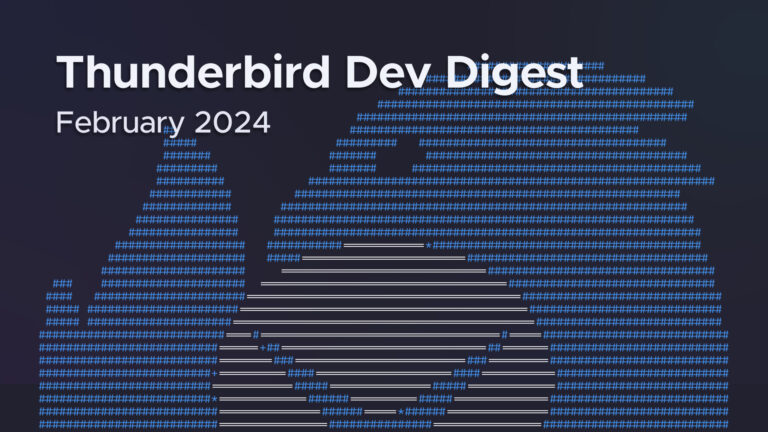
Hello Thunderbird Community! I can’t believe it’s already the end of February. Time goes by very fast and it seems that there’s never enough time to do all the things that you set your mind to. Nonetheless, it’s that time of the month again for a juicy and hopefully interesting Thunderbird Development Digest.
If this is your first time reading our monthly Dev Digest, these are short posts to give our community visibility into features and updates being planned for Thunderbird, as well as progress reports on work that’s in the early stages of development.
Let’s jump right into it, because there’s a lot to get excited about!
Rust and Exchange
Things are moving steadily on this front. Maybe not as fast as we would like, but we’re handling a complicated implementation and we’re adding a new protocol for the first time in more than a decade, so some friction is to be expected.
Nonetheless, you can start following the progress in our Thundercell repository. We’re using this repo to temporarily “park” crates and other libraries we’re aiming to vendor inside Thunderbird.
We’re aiming at reaching an alpha state where we can land in Thunderbird later next month and start asking for user feedback on Daily.
Mozilla Account + Thunderbird Sync
Things are moving forward on this front as well. We’re currently in the process of setting up our own SyncServer and TokenStorage in order to allow users to log in with their Mozilla Account but sync the Thunderbird data in an independent location from the Firefox data. This gives us an extra layer of security as it will prevent an app from accessing the other app’s data and vice versa.
In case you didn’t know, you can already use a Mozilla account and Sync on Daily, but this only works with a staging server and you’ll need an alternate Mozilla account for testing. There are a couple of known bugs but overall things seem to be working properly. Once we switch to our storage server, we will expose this feature more and enable it on Beta for everyone to test.
Oh, Snap!
Our continuous efforts to own our packages and distribution methods is moving forward with the internal creation of a Snap package. (For background, last year we took ownership of the Thunderbird Flatpak.)
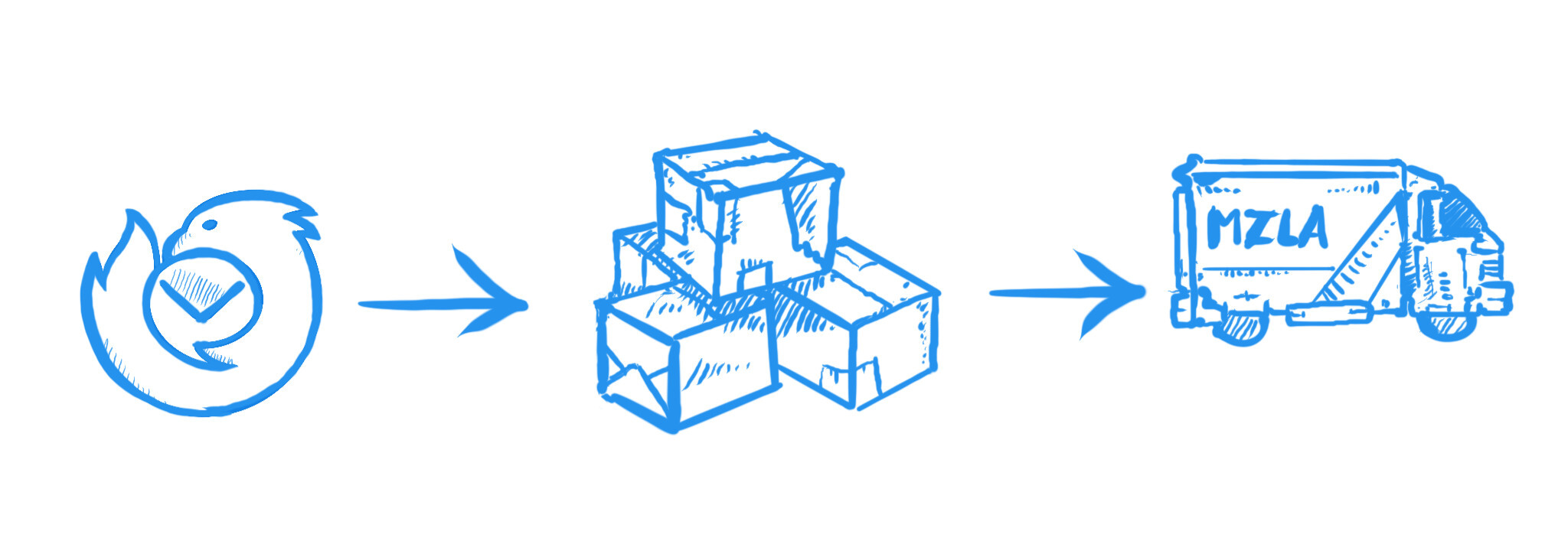
We’re currently internally testing the Beta and things seem to work accordingly. We will announce it publicly when it’s available from the Snap Store, with the objective of offering both Stable and Beta channels.
We’re exploring the possibility of also offering a Daily channel, but that’s a bit more complicated and we will need more time to make sure it’s doable and automated, so stay tuned.
As usual, if you want to see things as they land you can always check the pushlog and try running daily, which would be immensely helpful for catching bugs early.
See ya next month,
Alessandro Castellani (he, him)
Director of Product Engineering
If you’re interested in joining the technical discussion around Thunderbird development, consider joining one or several of our mailing list groups here.
The post Thunderbird Monthly Development Digest: February 2024 appeared first on The Thunderbird Blog.
]]>The post Thunderbird for Android / K-9 Mail: January 2024 Progress Report appeared first on The Thunderbird Blog.
]]>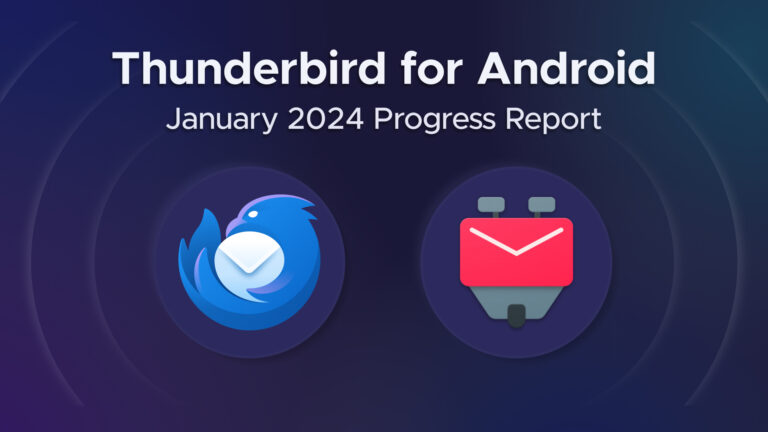
A new year, a new progress report! Learn what we did in January on our journey to transform K-9 Mail into Thunderbird for Android. If you’re new here or you forgot where we left off last year, check out the previous progress report.
Account setup
In January most of our work went into polishing the user interface and user experience of the new and improved account setup. However, there was still one feature missing that we really wanted to get in there: the ability to configure special folders.
Special folders
K-9 Mail supports the following special folders:
- Archive: When configured, an Archive action will be available that moves a message to the designated archive folder.
- Drafts: When configured, the Save as draft action will be available in the compose screen.
- Sent: Messages that have been successfully submitted to the outgoing server will be uploaded to this folder. If this special folder is set to None, the app won’t save a copy of sent messages.
Note: There’s also the setting Upload sent messages that can be disabled to prevent sent messages from being uploaded, e.g. if your email provider automatically saves a copy of outgoing messages. - Spam: When configured, a Spam action will be available that moves a message to the designated spam folder. (Please note that K-9 Mail currently does not include spam detection. So besides moving the message, this doesn’t do anything on its own. However, moving a message to and from the spam folder often trains the server-side spam filter available at many email providers.)
- Trash: When configured, deleting a message in the app will move it to the designated trash folder. If the special folder is set to None, emails are deleted permanently right away.
In the distant past, K-9 Mail was simply using common names for these folders and created them on the server if they didn’t exist yet. But some email clients were using different names. And so a user could end up with e.g. multiple folders for sent messages. Of course there was an option to manually change the special folder assignment. But usually people only noticed when it was too late and the new folder already contained a couple of messages. Manually cleaning this up and making sure all email clients are configured to use the same folders is not fun.
To solve this problem, RFC 6154 introduced the SPECIAL-USE IMAP extension. That’s a mechanism to save this special folder mapping on an IMAP server. Having this information on the server means all email clients can simply fetch that mapping and then there should be no disagreement on e.g. which folder is used for sent messages.
Unfortunately, there’s still some email providers that don’t support this extension. There’s also cases where the server supports the feature, but none of the special roles are assigned to any folder. When K-9 Mail added support for the SPECIAL-USE extension, it simply used the data from the server, even if it meant not using any special folders. Unfortunately, that could be even worse than creating new folders, because you might end up e.g. not having a copy of sent messages.
So now the app is displaying a screen to ask the user to assign special folders when setting up an account.
This screen is skipped if the app receives a full mapping from the server, i.e. all special roles are assigned to a folder. Of course you’ll still be able to change the special folder assignment after the account has been created.
Splitting account options
We split what used to be the account options screen into two different screens: display options and sync options.
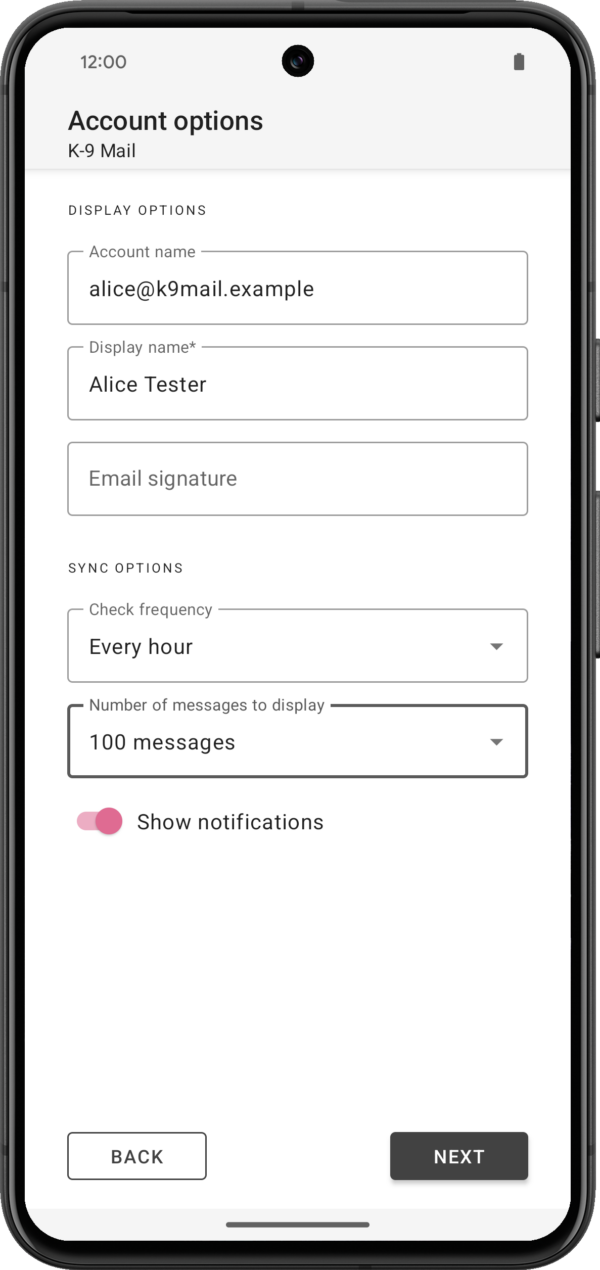
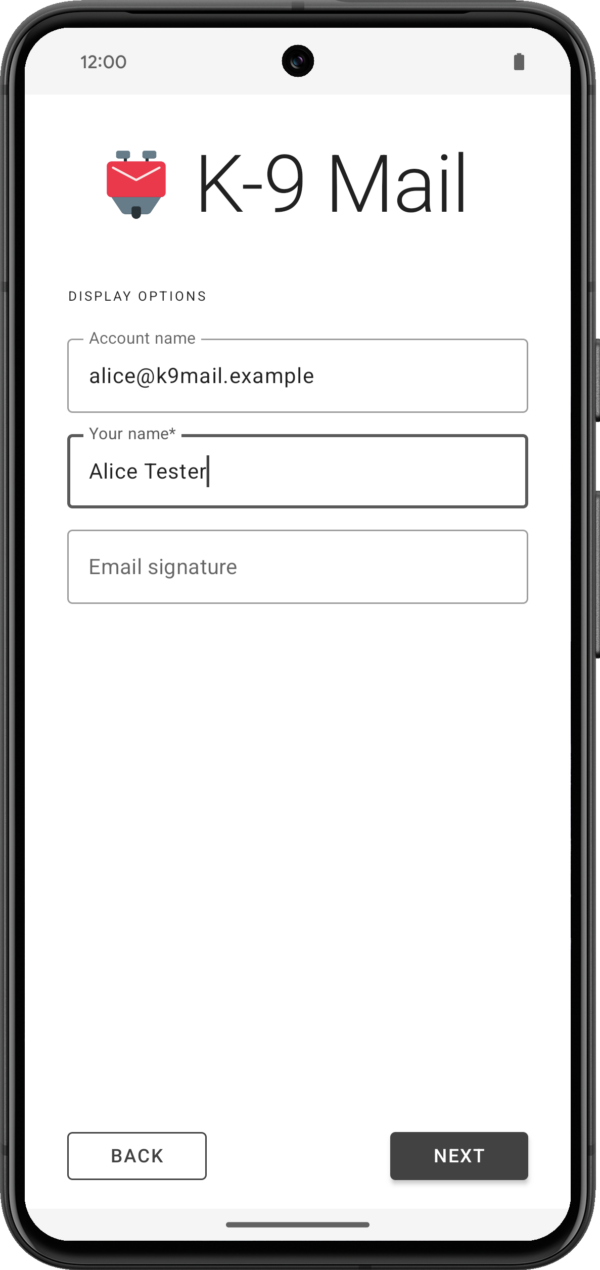
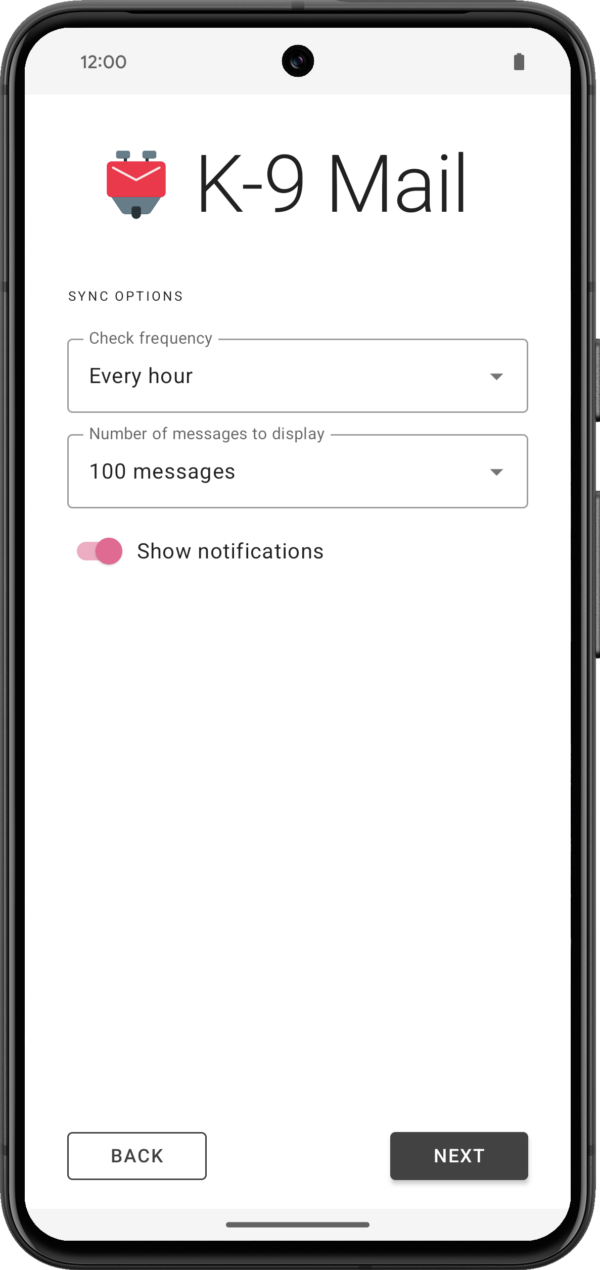
Improved server certificate error screen
The screen to display server certificate errors during account setup has received an overhaul.
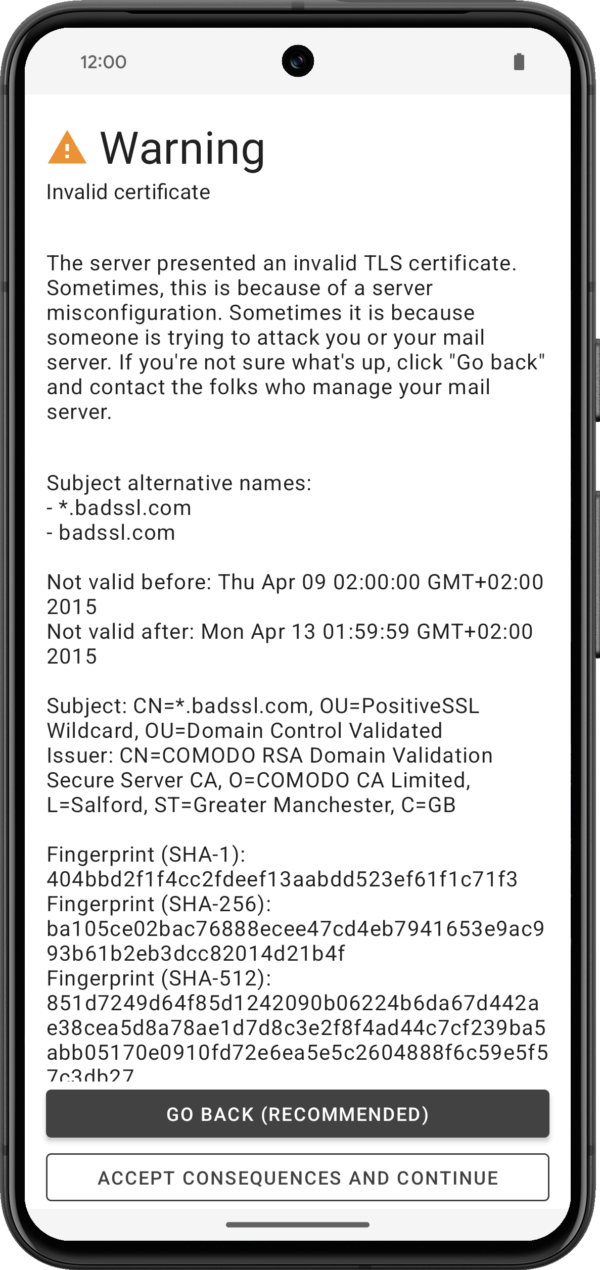
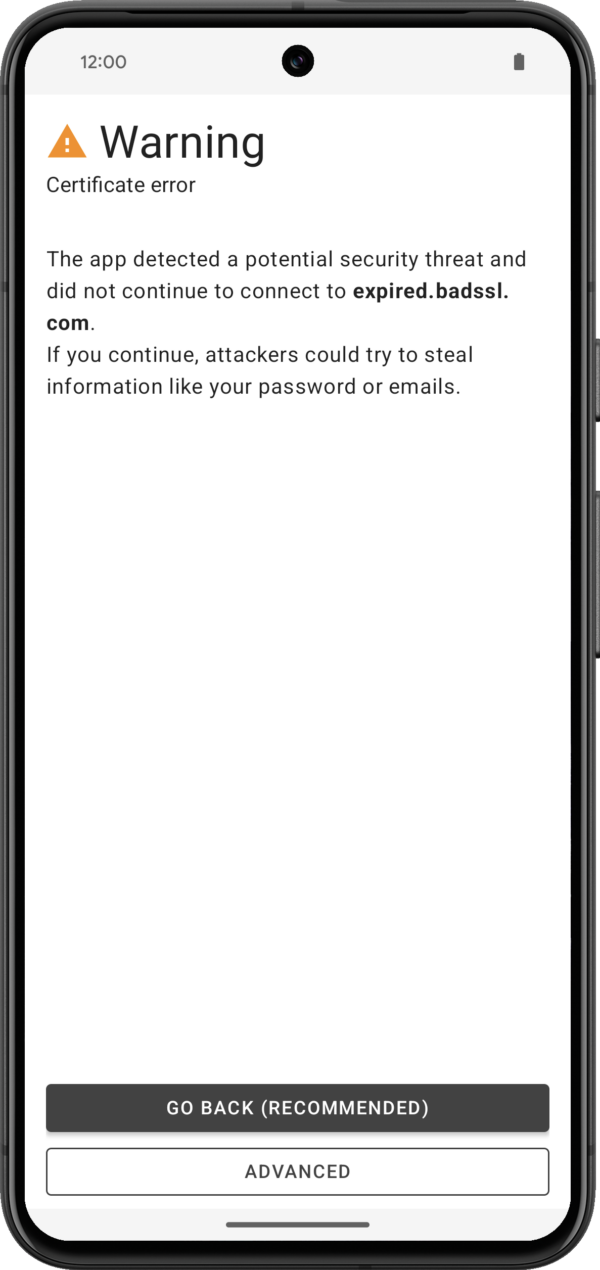
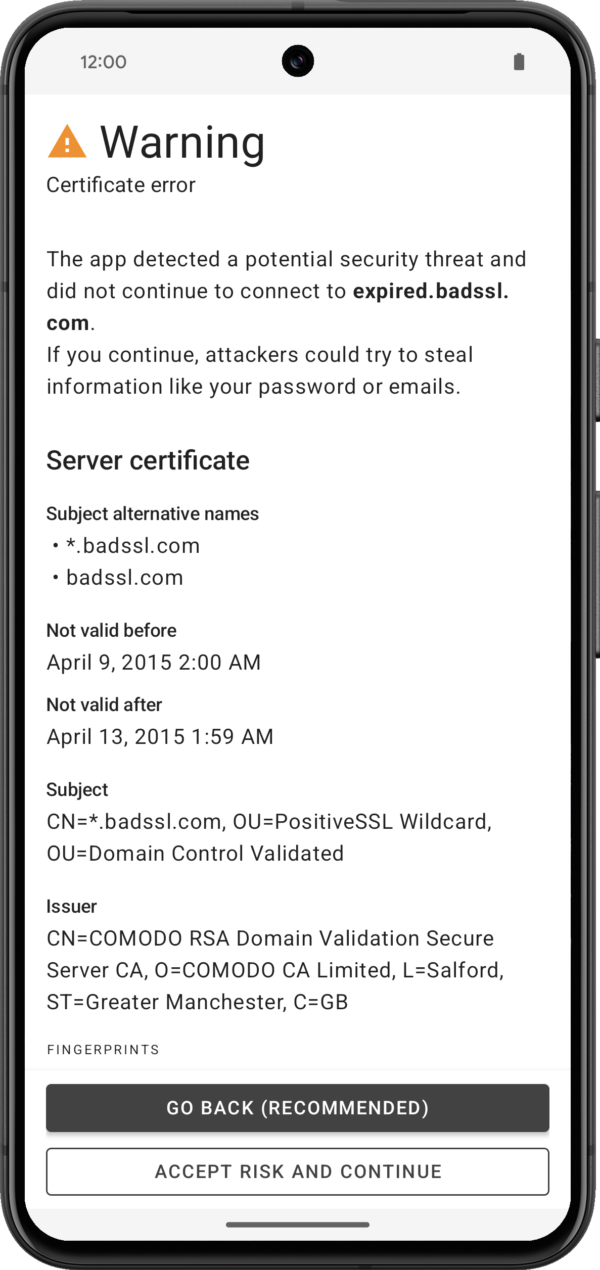
Polishing the user experience
With the special folders screen done, we’re now feature complete. So we took a step back to look at the whole experience of setting up an account. And we’ve found several areas where we could improve the app.
Here’s an (incomplete) list of things we’ve changed:
- We reduced the font weight of the header text to be less distracting.
- In some parts of the flow there’s enough content on the screen that a user has to scroll. The area between the header and the navigation buttons at the bottom can be very small depending on the device size. So we included the header in the scrollable area to improve the experience on devices with a small screen.
- There are a couple of transient screens, e.g. when checking server settings. Previously the app first displayed a progress indicator when checking server settings, then a success message for 2 seconds, but allowed the user to skip this screen by pressing the Next button. This turned out to be annoying and confusing. Annoying because the user has to wait longer than necessary; and confusing because it looked like user input was required, but by the time the user realizes that, the app will have most likely switched to the next screen automatically.
We updated these transient screens to always show a progress indicator and hide the Next button, so users know something is happening and there’s currently nothing for them to do. - We also fixed a couple of smaller issues, like the inbox not being synchronized during setup when an account was configured for manual synchronization.
Fixing bugs
Some of the more interesting bugs we fixed in January:
- When rotating the screen while selecting a notification sound in settings, some of the notification settings were accidentally disabled (#7468).
- When importing settings a preview lines value of 0 was ignored and the default of 2 was used instead (#7493).
- When viewing a message and long-pressing an image that is also a link, only menu items relevant for images were displayed, but not ones relevant for links (#7457).
- Opening an attachment from K-9 Mail’s message view in an external app and then sharing the content to K-9 Mail opened the compose screen for a new message but didn’t add an attachment (#7557).
Community Contributions
new-sashok724 fixed a bug that prevented the use of IP addresses for incoming or outgoing servers (#7483).
Thank you 
Releases
- K-9 Mail v6.714 (beta) (2024-01-04)
If you want to help shape Thunderbird for Android, become a beta tester and provide feedback on new features while they are still in development.
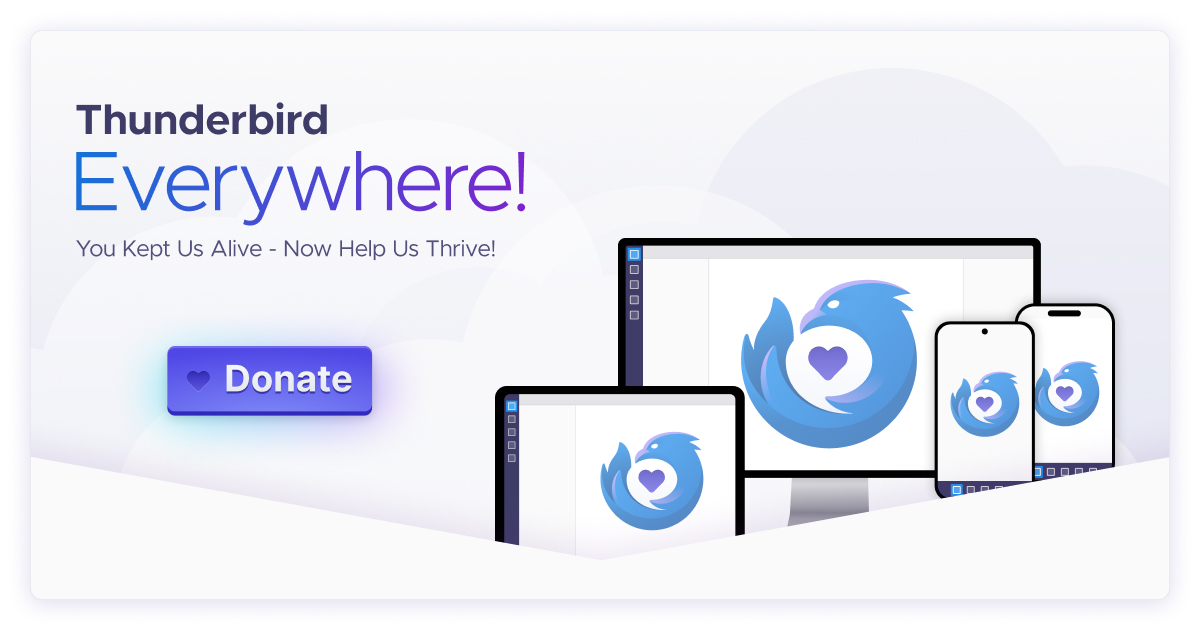
The post Thunderbird for Android / K-9 Mail: January 2024 Progress Report appeared first on The Thunderbird Blog.
]]>Our guest for this month's Thunderbird Community Office Hours is John Bieling, who is the person responsible for Thunderbird's add-on component.
The post February 2024 Community Office Hours: All About Add-Ons! appeared first on The Thunderbird Blog.
]]>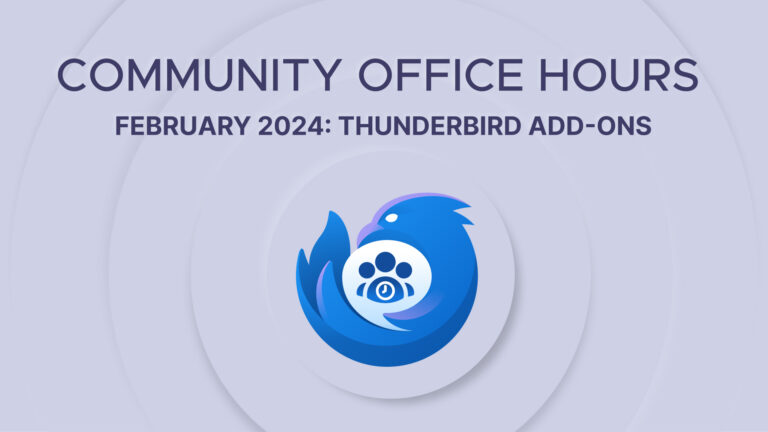
The topic for this month’s Thunderbird Community Office Hours takes a short break from the core of Thunderbird and takes us into the world of extensions we call Add-ons. These allow our users to add features and options beyond the customization already available in Thunderbird by default.
UPDATE: Video Replay Now Available
February Office Hours Topic: Add-ons
We want it to be easy to make Thunderbird yours, and so does our community. The Thunderbird Add-on page shows the power of community-driven extensions. There are Add-ons for everything, from themes to integrations, that add even more customization to Thunderbird.
Our guest for this month’s Thunderbird Community Office Hours is John Bieling, who is the person responsible for Thunderbird’s add-on component. This includes the WebExtension APIs, add-on documentation, as well as community support. He hosts a frequent open call about Add-on development and is welcoming to any developers seeking help. Come join us to learn about Add-on development and meet a key developer in the space.
Catch Up On Last Month’s Thunderbird Community Office Hours
Before you join us on February 22 at 18:00 UTC, watch last month’s office hours with UX Engineer Elizabeth Mitchell. We had some great discussion around the Message Context Menu and testing beta and daily images. Watch the video and read more about our guest at last month’s blog post.
Join Us On Zoom
(Yes, we’re still on Zoom for now, but a Jitsi server for future office hours is in the works!)
When: February 22 at 18:00 UTC (10am PST / 1pm EST / 7pm CET)
Direct URL To Join: https://mozilla.zoom.us/j/97506306527
Meeting ID: 97506306527
Password: 319424
Dial by your location:
- +1 646 518 9805 US (New York)
- +1 669 219 2599 US (San Jose)
- +1 647 558 0588 Canada
- +33 1 7095 0103 France
- +49 69 7104 9922 Germany
- +44 330 088 5830 United Kingdom
- Find your local number: https://mozilla.zoom.us/u/adkUNXc0FO
The call will be recorded and this post will be updated with a link to the recording afterwards.

The post February 2024 Community Office Hours: All About Add-Ons! appeared first on The Thunderbird Blog.
]]>The post Thunderbird In 2023: The Milestones and The Lessons We Learned appeared first on The Thunderbird Blog.
]]>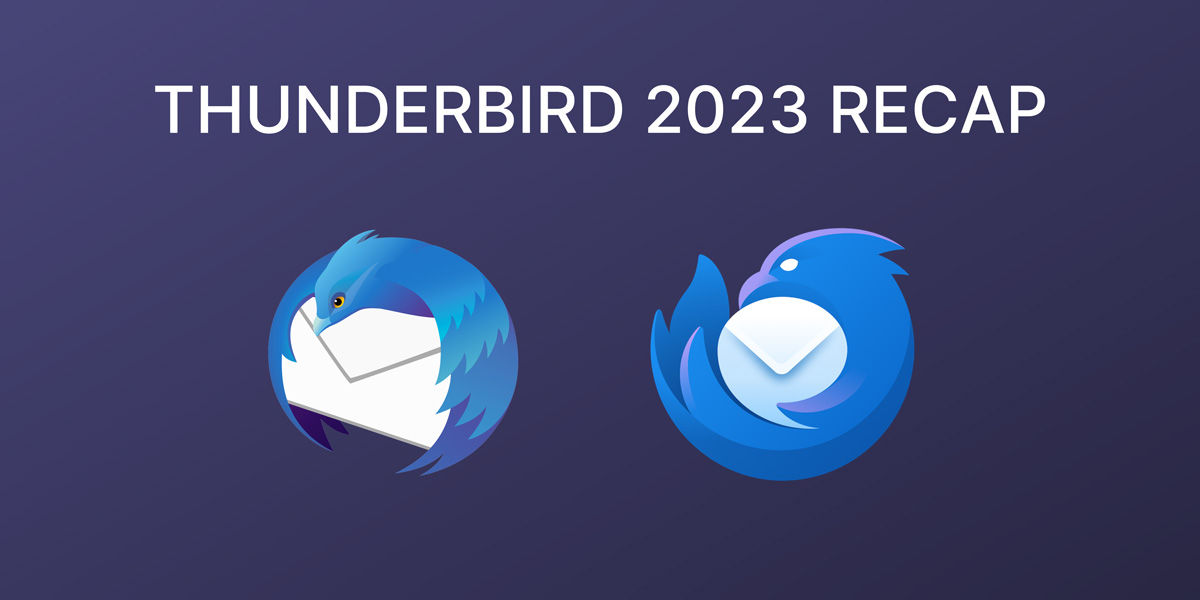
The Thunderbird Project enjoyed a fantastic 2023. From my point of view – as someone who regularly engages with both the community and our team on a daily basis – the past year brought a renewed sense of purpose, sustainability, and excitement to Thunderbird. Let’s talk about a few of the awesome milestones Thunderbird achieved, but let’s also discuss where we stumbled and what lessons we learned along the way.
Our 2023 Milestones
The biggest milestone of 2023 was Thunderbird 115 “Supernova.” This release marked the first step towards a more flexible, reliable, and customizable Thunderbird that will accommodate different needs and workflows. Work has been long underway to modernize huge amounts of old code, with the aim of modernizing Thunderbird to deliver new features even faster. The “Supernova” release represented the first fruits of those efforts, and there’s a lot more in the pipeline!
Alongside Supernova came a brand new Thunderbird logo to signal the revitalization of the project. We finally (even a bit reluctantly) said goodbye to our beloved “wig on an envelope” and ushered in a new era of Thunderbird with a refreshed, redesigned logo. But it was important to honor our roots, which is why we hired Jon Hicks – the designer of the original Firefox and Thunderbird logos – to help us bring it to life. (Now that you’ve all been living with it for the last several months, has it grown on you? Let us know in the comments of this post!)

One 2023 milestone that deserves more attention is that we hired a dedicated User Support Specialist! Roland Tanglao has been working enthusiastically towards removing “documentation debt” and updating the 100s of Thunderbird support articles at support.mozilla.org (which you’ll see us refer to internally as “SUMO”). Beyond that, he keeps a watchful eye on our Matrix community support channel for emerging issues, and is in the forums answering as many help questions as humanly possible, alongside our amazing support volunteers. In a nutshell, Roland is doing everything he can to improve the experience of asking for and receiving support, modernize existing documentation, and create new guides and articles that make using Thunderbird easier.
These are some – not all – of our accomplishments from last year. But it’s time to shift focus to where we stumbled, and how we’ll do better.
The Lessons We Learned In 2023
In 2023, we failed to finish some of the great features we wanted to bring to Thunderbird, including Sync and Account Hub (both of which, however, are still in development). We also missed our target release window for Thunderbird on Android, after deciding it was worth the extra development time to add the kind of functionality and flexibility you expect from Thunderbird software.
Speaking of functionality you expect, we hear you loud and clear: you want Exchange support in Thunderbird. We’ve already done some exploratory work, and have enabled the usage of Rust in Thunderbird. This is a complex topic, but the short version is that this opens the doors for us to start implementing native support for the Exchange protocol. It’s officially on our roadmap!
We also believe our communication with you has fallen short of where it needs to be. There are times when we get so excited about things we’re working on that it seems like marketing hype. In other situations, we have over-promised and under-delivered because these projects haven’t been extensively scoped out.
We’re beginning to solve the latter issue with the recent hiring of Kelly McSweeney, Senior Technical PM. She joined our team late last year and brings 20 years of valuable experience to Thunderbird. In a nutshell, Kelly is building processes and tools to accurately gauge how long development time will realistically take, from extensive projects to the tiniest tasks. Basically, she’s getting us very organized and making things run much more efficiently! This not only means smoother operations across the organization, but also clearer communication with you going forward.
And communication is our biggest area of opportunity right now, specifically with our global Thunderbird community. We haven’t been as transparent as an open source project should be, nor have we discussed our future plans frequently enough. We’ve had several meetings about this over the past few weeks, and we’re taking immediate steps to do better.
To begin with, you’ll start seeing monthly Developer Digests like this one from Alex, aimed at giving you a closer look at the work currently being planned. We’re also increasing our activity on the Thunderbird mailing lists, where you can give us direct feedback about future improvements and features.
In 2024 you can also look forward to monthly community Office Hours sessions. This is where you can get some face time (or just voice time) with our team, and watch presentations about upcoming features and improvements by the developer(s) working on them.
One last thing: In 2023, Thunderbird’s Marketing & Communications team consisted of myself and Wayne Mery. This year Wayne and I are fortunate to be working alongside new team members Heather Ellsworth, Monica Ayhens-Madon, and Natalia Ivanova. Together, we’re going to work diligently to create more tutorials on the blog, more video guides, and more content to help you get the most out of Thunderbird – with a focus on productivity.
How To Stay Updated
Thank you for being on this journey with us! If you want to get more involved and stay in touch, here are the best places to keep up with what’s happening at Thunderbird:
- We will be more active right here on this blog, so come back once or twice per month to see what’s new.
- If you enjoy the technical bits, want to help test Thunderbird, or you’re part of our contributor community, these mailing lists at Topicbox are ideal.
- Follow us on Mastodon or X/Twitter for more frequent – and fun – updates!
- Join our Thunderbird Community Support room on Matrix if you need some help.

The post Thunderbird In 2023: The Milestones and The Lessons We Learned appeared first on The Thunderbird Blog.
]]>